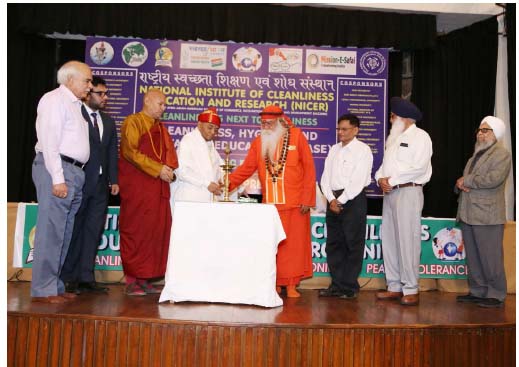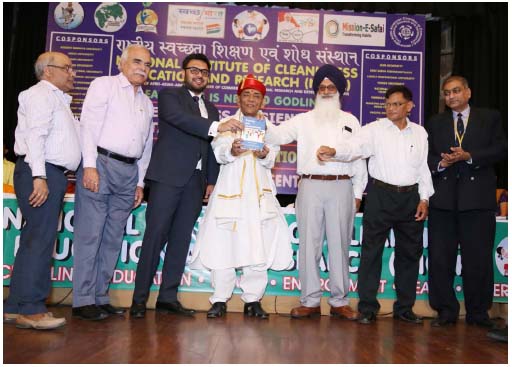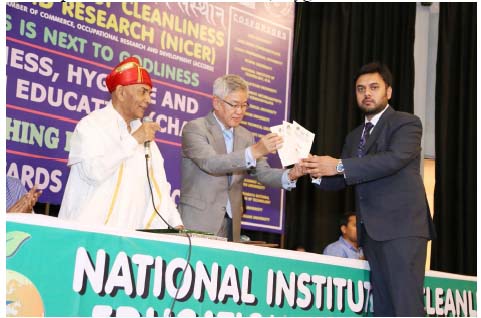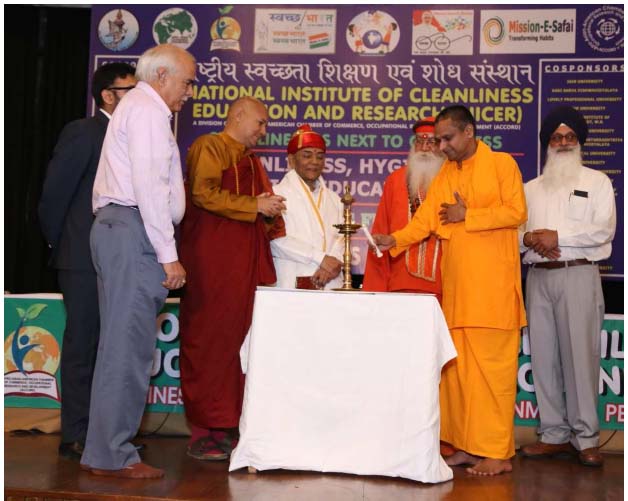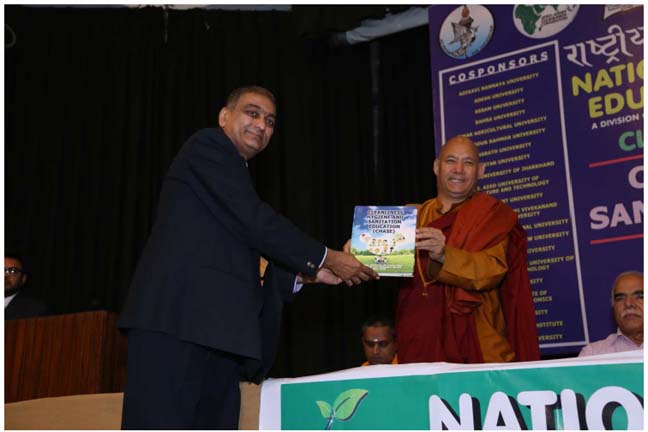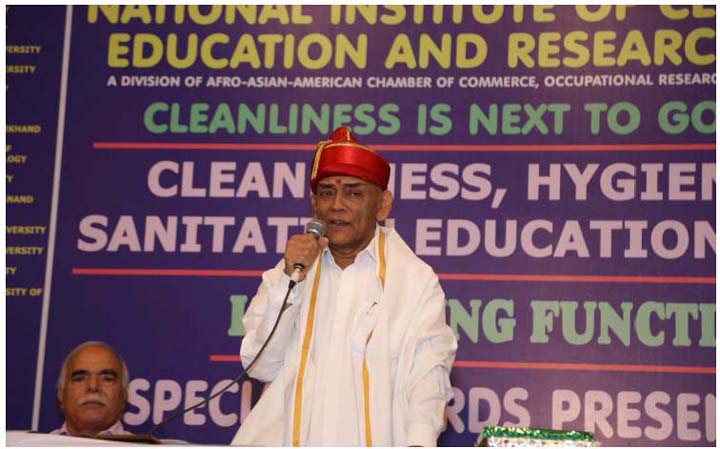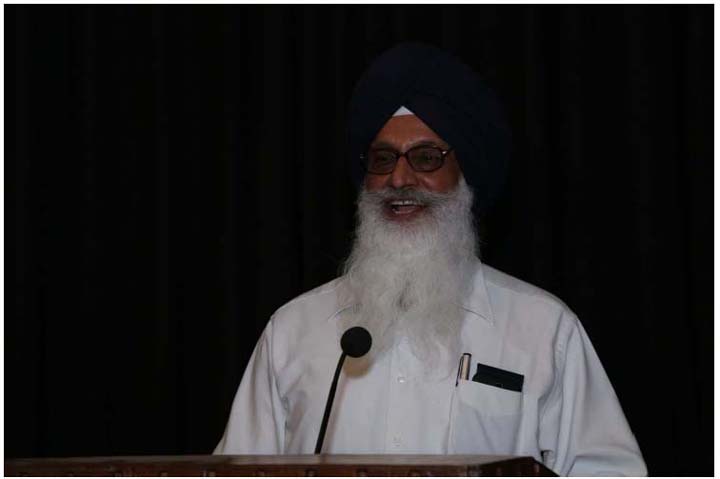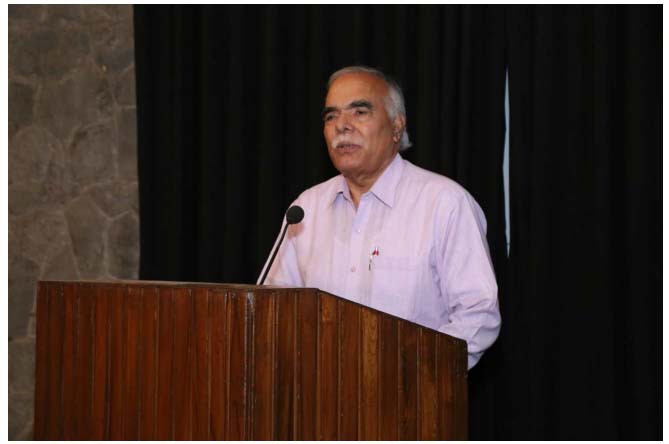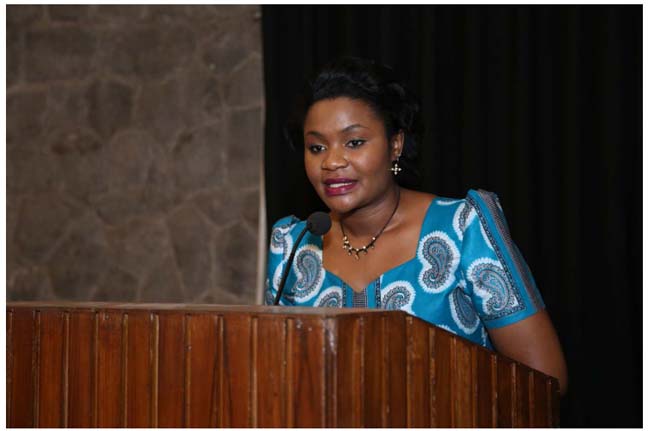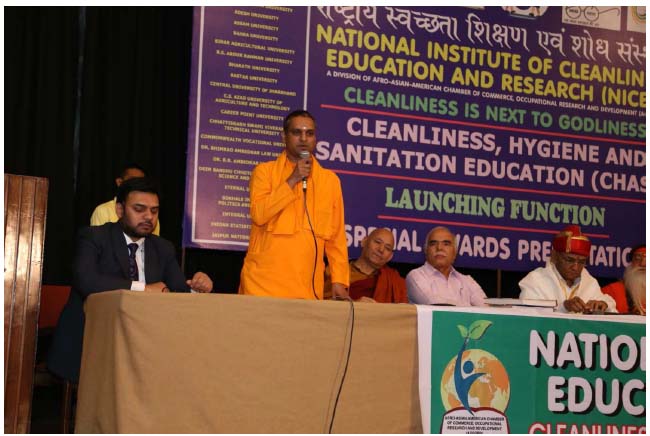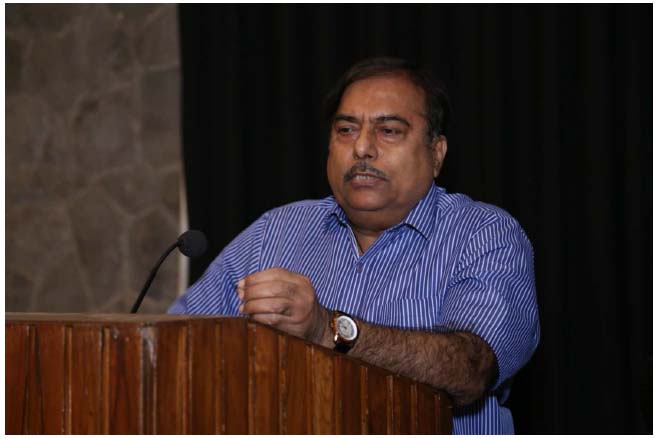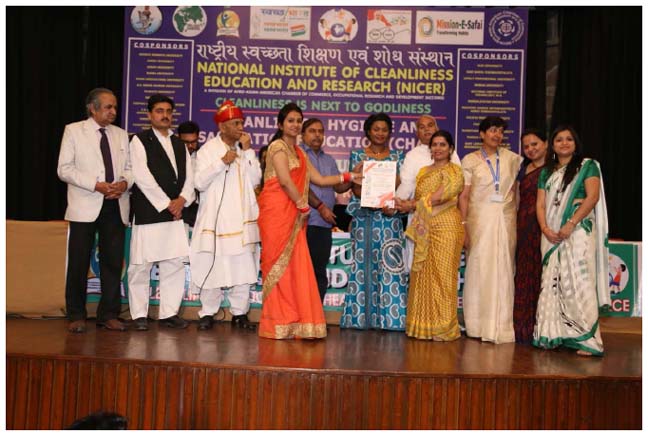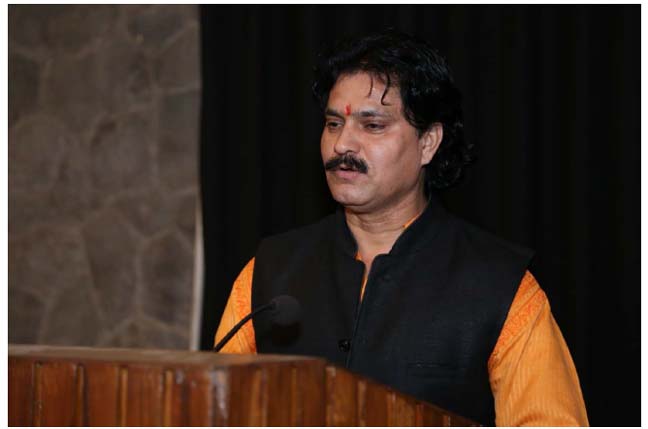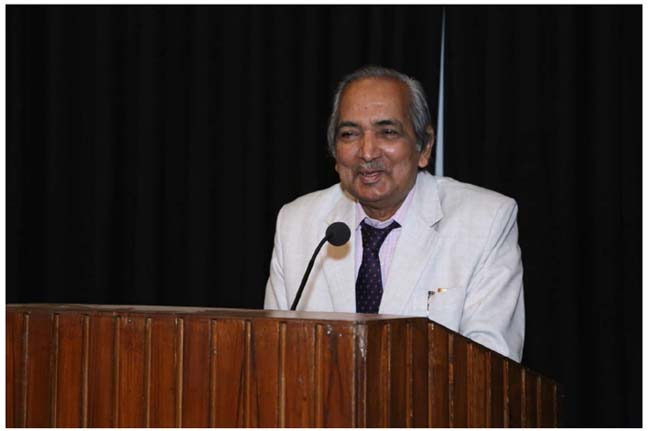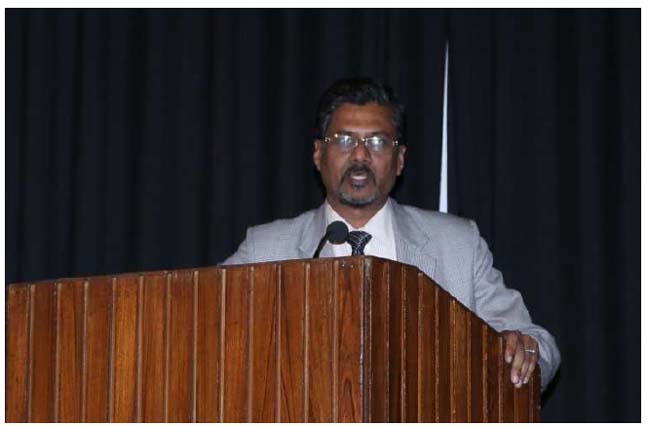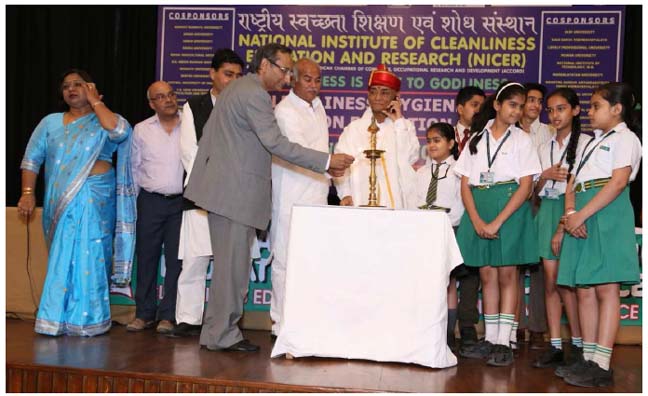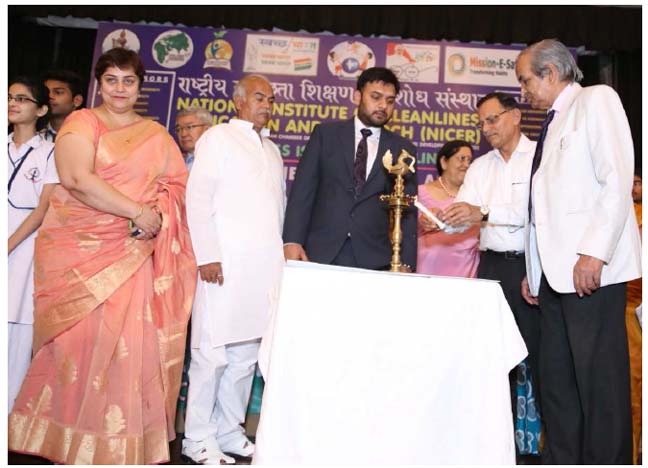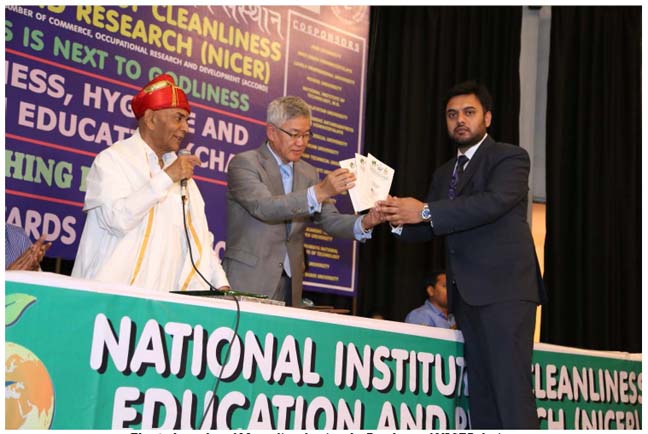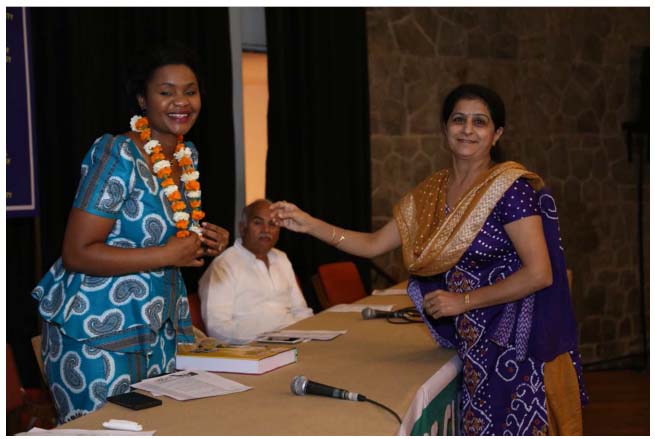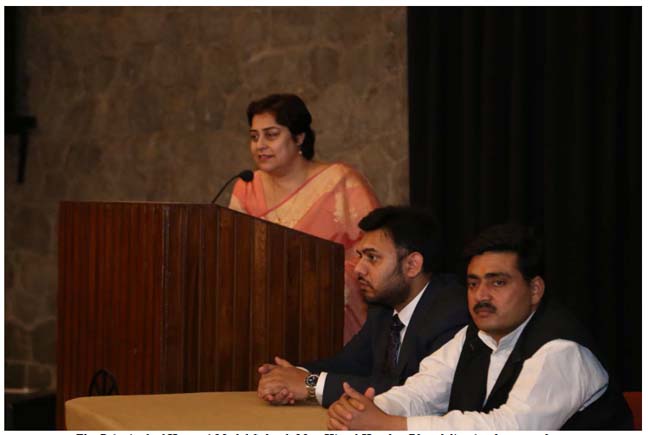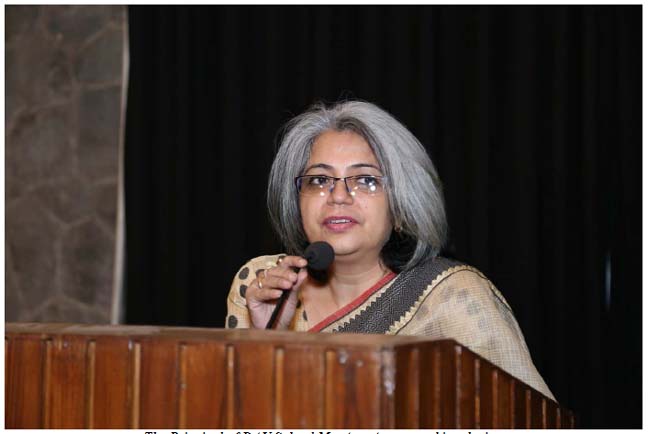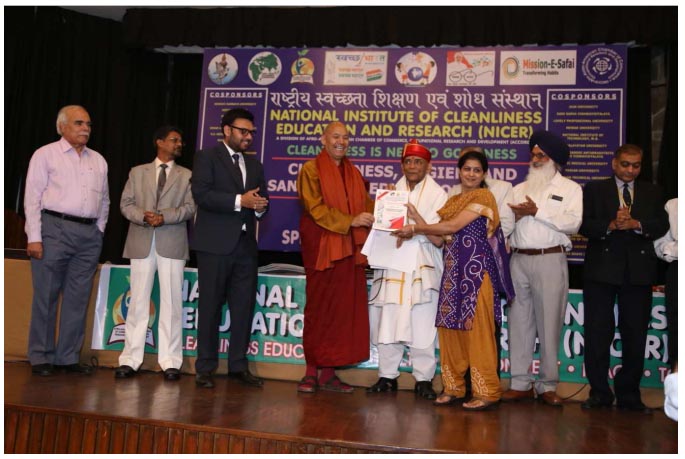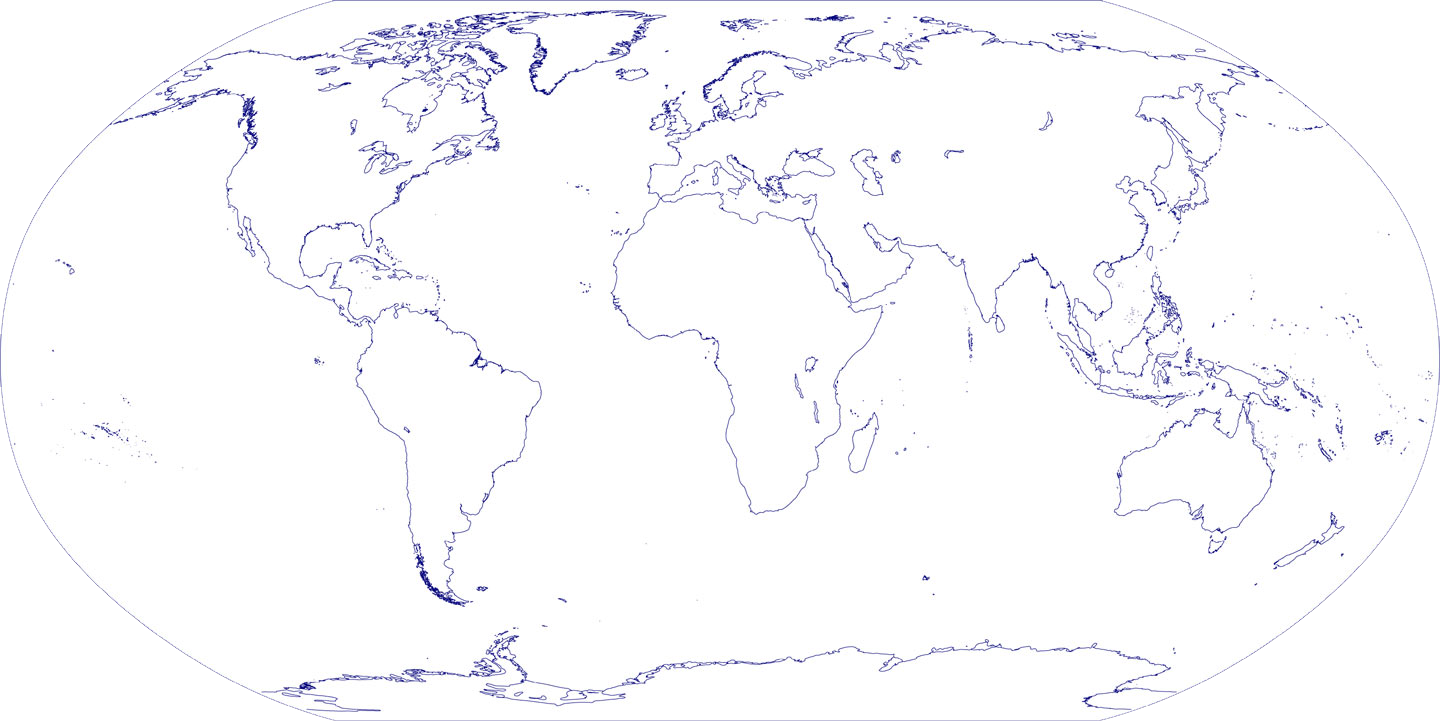INSIST |
 |
 News and Press Release News and Press Release
Internet News Service for India's Social Transformation (INSIST) has been established by leading intellectuals, social scientists, policy makers and educators with a view to propagating news relevant to education and national development. Different types of news, notifications and releases are put on this website. Click any news |
|
|
News and Press Release Cosponsored by more than 50 universities, the National Institute of Cleanliness Education and Research (NICER) launched during the afro-asian cleanliness convention 2016 |
|
|
New Delhi, 22 March 2016 In order to fulfill the aspirations of the Prime Minister of India Narendra Modi and with a view to strengthening the cause of "Swachchh Bharat Abhiyan", the National Institute of Cleanliness Education and Research (NICER) was launched during the Afro-Asian Cleanliness Convention 2016 in the Auditorium of India International Centre, New Delhi in the presence of the delegates from different countries in the Asian and the African regions. Jointly inaugurated by the renowned spiritual leaders namely His Holiness Bhikkhu Sanghasena, President, Mahabodhi International Meditation Centre, Leh, Ladakh, Mahamandaleshwar Swami Pragyananda Ji Maharaj, Patron Pragya Mission International, and His Holiness Swami Padmaprakasha Jnana Thapaswi, Head, Shantigiri Ashram, Delhi in the presence of the Ambassador of Mongolia H.E. Mr. Gonchig Ganbold and the First Secretary (Trade) of the High Commission of the Republic of Malawi Ms. Juliana Somba-Banda, and the Chancellors, Presidents, Vice Chancellors and other dignitaries including Baba Iqbal Singh, Chancellor of Eternal University, Himachal Pradesh and Akal University, Punjab; Prof. M.P. Dube, Vice Chancellor, U.P. Rajarshi Tandon Open University, Allahabad; Prof. Narendra S. Chaudhari, Director, Visveswaraya National Institute of Technology, Nagpur; Prof. M.K. Verma, Vice Chancellor, Chhattisgarh Swami Vivekanand National University, Bhilai; Dr. Harcharan Singh Dhaliwal, Vice Chancellor, Eternal University, Himachal Pradesh; Dr. S.N. Pandey, Vice Chancellor, Indira Gandhi Technological and Medical Sciences University, Arunachal Pradesh; Dr. S.K. Gupta, Vice Chancellor, SunRise University, Rajasthan; and the official Representatives of Mahatma Gandhi Antarrashtriya Hindi Vishwavidyalaya (Central University), Wardha Dr. Mithilesh Kumar and Dr. Shambhu Joshi.
Prominent among the sponsors of the National Institute of Cleanliness Education and Research (NICER) are the Afro-Asian-American Chamber of Commerce, Occupational Research and Development (ACCORD). Adikavi Nannaya University, Andhra Pradesh; Adesh University, Punjab; Assam University, Silchar; Bahra University, Himachal Pradesh; Bihar Agricultural University, Sabour; B.S. Abdur Rahman University, Chennai; Bharath University, Chennai; Bastar, University, Chhattisgarh; Central University of Jharkhand, Ranchi; C.S. Azad University of Agri. & Tech., Kanpur; Career Point University, Himachal Pradesh; Chhattisgarh Swami Vivekanand Technical University, Bhilai; Commonwealth Vocational University, Tonga; Dr. Bhimrao Ambedkar Law University, Jaipur; Dr. B.R. Ambedkar University, Andhra Pradesh; Deen Bandhu Chhotu Ram University of Science and Technology, Haryana; Eternal University, Himachal Pradesh; Gokhale Institute of Politics and Economics, Pune; Integral University, Lucknow; Indian Statistical Institute, Kolkata; Jaipur National University, Jaipur; Jain University, Bangalore; Kadi Sarva Vishwavidyalaya, Gandhinagar; Lovely Professional University, Punjab; Mewar University, Rajasthan; National Institute of Technology, Durgapur; Mangalayatan University, Aligarh; Mahatma Gandhi Antarrashtriya Hindi Viswavidyalaya, Wardha; Pacific Medical University, Rajasthan; Panjab University, Chandigarh; Rajasthan Technical University, Kota; Raksha Shakti University, Gujarat; Sant Longowal Institute of Engg. and Technology, Punjab; Sastra University, Tamilnadu; SunRise University, Rajasthan; Sumandeep Vidyapeeth, Gujarat; U.P. Rajarshi Tandon Open University, Allahabad; Visvesvaraya National Institute of Technology, Nagpur; VIT University, Vellore; Vinoba Bhave University, Hazaribag.
Presenting the theme "Cleanliness, Hygiene and Sanitation Education (CHASE)", the Director of NICER Utkarsh Sharma said that keeping clean and disposing of human waste (feces and urine) are necessary for good health. If they are not taken care of in a safe way, our feces and urine can pollute the environment and cause serious health problems, such as diarrhea, worms, cholera, and bladder infections. Many of these problems can be prevented through personal cleanliness, washing hands, bathing, and wearing clean clothes, public cleanliness using clean and safe toilets, keeping water sources clean, and disposing of garbage safely, he added.
The National Institute of Cleanliness Education and Research (NICER) wishes to disseminate information about both personal and public cleanliness including education and training for having a cleaner and greener country by preparing a competent cadre for tackling issues related to cleanliness, hygiene and sanitation education in schools, colleges and universities besides instructions as to how to build safe toilets. The idea is to make toilets having added benefit of turning the wastes into fertilizers for the farmers, he further explained.
The National Institute of Cleanliness Education and Research (NICER) has the appropriate technology and infrastructure for conducting training, research, consultancy, publication, awareness generation, conference organization, advocacy and export of knowhow for having a cleaner world. In this connection NICER has already design Certificate, Diploma, Post Graduate Diploma, Master's Degree and Doctoral Degree programmes in the areas of cleanliness, hygiene and sanitation education, he announced whiled addressing the Principals of more than 100 schools and colleges in the National Capital Region.
The Vice Chancellors unanimously resolved to design Statewide and Statewise mass awareness campaigns through schools, colleges, universities, municipal bodies and other regulatory, promotional, planning and entrepreneurial organizations for ensuring the success of the Clean India campaign as envisaged by the Government of India besides organizing meetings, seminars, symposia, workshops, plays, competitions, congresses, conferences, conventions and summits on specialized topics related to cleanliness, hygiene and sanitation education all over the country in association with the collaborating institutions and organizations and conducting three months Certificate in Cleanliness, Hygiene and Sanitation Education (C-CHASE), six months Diploma in Cleanliness, Hygiene and Sanitation Education, (D-CHASE), twelve months Post Graduate Diploma in Cleanliness, Hygiene and Sanitation Education (PGD-CHASE), twenty four months M.Sc. Degree in Cleanliness, Hygiene and Sanitation Education (M.Sc.-CHASE) and thirty six months Ph.D. Degree in one of the specialized topics related to Cleanliness, Hygiene and Sanitation Education.
|
|
|
The cooperation through the Memorandum of Understanding (MoU) signed between NICER and the respective universities also made a very special provision to bring out occasional monographs, case books, success stories, text and reference books, encyclopaedias, magazines, journals and web-based publications related to Cleanliness Education; Clean Environment; Clean Water; Clean Air; Clean Housing; Clean Roads; Clean Schools; Clean Colleges; Clean Universities; Clean Ministries; Clean Departments; Clean Industries; Clean Technology; Clean Kitchen; Clean Sanitation; Clean Hygiene; Clean Jobs; Clean Hospitals; Clean Airports; Clean Diplomacy; Clean Cities; Clean Villages; Clean World; Clean Country; Clean State; Clean Coasts; Clean Arbitration; Clean Negotiation; Clean Mediation; Clean Energy; Clean Justice; Clean Management; Clean Marketing; Clean Transport; Clean Toilet; Clean Mind; Clean Ethics; Clean Metaphysics; Clean Wisdom; Clean Culture; Clean Development; Clean Politics; Clean Farming; Clean Behaviour; Clean Temples; Clean Mosques; Clean Churches; Clean Gurudwaras; Clean Monasteries; Clean Synagogues; Clean Railways; Clean Habitat; Clean Resources; Clean Forests; Clean Mountains; Clean Rivers; Clean Ponds; Clean Earth.
The Convention also decided to stop duplication of efforts by mitigating the disastrous effects of wastage in education by presenting all its publications to the collaborating institutions without any charge for enabling the students and the faculty members to make use of the information detailed in these publications.
The special committees constituted under NICER has a priority for suggesting ways and means for introducing cleanliness, hygiene and sanitation related activities within and outside the campus(es) by involving the local village level workers, panchayat supervisors, NGOs, schools, colleges, universities, municipal bodies, industrial houses, national and international funding bodies.
The National Institute of Cleanliness Education and Research (NICER) will soon be contacting all the State Governments and its Departments, District Magistrates of all 700 Districts besides the heads of municipal bodies in the country with a view to providing them the appropriate technologies of solid and liquid waste management, clean toilets management, recycling of wastes, clean as well as cleaning up technologies etc. More announcements will be made in consultation with the collaborating universities, the Board of Trustees opined.
Cleanliness
The National Institute of Cleanliness Education and Research (NICER) thinks that Cleanliness is both the abstract State of being clean and free from dirt, and the process of achieving and maintaining that State. Cleanliness may be endowed with a moral quality, as indicated by the aphorism "cleanliness is next to godliness," and may be regarded as contributing to other ideals such as health and beauty. In emphasizing an ongoing procedure or set of habits for the purpose of maintenance and prevention, the concept of cleanliness differs from purity, which is a physical, moral, or ritual State of freedom from pollutants. Whereas purity is usually a quality of an individual or substance, cleanliness has a social dimension, or implies a system of interactions. "Cleanliness," observed Jacob Burckhardt, "is indispensable to our modern notion of social perfection." A household or workplace may be said to exhibit cleanliness, but not ordinarily purity; cleanliness also would be a characteristic of the people who maintain cleanness or prevent dirtying. On a practical level, cleanliness is thus related to hygiene and disease prevention. Washing is one way of achieving physical cleanliness, usually with water and often some kind of soap or detergent. Procedures of cleanliness are of utmost importance in many forms of manufacturing. As an assertion of moral superiority or respectability, cleanliness has played a role in establishing cultural values in relation to social class, humanitarianism, and cultural imperialism.
In Islam The National Institute of Cleanliness Education and Research (NICER) observes that there are many verses in the Quran which discuss cleanliness. For example, "...Truly, Allah loves those who turn to Him constantly and He loves those who keep themselves pure and clean" (2:222). And, "...In mosque there are men who love to be clean and pure. Allah loves those who make themselves clean and pure" (9:108). Hinduism In Hinduism,cleanliness is an important virtue, and all Hindus must have taken a bath before entering temples in order to seek blessings.They also wash their feet before entering the temple as according to the Puranas,the demon kali is believed to reside on the hind of the feet.In some Orthodox hindu households,taking a bath after visiting a funeral is required as some hindus believe that it is an inauspicious thing to witness and the inauspiciousness would follow.This is also related to the pollution of the River Ganges. Hindus also clean their homes particularly well in preparing to celebrate Diwali each year as they believe that it brings good luck .Most Hindus also believe that keeping your house clean and great devotion are gestures to welcome the Goddess Lakshmi to their abode to stay.Some orthodox hindus refrain from cleaning their houses on a Friday as it is a day dedicated to Goddess Lakshmi and cleaning homes on that day is considered inauspicious,so they are allowed to clean their homes on the rest of the days. Tamil people also keep their homes clean in preparation for pongal(see Bhogi Pandigai). Hygiene The National Institute of Cleanliness Education and Research (NICER) feels that since the germ theory of disease, cleanliness has come to mean an effort to remove germs and other hazardous materials. A reaction to an excessive desire for a germ-free environment began to occur around 1989, when David Strachan put forth the "hygiene hypothesis" in the British Medical Journal. In essence, this hypothesis holds that dirt plays a useful role in developing the immune system; the fewer germs people are exposed to in childhood, the more likely they are to get sick as adults. The valuation of cleanliness, therefore, has a social and cultural dimension beyond the requirements of hygiene for practical purposes. Industry The National Institute of Cleanliness Education and Research (NICER) is of the opinion that in industry, certain processes such as those related to integrated circuit manufacturing, require conditions of exceptional cleanliness which are achieved by working in cleanrooms. Cleanliness is essential to successful electroplating, since molecular layers of oil can prevent adhesion of the coating. The industry has developed specialized techniques for parts cleaning, as well as tests for cleanliness. The most commonly used tests rely on the wetting behaviour of a clean hydrophillic metal surface. Cleanliness is also important to vacuum systems to reduce outgassing. Cleanliness is also crucial for semiconductor manufacturing.
What is Hygiene ?Hygiene (which comes from the name of the Greek goddess of health, Hygieia), is a set of practices performed for the preservation of health. Whereas in popular culture and parlance it can often mean mere 'cleanliness', hygiene in its fullest and original meaning goes much beyond that to include all circumstances and practices, lifestyle issues, premises and commodities that engender a safe and healthy environment. While in modern medical sciences there is a set of standards of hygiene recommended for different situations, what is considered hygienic or not can vary between different cultures, genders and etarian groups. Some regular hygienic practices may be considered good habits by a society while the neglect of hygiene can be considered disgusting, disrespectful or even threatening. Sanitation in its current US popular meaning is often (incorrectly) taken to be merely the hygienic disposal and treatment by the civic authority of potentially unhealthy human waste, such as household garbage and sewage, and the maintenance of the sewerage and drainage infrastructure. In the UK the term 'sanitation' has unfortunately come closer to meaning water and waste plumbing and disposal, and it is not used to include garbage collection and disposal. The full and proper meaning of 'sanitation' is closer to the full meaning of 'hygiene' and includes the control of water and air quality; vectors; healthful housing; safe products; safe food and working conditions. The more recent broad term 'environmental health' equates to the original meaning of sanitation. First attested in English in 1677s, the word hygiene comes from the French hygiene, the latinisation of the Greek ὑγιεινή (τέχνη) hugieinē technē, meaning "(art) of health", from ὑγιεινός hugieinos, "good for the health, healthy", in turn from ὑγιής (hugiēs), "healthful, sound, salutary, wholesome". In ancient Greek religion, Hygeia (Ὑγίεια) was the personification of health. Concept of hygieneThe National Institute of Cleanliness Education and Research (NICER) has the opinion that Hygiene is an old concept related to medicine, as well as to personal and professional care practices related to most aspects of living. In medicine and in home (domestic) and everyday life settings, hygiene practices are employed as preventative measures to reduce the incidence and spreading of disease. In the manufacture of food, pharmaceutical, cosmetic and other products, good hygiene is a key part of quality assurance i.e. ensuring that the product complies with microbial specifications appropriate to its use. The terms cleanliness (or cleaning) and hygiene are often used interchangeably, which can cause confusion. In general, hygiene mostly means practices that prevent spread of disease-causing organisms. Since cleaning processes (e.g., hand washing) remove infectious microbes as well as dirt and soil, they are often the means to achieve hygiene. Other uses of the term appear in phrases including: body hygiene, personal hygiene, sleep hygiene, mental hygiene, dental hygiene, and occupational hygiene, used in connection with public health. Hygiene is also the name of a branch of science that deals with the promotion and preservation of health, also called hygienic. Hygiene practices vary widely, and what is considered acceptable in one culture might not be acceptable in another. Medical hygieneAccording to the National Institute of Cleanliness Education and Research (NICER) Medical hygiene pertains to the hygiene practices related to the administration of medicine, and medical care, that prevents or minimizes disease and the spreading of disease. Medical hygiene practices include:
Most of these practices were developed in the 19th century and were well established by the mid-20th century. Some procedures (such as disposal of medical waste) were refined in response to late-20th century disease outbreaks, notably AIDS and Ebola. Home and everyday life hygieneHome hygiene pertains to the hygiene practices that prevent or minimize disease and the spreading of disease in home (domestic) and in everyday life settings such as social settings, public transport, the work place, public places etc.
Hygiene in home and everyday life settings plays an important part in preventing spread of infectious diseases. It includes procedures used in a variety of domestic situations such as hand hygiene, respiratory hygiene, food and water hygiene, general home hygiene (hygiene of environmental sites and surfaces), care of domestic animals, and home healthcare (the care of those who are at greater risk of infection). At present, these components of hygiene tend to be regarded as separate issues, although all are based on the same underlying microbiological principles. Preventing the spread of infectious diseases means breaking the chain of infection transmission. The simple principle is that, if the chain of infection is broken, infection cannot spread. In response to the need for effective codes of hygiene in home and everyday life settings the International Scientific Forum on Home Hygiene has developed a risk-based approach (based on Hazard Analysis Critical Control Point (HACCP), which has come to be known as "targeted hygiene". Targeted hygiene is based on identifying the routes of spread of pathogens in the home, and applying hygiene procedures at critical points at appropriate times to break the chain of infection. The National Institute of Cleanliness Education and Research (NICER) has found that the main sources of infection in the home are people (who are carriers or are infected), foods (particularly raw foods) and water, and domestic animals (in western countries more than 50% of homes have one or more pets). Additionally, sites that accumulate stagnant water---such as sinks, toilets, waste pipes, cleaning tools, face cloths---readily support microbial growth, and can become secondary reservoirs of infection, though species are mostly those that threaten "at risk" groups. Germs (potentially infectious bacteria, viruses etc.) are constantly shed from these sources via mucous membranes, faeces, vomit, skin scales, etc. Thus, when circumstances combine, people become exposed, either directly or via food or water, and can develop an infection. The main "highways" for spread of germs in the home are the hands, hand and food contact surfaces, and cleaning cloths and utensils. Germs can also spread via clothing and household linens, such as towels. Utilities such as toilets and wash basins, for example, were invented for dealing safely with human waste, but still have risks associated with them, which may become critical at certain times, e.g., when someone has sickness or diarrhea. Safe disposal of human waste is a fundamental need; poor sanitation is a primary cause of diarrhea disease in low income communities. Respiratory viruses and fungal spores are also spread via the air. Good home hygiene means targeting hygiene procedures at critical points, at appropriate times, to break the chain of infection i.e. to eliminate germs before they can spread further. Because the "infectious dose" for some pathogens can be very small (10-100 viable units, or even less for some viruses), and infection can result from direct transfer from surfaces via hands or food to the mouth, nasal mucosa or the eye, 'hygienic cleaning' procedures should be sufficient to eliminate pathogens from critical surfaces. Hygienic cleaning can be done by:
Hand hygieneHand hygiene is defined as hand washing or washing hands and nails with soap and water or using a waterless hand sanitizer. Hand hygiene is central to preventing spread of infectious diseases in home and everyday life settings. In situations where hand washing with soap is not an option (e.g. when in a public place with no access to wash facilities), a waterless hand sanitizer such as an alcohol hand gel can be used. They can also be used in addition to hand washing, to minimize risks when caring for "at risk" groups. To be effective, alcohol hand gels should contain not less than 60%v/v alcohol. Hand sanitizers are not an option in most developing countries. In situations with limited water supply, there are water-conserving solutions, such as tippy-taps. (A tippy-tap is a simple technology using a jug suspended by a rope, and a foot-operated lever to pour a small amount of water over the hands and a bar of soap.) In low-income communities, mud or ash is sometimes used as an alternative to soap. The World Health Organization recommends hand washing with ash if soap is not available in emergencies, schools without access to soap and other difficult situations like post-emergencies where use of (clean) sand is recommended too. Use of ash is common and has in experiments been shown at least as effective as soap for removing bacteria.
Respiratory hygieneCorrect respiratory and hand hygiene when coughing and sneezing reduces the spread of germs particularly during the cold and flu season.
Food hygiene at homeThe National Institute of Cleanliness Education and Research (NICER) wants to ensure that food hygiene is concerned with the hygiene practices that prevent food poisoning. The five key principles of food hygiene, according to WHO, are: 1. Prevent contaminating food with mixing chemicals spreading from people, pets, and pests. 2. Separate raw and cooked foods to prevent contaminating the cooked foods. 3. Cook foods for the appropriate length of time and at the appropriate temperature to kill pathogens. 4. Store food at the proper temperature. 5. Use safe water and raw materials Household water treatment and safe storageThe National Institute of Cleanliness Education and Research (NICER) has launched a mass movement for ensuring that household water treatment and safe storage ensure drinking water is safe for consumption. Drinking water quality remains a significant problem, not only in developing countries but also in developed countries; even in the European region it is estimated that 120 million people do not have access to safe drinking water. Point-of-use water quality interventions can reduce diarrheal disease in communities where water quality is poor, or in emergency situations where there is a breakdown in water supply. Since water can become contaminated during storage at home (e.g. by contact with contaminated hands or using dirty storage vessels), safe storage of water in the home is also important.
Methods for treatment of drinking water, include: 1. Chemical disinfection using chlorine or iodine 2. Boiling 3. Filtration using ceramic filters 4. Solar disinfection - Solar disinfection is an effective method, especially when no chemical disinfectants are available. 5. UV irradiation - community or household UV systems may be batch or flow-though. The lamps can be suspended above the water channel or submerged in the water flow. 6. Combined flocculation/disinfection systems -- available as sachets of powder that act by coagulating and flocculating sediments in water followed by release of chlorine. 7. Multibarrier methods -- Some systems use two or more of the above treatments in combination or in succession to optimize efficacy. Hygiene in the kitchen, bathroom and toiletThe National Institute of Cleanliness Education and Research (NICER) is of the opinion that routine cleaning of (hand, food and drinking water) sites and surfaces (such as toilet seats and flush handles, door and tap handles, work surfaces, bath and basin surfaces) in the kitchen, bathroom and toilet reduces the risk of spread of germs. The infection risk from the toilet itself is not high, provided it is properly maintained, although some splashing and aerosol formation can occur during flushing, particularly where someone in the family has diarrhea. Germs can survive in the scum or scale left behind on baths and wash basins after washing and bathing. Water left stagnant in the pipes of showers can be contaminated with germs that become airborne when the shower is turned on. If a shower has not been used for some time, it should be left to run at a hot temperature for a few minutes before use. Thorough cleaning is important in preventing the spread of fungal infections. Molds can live on wall and floor tiles and on shower curtains. Mold can be responsible for infections, cause allergic responses, deteriorate/damage surfaces and cause unpleasant odors. Primary sites of fungal growth are inanimate surfaces, including carpets and soft furnishings. Air-borne fungi are usually associated with damp conditions, poor ventilation or closed air systems. Cleaning of toilets and hand wash facilities is important to prevent odors and make them socially acceptable. Social acceptance is an important part of encouraging people to use toilets and wash their hands. Laundry hygieneThe National Institute of Cleanliness Education and Research (NICER) has researched that laundry hygiene pertains to the practices that prevent or minimize disease and the spreading of disease via soiled clothing and household linens such as towels. Items most likely to be contaminated with pathogens are those that come into direct contact with the body, e.g., underwear, personal towels, facecloths, nappies. Cloths or other fabric items used during food preparation, or for cleaning the toilet or cleaning up material such as faeces or vomit are a particular risk. Microbiological and epidemiological data indicates that clothing and household linens etc. are a risk factor for infection transmission in home and everyday life settings as well as institutional settings, although the lack of quantitative data directly linking contaminated clothing to infection in the domestic setting makes it difficult to assess the extent of the risk. Although microbiological data indicates that risks from clothing and household linens are somewhat less than those associated with hands, hand contact and food contact surfaces, and cleaning cloths, nevertheless these risks needs to be appropriately managed through effective laundering practices. In the home, this routine should be carried out as part of a multibarrier approach to hygiene which also includes hand, food, respiratory and other hygiene practices.
Infection risks from contaminated clothing etc. can increase significantly under certain conditions. e.g. in healthcare situations in hospitals, care homes and the domestic setting where someone has diarrhoea, vomiting, or a skin or wound infection. It also increases in circumstances where someone has reduced immunity to infection. Hygiene measures, including laundry hygiene, are an important part of reducing spread of antibiotic resistant strains. In the community, otherwise healthy people can become persistent skin carriers of MRSA, or faecal carriers of enterobacteria strains which can carry multi-antibiotic resistance factors (e.g. NDM-1 or ESBL-producing strains). The risks are not apparent until, for example, they are admitted to hospital, when they can become "self infected" with their own resistant organisms following a surgical procedure. As persistent nasal, skin or bowel carriage in the healthy population spreads "silently" across the world, the risks from resistant strains in both hospitals and the community increases. In particular the data indicates that clothing and household linens are a risk factor for spread of S. aureus (including MRSA and PVL-producing MRSA strains), and that effectiveness of laundry processes may be an important factor in defining the rate of community spread of these strains. Experience in the USA suggests that these strains are transmissible within families, but also in community settings such as prisons, schools and sport teams. Skin-to-skin contact (including unabraded skin) and indirect contact with contaminated objects such as towels, sheets and sports equipment seem to represent the mode of transmission. During laundering, temperature, together with the action of water and detergent work together to reduce microbial contamination levels on fabrics. During the wash cycle soil and microbes are detached from fabrics and suspended into the wash water. These are then "washed away" during the rinse and spin cycles. In addition to physical removal, micro-organisms can be killed by thermal inactivation which increases as the temperature is increased. Chemical inactivation of microbes by the surfactants and activated oxygen-based bleach used in detergents also contributes to the hygiene effectiveness of laundering. Adding hypochlorite bleach in the washing process also achieves inactivation of microbes. A number of other factors can also contribute including drying and ironing. Laundry detergents contain a mix of ingredients including surfactants, builders, optical brighteners, etc. Cleaning action arises primarily from the action of the surfactants and other ingredients, which are designed to maximise release and suspension of dirt and microbes into the wash liquid, together with enzymes and/or an activated oxygen-based bleach which digest and remove stains. Although activated oxygen bleach is included in many powder detergents to digest and remove stains, it also produces some chemical inactivation of bacteria, fungi and viruses. As a rule of thumb, powders and tablets normally contain an activated oxygen bleach, but liquids, and all products (liquid or powder) used for "coloureds" do not. Surfactants also exert some chemical inactivation action against certain species although the extent of their action is not known.
In 2013 the International Scientific Forum on Home Hygiene (IFH) reviewed some 30 studies of the hygiene effectiveness of laundering at various temperatures ranging from room temperature to 70oC, under varying conditions. A key finding was the lack of standardisation and control within studies, and the variability in test conditions between studies such as wash cycle time, number of rinses etc. The consequent variability in the data (i.e. the reduction in contamination on fabrics) obtained, in turn makes it extremely difficult to propose guidelines for laundering with any confidence, based on currently available data. As a result there is significant variability in the recommendations for hygienic laundering of clothing etc. given by different agencies. Of concern is recent data suggesting that, in reality, modern domestic washing machines do not reach the temperature specified on the machine controls. Medical hygiene at homeThe National Institute of Cleanliness Education and Research (NICER) wants to educate one and all that medical hygiene pertains to the hygiene practices that prevents or minimizes disease and the spreading of disease in relation to administering medical care to those who are infected or who are more "at risk" of infection in the home. Across the world, governments are increasingly under pressure to fund the level of healthcare that people expect. Care of increasing numbers of patients in the community, including at home is one answer, but can be fatally undermined by inadequate infection control in the home. Increasingly, all of these "at-risk" groups are cared for at home by a carer who may be a household member who thus requires a good knowledge of hygiene. People with reduced immunity to infection, who are looked after at home, make up an increasing proportion of the population (currently up to 20%). The largest proportion are the elderly who have co-morbidities, which reduce their immunity to infection. It also includes the very young, patients discharged from hospital, taking immuno-suppressive drugs or using invasive systems, etc. For patients discharged from hospital, or being treated at home special "medical hygiene" (see above) procedures may need to be performed for them e.g. catheter or dressing replacement, which puts them at higher risk of infection. Antiseptics may be applied to cuts, wounds abrasions of the skin to prevent the entry of harmful bacteria that can cause sepsis. Day-to-day hygiene practices, other than special medical hygiene procedures are no different for those at increased risk of infection than for other family members. The difference is that, if hygiene practices are not correctly carried out, the risk of infection is much greater. Disinfectants and antibacterials in home hygieneThe National Institute of Cleanliness Education and Research (NICER) has been researching to observe that chemical disinfectants are products that kill germs (harmful bacteria, viruses and fungi). If the product is a disinfectant, the label on the product should say "disinfectant" and/or "kills" germs or bacteria etc. Some commercial products, e.g. bleaches, even though they are technically disinfectants, say that they "kill germs", but are not actually labelled as "disinfectants". Not all disinfectants kill all types of germs. All disinfectants kill bacteria (called bactericidal). Some also kill fungi (fungicidal), bacterial spores (sporicidal) and/or viruses (virucidal). An antibacterial product is a product that acts against bacteria in some unspecified way. Some products labelled "antibacterial" kill bacteria while others may contain a concentration of active ingredient that only prevent them multiplying. It is, therefore, important to check whether the product label States that it "kills" bacteria." An antibacterial is not necessarily anti-fungal or anti-viral unless this is Stated on the label. The term sanitizer has been used to define substances that both clean and disinfect. More recently this term has been applied to alcohol-based products that disinfect the hands (alcohol hand sanitizers). Alcohol hand sanitizers however are not considered to be effective on soiled hands. The term biocide is a broad term for a substance that kills, inactivates or otherwise controls living organisms. It includes antiseptics and disinfectants, which combat micro-organisms, and also includes pesticides.
Home hygiene in low-income communitiesThe National Institute of Cleanliness Education and Research (NICER) has collected data and found that in the developing world, for decades, universal access to water and sanitation has been seen as the essential step in reducing the preventable ID burden, but it is now clear that this is best achieved by programs that integrate hygiene promotion with improvements in water quality and availability, and sanitation. About 2 million people die every year due to diarrheal diseases, most of them are children less than 5 years of age. The most affected are the populations in developing countries, living in extreme conditions of poverty, normally peri-urban dwellers or rural inhabitants. Providing access to sufficient quantities of safe water, the provision of facilities for a sanitary disposal of excreta, and introducing sound hygiene behaviors are of capital importance to reduce the burden of disease caused by these risk factors. Research shows that, if widely practiced, hand washing with soap could reduce diarrhea by almost fifty percent and respiratory infections by nearly twenty-five percent Hand washing with soap also reduces the incidence of skin diseases, eye infections like trachoma and intestinal worms, especially ascariasis and trichuriasis. Other hygiene practices, such as safe disposal of waste, surface hygiene, and care of domestic animals, are also important in low income communities to break the chain of infection transmission. Personal hygieneThe National Institute of Cleanliness Education and Research (NICER) wishes to promote the concept that personal hygiene involves those practices performed by an individual to care for one's bodily health and well being, through cleanliness. Motivations for personal hygiene practice include reduction of personal illness, healing from personal illness, optimal health and sense of well being, social acceptance and prevention of spread of illness to others. What is considered proper personal hygiene can be cultural-specific and may change over time. In some cultures removal of body hair is considered proper hygiene. Other practices that are generally considered proper hygiene include bathing regularly, washing hands regularly and especially before handling food, washing scalp hair, keeping hair short or removing hair, wearing clean clothing, brushing one's teeth, cutting finger nails, besides other practices. Some practices are gender-specific, such as by a woman during her menstrual cycle. People tend to develop a routine for attending to their personal hygiene needs. Other personal hygienic practices would include covering one's mouth when coughing, disposal of soiled tissues appropriately, making sure toilets are clean, and making sure food handling areas are clean, besides other practices. Some cultures do not kiss or shake hands to reduce transmission of bacteria by contact. Personal grooming extends personal hygiene as it pertains to the maintenance of a good personal and public appearance, which need not necessarily be hygienic. It may involve, for example, using deodorants or perfume, shaving, or combing, besides other practices. Excessive body hygieneExcessive body hygiene and allergiesThe National Institute of Cleanliness Education and Research (NICER) remembers that the hygiene hypothesis was first formulated in 1989 by Strachan who observed that there was an inverse relationship between family size and development of atopic allergic disorders -- the more children in a family, the less likely they were to develop these allergies. From this, he hypothesised that lack of exposure to "infections" in early childhood transmitted by contact with older siblings could be a cause of the rapid rise in atopic disorders over the last thirty to forty years. Strachan further proposed that the reason why this exposure no longer occurs is, not only because of the trend towards smaller families, but also "improved household amenities and higher standards of personal cleanliness". Although there is substantial evidence that some microbial exposures in early childhood can in some way protect against allergies, there is no evidence that we need exposure to harmful microbes (infection) or that we need to suffer a clinical infection. Nor is there evidence that hygiene measures such as hand washing, food hygiene etc. are linked to increased susceptibility to atopic disease. If this is the case, there is no conflict between the goals of preventing infection and minimising allergies. A consensus is now developing among experts that the answer lies in more fundamental changes in lifestyle etc. that have led to decreased exposure to certain microbial or other species, such as helminths, that are important for development of immuno-regulatory mechanisms. There is still much uncertainty as to which lifestyle factors are involved. Although media coverage of the hygiene hypothesis has declined, a strong 'collective mindset' has become established that dirt is 'healthy' and hygiene somehow 'unnatural'. This has caused concern among health professionals that everyday life hygiene behaviours, which are the foundation of public health, are being undermined. In response to the need for effective hygiene in home and everyday life settings, the International Scientific Forum on Home Hygiene has developed a "risk-based" or targeted approach to home hygiene that seeks to ensure that hygiene measures are focussed on the places, and at the times most critical for infection transmission. Whilst targeted hygiene was originally developed as an effective approach to hygiene practice, it also seeks, as far as possible, to sustain "normal" levels of exposure to the microbial flora of our environment to the extent that is important to build a balanced immune system.
Excessive body hygiene of internal ear canalsExcessive body hygiene of the ear canals can result in infection or irritation. The ear canals require less body hygiene care than other parts of the body, because they are sensitive, and the body system adequately cares for these parts. Most of the time the ear canals are self-cleaning; that is, there is a slow and orderly migration of the skin lining the ear canal from the eardrum to the outer opening of the ear. Old earwax is constantly being transported from the deeper areas of the ear canal out to the opening where it usually dries, flakes, and falls out. Attempts to clean the ear canals through the removal of earwax can actually reduce ear canal cleanliness by pushing debris and foreign material into the ear that the natural movement of ear wax out of the ear would have removed. Excessive body hygiene of skinExcessive body hygiene of the skin can result in skin irritation. The skin has a natural layer of oil, which promotes elasticity, and protects the skin from drying. When washing, unless using aqueous creams with compensatory mechanisms, this layer is removed leaving the skin unprotected. Excessive application of soaps, creams, and ointments can also adversely affect certain of the natural processes of the skin. For examples, soaps and ointments can deplete the skin of natural protective oils and fat-soluble content such as cholecalciferol (vitamin D3), and external substances can be absorbed, to disturb natural hormonal balances. Culinary and food hygieneThe National Institute of Cleanliness Education and Research (NICER) wishes to conduct training to educate that culinary hygiene pertains to the practices related to food management and cooking to prevent food contamination, prevent food poisoning and minimize the transmission of disease to other foods, humans or animals. Culinary hygiene practices specify safe ways to handle, store, prepare, serve and eat food. Culinary practices include:
Personal service hygienePersonal service hygiene pertains to the practices related to the care and use of instruments used in the administration of personal care services to people: Personal hygiene practices include:
History of hygienic practicesThe earliest written account of Elaborate codes of hygiene can be found in several Hindu texts, such as the Manusmriti and the Vishnu Purana. Bathing is one of the five Nitya karmas (daily duties) in Hinduism, and not performing it leads to sin, according to some scriptures.
Regular bathing was a hallmark of Roman civilization. Elaborate baths were constructed in urban areas to serve the public, who typically demanded the infrastructure to maintain personal cleanliness. The complexes usually consisted of large, swimming pool-like baths, smaller cold and hot pools, saunas, and spa-like facilities where individuals could be depilated, oiled, and massaged. Water was constantly changed by an aqueduct-fed flow. Bathing outside of urban centers involved smaller, less elaborate bathing facilities, or simply the use of clean bodies of water. Roman cities also had large sewers, such as Rome's Cloaca Maxima, into which public and private latrines drained. Romans didn't have demand-flush toilets but did have some toilets with a continuous flow of water under them. (Similar toilets are seen in Acre Prison in the film Exodus.) Until the late 19th Century, only the elite in Western cities typically possessed indoor facilities for relieving bodily functions. The poorer majority used communal facilities built above cesspools in backyards and courtyards. This changed after Dr. John Snow discovered that cholera was transmitted by the fecal contamination of water. Though it took decades for his findings to gain wide acceptance, governments and sanitary reformers were eventually convinced of the health benefits of using sewers to keep human waste from contaminating water. This encouraged the widespread adoption of both the flush toilet and the moral imperative that bathrooms should be indoors and as private as possible. Islamic hygienical jurisprudenceThe National Institute of Cleanliness Education and Research (NICER) wishes to promote the religious aspects of cleanliness and hygiene as mentioned in the holy books. Since the 7th century, Islam has always placed a strong emphasis on hygiene. Other than the need to be ritually clean in time for the daily prayer (Arabic: Salat) through Wudu and Ghusl, there are a large number of other hygiene-related rules governing the lives of Muslims. Other issues include the Islamic dietary laws. In general, the Qur'an advises Muslims to uphold high standards of physical hygiene and to be ritually clean whenever possible. Hygiene in medieval EuropeContrary to popular belief and although the Early Christian leaders, such as Boniface I, condemned bathing as unspiritual, bathing and sanitation were not lost in Europe with the collapse of the Roman Empire. Soap making first became an established trade during the so-called "Dark Ages". The Romans used scented oils (mostly from Egypt), among other alternatives. Northern Europeans were not in the habit of bathing: in the ninth century Notker the Stammerer, a Frankish monk of St Gall, related a disapproving anecdote that attributed ill results of personal hygiene to an Italian fashion: There was a certain deacon who followed the habits of the Italians in that he was perpetually trying to resist nature. He used to take baths, he had his head very closely shaved, he polished his skin, he cleaned his nail, he had his hair cut as short as if it were turned on a lathe, and he wore linen underclothes and a snow-white shirt. Secular medieval texts constantly refer to the washing of hands before and after meals, but Sone de Nansay, hero of a 13th-century romance, discovers to his chagrin that the Norwegians do not wash up after eating. In the 11th and 12th centuries, bathing was essential to the Western European upper class: the Cluniac monasteries to which they resorted or retired were always provided with bathhouses, and even the monks were required to take full immersion baths twice a year, at the two Christian festivals of renewal, though exhorted not to uncover themselves from under their bathing sheets. In 14th century Tuscany, the newlywed couple's bath together was such a firm convention one such couple, in a large coopered tub, is illustrated in fresco in the town hall of San Gimignano. Bathing had fallen out of fashion in Northern Europe long before the Renaissance, when the communal public baths of German cities were in their turn a wonder to Italian visitors. Bathing was replaced by the heavy use of sweat-bathing and perfume, as it was thought in Europe that water could carry disease into the body through the skin. Bathing encouraged an erotic atmosphere that was played upon by the writers of romances intended for the upper class; in the tale of Melusine the bath was a crucial element of the plot. "Bathing and grooming were regarded with suspicion by moralists, however, because they unveiled the attractiveness of the body. Bathing was said to be a prelude to sin, and in the penitential of Burchard of Worms we find a full catalogue of the sins that ensued when men and women bathed together." Medieval church authorities believed that public bathing created an environment open to immorality and disease; the 26 public baths of Paris in the late 13th century were strictly overseen by the civil authorities. At a later date Roman Catholic Church officials even banned public bathing in an unsuccessful effort to halt syphilis epidemics from sweeping Europe.
Modern sanitation was not widely adopted until the 19th and 20th centuries. According to medieval historian Lynn Thorndike, people in Medieval Europe probably bathed more than people did in the 19th century. Sometime after Louis Pasteur's experiments proved the germ theory of disease and Joseph Lister and others put them into practice in sanitation, hygienic practices came to be regarded as synonymous with health, as they are in modern times. Industrial societyA social hygiene movement in the late 19th and early 20th centuries, sometimes including mental hygiene (now mental health), sexual hygiene and racial hygiene movements, was an attempt by Progressive-era reformers to prevent and control disease by changing the public's habits through the use of scientific research methods and modern media techniques. It was also based in part on eugenics, and by the 1930s thousands of forced sterilizations of people deemed undesirable took place in America each year. After 1945 when the Nazis had taken it even further, the movement was largely discredited. The drive for cleanliness persisted, however, particularly cleanliness in children. This showed many benefits such as reduced child mortality rates. It also became increasingly commercialized, however, and may have contributed to environmental pollution, resistance to antibiotics, and even restricting the development of the immune system leading to increased incidence of diseases such as asthma or allergies. Information societyIn connection with the development of the information society, appeared information pollution, evolving information ecology - associated with informational hygiene. what is Sanitation ? Sanitation is the hygienic means of promoting health through prevention of human contact with the hazards of wastes as well as the treatment and proper disposal of sewage or wastewater. Hazards can be either physical, microbiological, biological or chemical agents of disease. Wastes that can cause health problems include human and animal excreta, solid wastes, domestic wastewater (sewage, sullage, greywater), industrial wastes and agricultural wastes. Hygienic means of prevention can be by using engineering solutions (e.g., sewerage, wastewater treatment, stormwater drainage, solid waste management, excreta management), simple technologies (e.g., pit latrines, dry toilets, UDDTs, septic tanks), or even simply by personal hygiene practices (e.g., hand washing with soap, behavior change). The World Health Organization States that: "Sanitation generally refers to the provision of facilities and services for the safe disposal of human urine and feces. Inadequate sanitation is a major cause of disease world-wide and improving sanitation is known to have a significant beneficial impact on health both in households and across communities. The word 'sanitation' also refers to the maintenance of hygienic conditions, through services such as garbage collection and wastewater disposal. Sanitation includes all four of these engineering infrastructure items (even though often only the first one is strongly associated with the term "sanitation"):
Despite the fact that sanitation includes wastewater treatment, the two terms are often use side by side: people tend to speak of sanitation and wastewater management which is why the differeantiation is also made in the sub-headings in this article. The term sanitation has been connected to several descriptors so that the terms sustainable sanitation, improved sanitation, unimproved sanitation, environmental sanitation, on-site sanitation, ecological sanitation, dry sanitation are all in use today. Sanitation should be regarded with a systems approach in mind which includes collection/containment, conveyance/transport, treatment and disposal or reuse. Wastewater managementCollectionThe standard sanitation technology in urban areas is the collection of wastewater in sewers, its treatment in wastewater treatment plants for reuse or disposal in rivers, lakes or the sea. Sewers are either combined with storm drains or separated from them as sanitary sewers. Combined sewers are usually found in the central, older parts or urban areas. Heavy rainfall and inadequate maintenance can lead to combined sewer overflows or sanitary sewer overflows, i.e., more or less diluted raw sewage being discharged into the environment. Industries often discharge wastewater into municipal sewers, which can complicate wastewater treatment unless industries pre-treat their discharges. The high investment cost of conventional wastewater collection systems are difficult to afford for many developing countries. Some countries have therefore promoted alternative wastewater collection systems such as condominial sewerage, which uses pipes with smaller diameters at lower depth with different network layouts from conventional sewerage.
Centralised treatmentIn developed countries treatment of municipal wastewater is now widespread, but not yet universal (for an overview of technologies see wastewater treatment). In developing countries most wastewater is still discharged untreated into the environment. For example, in Latin America only about 15% of collected sewerage is being treated (see water and sanitation in Latin America) On-site treatment, decentralised treatmentIn many suburban and rural areas households are not connected to sewers. They discharge their wastewater into septic tanks or other types of on-site sanitation. On-site systems include drain fields, which require significant area of land. This makes septic systems unsuitable for most cities. Constructed wetlands are another example for a possible decentralised treatment option. Disposal or reuse of treated wastewaterThe reuse of untreated or partially treated wastewater in irrigated agriculture is common in developing countries. The reuse of treated wastewater in landscaping, especially on golf courses, irrigated agriculture and for industrial use is becoming increasingly widespread. Types of sanitationThe term sanitation is connected with various descriptors to signify certain types of sanitation systems. Here they are shown in alphabetical order: Dry sanitationThe term "dry sanitation" is somewhat misleading as sanitation as includes handwashing and can never be "dry". A more precise term would be "dry excreta management". When people speak of "dry sanitation" they usually mean sanitation systems with dry toilets with urine diversion, in particular the urine-diverting dry toilet (UDDT). Ecological sanitationEcological sanitation, which is commonly abbreviated to ecosan, is an approach, rather than a technology or a device which is characterized by a desire to "close the loop" (mainly for the nutrients and organic matter) between sanitation and agriculture in a safe manner. Put in other words: "Ecosan systems safely recycle excreta resources (plant nutrients and organic matter) to crop production in such a way that the use of non-renewable resources is minimised". When properly designed and operated, ecosan systems provide a hygienically safe, economical, and closed-loop system to convert human excreta into nutrients to be returned to the soil, and water to be returned to the land. Ecosan is also called resource-oriented sanitation. Environmental sanitationEnvironmental sanitation is the control of environmental factors that form links in disease transmission. Subsets of this category are solid waste management, water and wastewater treatment, industrial waste treatment and noise and pollution control. Improved and unimproved sanitationImproved sanitation and unimproved sanitation refers to the management of human feces at the household level. This terminology is the indicator used to describe the target of the Millennium Development Goal on sanitation, by the WHO/UNICEF Joint Monitoring Programme for Water Supply and Sanitation. Lack of sanitationLack of sanitation refers to the absence of sanitation. In practical terms it usually means lack of toilets or lack of hygienic toilets that anybody would want to use voluntarily. The result of lack of sanitation is usually open defecation (and open urination but this is of less concern) with the associated serious public health issues.
On-site sanitationOnsite sanitation is the collection and treatment of waste is done where it is deposited. Examples are the use of pit latrines, septic tanks, and Imhoff tanks. Sustainable sanitationSustainable sanitation is a term that has been defined with five sustainability criteria by the Sustainable Sanitation Alliance. In order to be sustainable, a sanitation system has to be not only (i) economically viable, (ii) socially acceptable, and (iii) technically and (iv) institutionally appropriate, it should also (v) protect the environment and the natural resources. The main objective of a sanitation system is to protect and promote human health by providing a clean environment and breaking the cycle of disease. Solid waste disposalDisposal of solid waste is most commonly conducted in landfills, but incineration, recycling, composting and conversion to biofuels are also avenues. In the case of landfills, advanced countries typically have rigid protocols for daily cover with topsoil, where underdeveloped countries customarily rely upon less stringent protocols. The importance of daily cover lies in the reduction of vector contact and spreading of pathogens. Daily cover also minimises odor emissions and reduces windblown litter. Likewise, developed countries typically have requirements for perimeter sealing of the landfill with clay-type soils to minimize migration of leachate that could contaminate groundwater (and hence jeopardize some drinking water supplies). For incineration options, the release of air pollutants, including certain toxic components is an attendant adverse outcome. Recycling and biofuel conversion are the sustainable options that generally have superior lifecycle costs, particularly when total ecological consequences are considered. Composting value will ultimately be limited by the market demand for compost product.
Food preparationSanitation within the food industry means the adequate treatment of food-contact surfaces by a process that is effective in destroying vegetative cells of microorganisms of public health significance, and in substantially reducing numbers of other undesirable microorganisms, but without adversely affecting the food or its safety for the consumer (U.S. Food and Drug Administration, Code of Federal Regulations, 21CFR110, USA). Sanitation Standard Operating Procedures are mandatory for food industries in United States, which are regulated by 9 CFR part 416 in conjunction with 21 CFR part 178.1010. Similarly, in Japan, food hygiene has to be achieved through compliance with food sanitation law. In the food and biopharmaceutical industries, the term "sanitary equipment" means equipment that is fully cleanable using clean-in-place (CIP) and sterilization-in-place (SIP) procedures: that is fully drainable from cleaning solutions and other liquids. The design should have a minimum amount of deadleg, or areas where the turbulence during cleaning is insufficient to remove product deposits. In general, to improve cleanability, this equipment is made from Stainless Steel 316L, (an alloy containing small amounts of molybdenum). The surface is usually electropolished to an effective surface roughness of less than 0.5 micrometre to reduce the possibility of bacterial adhesion. Health impactsFor any social and economic development, adequate sanitation in conjunction with good hygiene and safe water are essential to good health. Lack of proper sanitation causes diseases. Most of the diseases resulting from sanitation have a direct relation to poverty. The lack of clean water and poor sanitation has caused many diseases and the spread of diseases. Sanitation is very important in order to keep good health. One of the most significant diseases that arise from poor sanitation is diarrhea. Deaths resulting from diarrhea are estimated to be between 1.6 and 2.5 million deaths every year. Most of the affected are young children below the ages of five. Other diseases that are caused by poor sanitation include schistosomiasis, trachoma and intestinal worm infections (helminthiases). Poor sanitation accounts for almost 50 percent of underweight child since it has a direct link to diarrhea. Children suffering from diarrhea are more vulnerable to become underweight which makes them more vulnerable to other diseases such as acute respiratory infections and malaria. Lack of sanitation is a serious issue that is affecting most developing countries and countries in transition. The importance of the isolation of excreta and waste lies in an effort to prevent diseases which can be transmitted through human waste, which afflict both developed countries as well as developing countries to differing degrees. It is estimated that up to 5 million people die each year from preventable waterborne diseases, as a result of inadequate sanitation and hygiene practices. The effects of sanitation has impacted the society of people throughout history. Sanitation is a necessity for a heathy life. Relevant diseases and conditions caused by lack of sanitation and hygiene include:
The list of diseases that could be reduced with proper access to sanitation and hygiene practices is very long. For example in India, 15 diseases have been listed which could be stamped out by improving sanitation: 1. Anaemia, malnutrition 2. Ascariasis (a type of intestinal worm infection) 3. Campylobacteriosis 4. Cholera 5. Cyanobacteria toxins 6. Dengue 7. Hepatitis 8. Japanese encephalitis (JE) 9. Leptospirosis 10. Malaria 11. Ringworm or Tinea (a type of intestinal worm infection) 12. Scabies 13. Schistosomiasis 14. Trachoma 15. Typhoid and paratyphoid enteric fevers Polio is in fact another diseases which is related to improper sanitation and hygiene.
Improving global accessThe United Nations Millennium Development Goals (MDGs) include a target to reduce by half the proportion of people without access to basic sanitation by 2015. In December 2006, the United Nations General Assembly declared 2008 "The International Year of Sanitation", in recognition of the slow progress being made towards the MDGs sanitation target. The year aimed to develop awareness and action to meet the target. Particular concerns are:
The Joint Monitoring Programme for Water Supply and Sanitation of WHO and UNICEF has defined improved sanitation as follows:
The JMP publishes a report of updated estimates every two years on the use of various types of drinking-water sources and sanitation facilities at the national, regional and global levels. In March 2012, the JMP released its latest updates. According to the definition above, 1.8 billion more people used improved sanitation in 2010 than in 1990, bringing the percentage of people using improved sanitation to 63% globally. However, the world remains off track for the sanitation target of the Millennium Development Goals. 2.5 billion lack improved sanitation. According to the JMP, if current trends continue, in 2015 2.4 billion people will lack access to improved sanitation facilities. 15 per cent of the population still practise open defecation, defined as defecation in fields, forests, bushes, bodies of water or other open spaces. This represents 1.1 billion people. Though the proportion of people practising open defecation is decreasing, the absolute number has remained at over one billion for several years, due to population growth. In 2011 the Bill & Melinda Gates Foundation launched the Reinvent the Toilet Challenge to promote safer, more effective ways to treat human waste. The program is aimed at developing technologies that might help bridge the global sanitation gap. This outcome presents substantial public health risks as the waste could contaminate drinking water and cause life-threatening forms of diarrhea to infants. Most cities can neither afford a sewage drainage system, nor a sewage treatment system, as Sunita Narain spelled out in the magazine D+C Development and Cooperation. Improved sanitation, including hand washing and water purification, could save the lives of 1.5 million children who die from diarrheal diseases each year. Research from the Overseas Development Institute suggests that sanitation and hygiene promotion needs to be better "mainstreamed" in development, if the MDG on sanitation is to be met. At present, promotion of sanitation and hygiene is mainly carried out through water institutions. The research argues that there are, in fact, many institutions that should carry out activities to develop better sanitation and hygiene in developing countries. For example, educational institutions can teach on hygiene, and health institutions can dedicate resources to preventative works (to avoid, for example, outbreaks of cholera). There are also civil society organisations providing the necessary infrastructure where national governments cannot do that on their own. In Ghana, there is an umbrella organisation for those programmes, called CONIWAS (Coalition of NGOs in Water and Sanitation) as reported in the magazine D+C Development and Cooperation. The Institute of Development Studies (IDS) coordinated research programme on community-led total sanitation (CLTS) is a radically different approach to rural sanitation in developing countries and has shown promising successes where traditional rural sanitation programmes have failed. CLTS is an unsubsidized approach to rural sanitation that facilitates communities to recognize the problem of open defecation and take collective action to clean up and become "open defecation free". It uses community-led methods such as participatory mapping and analysing pathways between feces and mouth as a means of galvanizing communities into action. An IDS policy brief suggests that in many countries the MDG for sanitation is off track and asks how CLTS can be adopted and spread on a large scale in the many countries and regions where open defecation still prevails. HistoryThe earliest evidence of urban sanitation was seen in Harappa, Mohenjo-daro, and the recently discovered Rakhigarhi of Indus Valley civilization. This urban plan included the world's first urban sanitation systems. Within the city, individual homes or groups of homes obtained water from wells. From a room that appears to have been set aside for bathing, waste water was directed to covered drains, which lined the major streets.
Roman cities and Roman villas had elements of sanitation systems, delivering water in the streets of towns such as Pompeii, and building stone and wooden drains to collect and remove wastewater from populated areas--see for instance the Cloaca Maxima into the River Tiber in Rome. But there is little record of other sanitation in most of Europe until the High Middle Ages. Unsanitary conditions and overcrowding were widespread throughout Europe and Asia during the Middle Ages, resulting periodically in cataclysmic pandemics such as the Plague of Justinian (541-42) and the Black Death (1347-1351), which killed tens of millions of people and radically altered societies. Very high infant and child mortality prevailed in Europe throughout medieval times, due not only to deficiencies in sanitation but to an insufficient food supply for a population which had expanded faster than agriculture. This was further complicated by frequent warfare and exploitation of civilians by autocratic rulers. what is Waste management ? Waste Management is the "generation, prevention, characterization, monitoring, treatment, handling, reuse and residual disposition of solid wastes". There are various types of solid waste including municipal (residential, institutional, commercial), agricultural, and special (health care, household hazardous wastes, sewage sludge). The term usually relates to materials produced by human activity, and the process is generally undertaken to reduce their effect on health, the environment or aesthetics. There is a wide array of issues relating to waste management and those areas include:
Waste management practices are not uniform among: countries (developed and developing nations); regions (urban and rural area), and sectors (residential and industrial). HistoryThroughout most of history, the amount of waste generated by humans was insignificant due to low population density and low societal levels of the exploitation of natural resources. Common waste produced during pre-modern times was mainly ashes and human biodegradable waste, and these were released back into the ground locally, with minimum environmental impact. Tools made out of wood or metal were generally reused or passed down through the generations. However, some civilizations do seem to have been more profligate in their waste output than others. In particular, the Maya of Central America had a fixed monthly ritual, in which the people of the village would gather together and burn their rubbish in large dumps. Modern eraFollowing the onset of industrialisation and the sustained urban growth of large population centres in England, the buildup of waste in the cities caused a rapid deterioration in levels of sanitation and the general quality of urban life. The streets became choked with filth due to the lack of waste clearance regulations. Calls for the establishment of a municipal authority with waste removal powers were mooted as early as 1751 by Corbyn Morris in London, who proposed that "...as the preservation of the health of the people is of great importance, it is proposed that the cleaning of this city, should be put under one uniform public management, and all the filth be...conveyed by the Thames to proper distance in the country".
However, it was not until the mid-19th century, spurred by increasingly devastating cholera outbreaks and the emergence of a public health debate that the first legislation on the issue emerged. Highly influential in this new focus was the report The Sanitary Condition of the Labouring Population in 1842 of the social reformer, Edwin Chadwick, in which he argued for the importance of adequate waste removal and management facilities to improve the health and wellbeing of the city's population. In the UK, the Nuisance Removal and Disease Prevention Act of 1846 began what was to be a steadily evolving process of the provision of regulated waste management in London. The Metropolitan Board of Works was the first city-wide authority that centralized sanitation regulation for the rapidly expanding city and the Public Health Act 1875 made it compulsory for every household to deposit their weekly waste in "moveable receptacles: for disposal--the first concept for a dust-bin. The dramatic increase in waste for disposal led to the creation of the first incineration plants, or, as they were then called, "destructors". In 1874, the first incinerator was built in Nottingham by Manlove, Alliott & Co. Ltd. to the design of Albert Fryer. However, these were met with opposition on account of the large amounts of ash they produced and which wafted over the neighbouring areas. Similar municipal systems of waste disposal sprung up at the turn of the 20th century in other large cities of Europe and North America. In 1895, New York City became the first U.S. city with public-sector garbage management. Early garbage removal trucks were simply open bodied dump trucks pulled by a team of horses. They became motorized in the early part of the 20th century and the first close body trucks to eliminate odours with a dumping lever mechanism were introduced in the 1920s in Britain.
These were soon equipped with 'hopper mechanisms' where the scooper was loaded at floor level and then hoisted mechanically to deposit the waste in the truck. The Garwood Load Packer was the first truck in 1938, to incorporate a hydraulic compactor. Methods of disposalLandfillDisposal of waste in a landfill involves burying the waste and this remains a common practice in most countries. Landfills were often established in abandoned or unused quarries, mining voids or borrow pits. A properly designed and well-managed landfill can be a hygienic and relatively inexpensive method of disposing of waste materials. Older, poorly designed or poorly managed landfills can create a number of adverse environmental impacts such as wind-blown litter, attraction of vermin, and generation of liquid leachate. Another common product of landfills is gas (mostly composed of methane and carbon dioxide), which is produced from anaerobic breakdown of organic waste. This gas can create odor problems, kill surface vegetation and is a greenhouse gas. Design characteristics of a modern landfill include methods to contain leachate such as clay or plastic lining material. Deposited waste is normally compacted to increase its density and stability and covered to prevent attracting vermin (such as mice or rats). Many landfills also have landfill gas extraction systems installed to extract the landfill gas. Gas is pumped out of the landfill using perforated pipes and flared off or burnt in a gas engine to generate electricity. IncinerationIncineration is a disposal method in which solid organic wastes are subjected to combustion so as to convert them into residue and gaseous products. This method is useful for disposal of residue of both solid waste management and solid residue from waste water management. This process reduces the volumes of solid waste to 20 to 30 percent of the original volume. Incineration and other high temperature waste treatment systems are sometimes described as "thermal treatment". Incinerators convert waste materials into heat, gas, steam and, ash. Incineration is carried out both on a small scale by individuals and on a large scale by industry. It is used to dispose of solid, liquid and gaseous waste. It is recognized as a practical method of disposing of certain hazardous waste materials (such as biological medical waste). Incineration is a controversial method of waste disposal, due to issues such as emission of gaseous pollutants. Incineration is common in countries such as Japan where land is more scarce, as these facilities generally do not require as much area as landfills. Waste-to-energy (WtE) or energy-from-waste (EfW) are broad terms for facilities that burn waste in a furnace or boiler to generate heat, steam or electricity. Combustion in an incinerator is not always perfect and there have been concerns about pollutants in gaseous emissions from incinerator stacks. Particular concern has focused on some very persistent organic compounds such as dioxins, furans, and PAHs, which may be created and which may have serious environmental consequences. RecyclingRecycling is a resource recovery practice that refers to the collection and reuse of waste materials such as empty beverage containers. The materials from which the items are made can be reprocessed into new products. Material for recycling may be collected separately from general waste using dedicated bins and collection vehicles, a procedure called kerbside collection. In some communities, the owner of the waste is required to separate the materials into various different bins (e.g. for paper, plastics, metals) prior to its collection. In other communities, all recyclable materials are placed in a single bin for collection, and the sorting is handled later at a central facility. The latter method is known as "single-stream recycling." The most common consumer products recycled include aluminium such as beverage cans, copper such as wire, steel from food and aerosol cans, old steel furnishings or equipment, polyethylene and PET bottles, glass bottles and jars, paperboard cartons, newspapers, magazines and light paper, and corrugated fiberboard boxes. PVC, LDPE, PP, and PS (see resin identification code) are also recyclable. These items are usually composed of a single type of material, making them relatively easy to recycle into new products. The recycling of complex products (such as computers and electronic equipment) is more difficult, due to the additional dismantling and separation required. The type of material accepted for recycling varies by city and country. Each city and country has different recycling programs in place that can handle the various types of recyclable materials. However, certain variation in acceptance is reflected in the resale value of the material once it is reprocessed.
SustainabilityThe management of waste is a key component in a business' ability to maintaining ISO14001 accreditation. Companies are encouraged to improve their environmental efficiencies each year by eliminating waste through resource recovery practices, which are sustainability-related activities. One way to do this is by shifting away from waste management to resource recovery practices like recycling materials such as glass, food scraps, paper and cardboard, plastic bottles and metal. Biological reprocessingRecoverable materials that are organic in nature, such as plant material, food scraps, and paper products, can be recovered through composting and digestion processes to decompose the organic matter. The resulting organic material is then recycled as mulch or compost for agricultural or landscaping purposes. In addition, waste gas from the process (such as methane) can be captured and used for generating electricity and heat (CHP/cogeneration) maximising efficiencies. The intention of biological processing in waste management is to control and accelerate the natural process of decomposition of organic matter. (See resource recovery). Energy recoveryEnergy recovery from waste is the conversion of non-recyclable waste materials into usable heat, electricity, or fuel through a variety of processes, including combustion, gasification, pyrolyzation, anaerobic digestion, and landfill gas recovery. This process is often called waste-to-energy. Energy recovery from waste is part of the non-hazardous waste management hierarchy. Using energy recovery to convert non-recyclable waste materials into electricity and heat, generates a renewable energy source and can reduce carbon emissions by offsetting the need for energy from fossil sources as well as reduce methane generation from landfills. Globally, waste-to-energy accounts for 16% of waste management. The energy content of waste products can be harnessed directly by using them as a direct combustion fuel, or indirectly by processing them into another type of fuel. Thermal treatment ranges from using waste as a fuel source for cooking or heating and the use of the gas fuel (see above), to fuel for boilers to generate steam and electricity in a turbine. Pyrolysis and gasification are two related forms of thermal treatment where waste materials are heated to high temperatures with limited oxygen availability. The process usually occurs in a sealed vessel under high pressure. Pyrolysis of solid waste converts the material into solid, liquid and gas products. The liquid and gas can be burnt to produce energy or refined into other chemical products (chemical refinery). The solid residue (char) can be further refined into products such as activated carbon. Gasification and advanced Plasma arc gasification are used to convert organic materials directly into a synthetic gas (syngas) composed of carbon monoxide and hydrogen. The gas is then burnt to produce electricity and steam. An alternative to pyrolysis is high temperature and pressure supercritical water decomposition (hydrothermal monophasic oxidation). Resource recoveryResource recovery is the systematic diversion of waste, which was intended for disposal, for a specific next use. It is the processing of recyclables to extract or recover materials and resources, or convert to energy. These activities are performed at a resource recovery facility. Resource recovery is not only environmentally important, but it is also cost effective. It decreases the amount of waste for disposal, saves space in landfills, and conserves natural resources. Resource recovery (as opposed to waste management) uses LCA (life cycle analysis) attempts to offer alternatives to waste management. For mixed MSW (Municipal Solid Waste) a number of broad studies have indicated that administration, source separation and collection followed by reuse and recycling of the non-organic fraction and energy and compost/fertilizer production of the organic material via anaerobic digestion to be the favoured path. Avoidance and reduction methodsAn important method of waste management is the prevention of waste material being created, also known as waste reduction. Methods of avoidance include reuse of second-hand products, repairing broken items instead of buying new, designing products to be refillable or reusable (such as cotton instead of plastic shopping bags), encouraging consumers to avoid using disposable products (such as disposable cutlery), removing any food/liquid remains from cans and packaging, and designing products that use less material to achieve the same purpose (for example, light weighting of beverage cans).
Waste handling and transportWaste collection methods vary widely among different countries and regions. Domestic waste collection services are often provided by local government authorities, or by private companies for industrial and commercial waste. Some areas, especially those in less developed countries, do not have a formal waste-collection system. Waste handling systems
In some areas such as Taipei, the city government charges its households and industries for the volume of rubbish they produce. Waste will only be collected by the city council if waste is disposed in government issued rubbish bags. This policy has successfully reduced the amount of waste the city produces and increased the recycling rate. A similar system operates in New Zealand where waste must be packed in specially identified bags. In some jurisdictions unsegregated waste is collected at the curb-side or from waste transfer stations and then sorted into recyclables and unusable waste. Such systems are capable of sorting large volumes of solid waste, salvaging recyclables, and turning the rest into bio-gas and soil conditioner. In San Francisco, the local government established its Mandatory Recycling and Composting Ordinance in support of its goal of zero waste by 2020, requiring everyone in the city to keep recyclables and compostables out of the landfill. The three streams are collected with the curbside "Fantastic 3" bin system - blue for recyclables, green for compostables, and black for landfill-bound materials - provided to residents and businesses and serviced by San Francisco's sole refuse hauler, Recology. The City's "Pay-As-You-Throw" system charges customers by the volume of landfill-bound materials, which provides a financial incentive to separate recyclables and compostables from other discards. The City's Department of the Environment's Zero Waste Program has led the City to achieve 80 % diversion, the highest diversion rate in North America. International waste movementWhile waste transport within a given country falls under national regulations, trans-boundary movement of waste is often subject to international treaties. A major concern to many countries in the world has been hazardous waste. The Basel Convention, ratified by 172 countries, deprecates movement of hazardous waste from developed to less developed countries. The provisions of the Basel convention have been integrated into the EU waste shipment regulation. Nuclear waste, although considered hazardous, does not fall under the jurisdiction of the Basel Convention. BenefitsWaste is not something that should be discarded or disposed of with no regard for future use. It can be a valuable resource if addressed correctly, through policy and practice. With rational and consistent waste management practices there is an opportunity to reap a range of benefits. Those benefits include: 1. Economic - Improving economic efficiency through the means of resource use, treatment and disposal and creating markets for recycles can lead to efficient practices in the production and consumption of products and materials resulting in valuable materials being recovered for reuse and the potential for new jobs and new business opportunities. 2. Social - By reducing adverse impacts on health by proper waste management practices, the resulting consequences are more appealing settlements. Better social advantages can lead to new sources of employment and potentially lifting communities out of poverty especially in some of the developing poorer countries and cities. 3. Environmental - Reducing or eliminating adverse impacts on the environmental through reducing, reusing and recycling, and minimizing resource extraction can provide improved air and water quality and help in the reduction of greenhouse emissions. 4. Inter-generational Equity - Following effective waste management practices can provide subsequent generations a more robust economy, a fairer and more inclusive society and a cleaner environment.
Challenges in developing countriesWaste management in cities with developing economies and economies in transition experience exhausted waste collection services, inadequately managed and uncontrolled dumpsites and the problems are worsening. Problems with governance also complicate the situation. Waste management, in these countries and cities, is an ongoing challenge and many struggle due to weak institutions, chronic under-resourcing and rapid urbanization. All of these challenges along with the lack of understanding of different factors that contribute to the hierarchy of waste management, affect the treatment of waste. TechnologiesTraditionally the waste management industry has been slow to adopt new technologies such as RFID (Radio Frequency Identification) tags, GPS and integrated software packages which enable better quality data to be collected without the use of estimation or manual data entry.
Central principles of waste managementThere are a number of concepts about waste management which vary in their usage between countries or regions. Some of the most general, widely used concepts include: 1. Waste hierarchy - The waste hierarchy refers to the "3 Rs" reduce, reuse and recycle, which classify waste management strategies according to their desirability in terms of waste minimization. The waste hierarchy remains the cornerstone of most waste minimization strategies. The aim of the waste hierarchy is to extract the maximum practical benefits from products and to generate the minimum amount of waste. The waste hierarchy is represented as a pyramid because the basic premise is for policy to take action first and prevent the generation of waste. The next step or preferred action is to reduce the generation of waste i.e. by re-use. The next is recycling which would include composting. Following this step is material recovery and waste-to-energy. Energy can be recovered from processes i.e. landfill and combustion, at this level of the hierarchy. The final action is disposal, in landfills or through incineration without energy recovery. This last step is the final resort for waste which has not been prevented, diverted or recovered. The waste hierarchy represents the progression of a product or material through the sequential stages of the pyramid of waste management. The hierarchy represents the latter parts of the life-cycle for each product. 2. Life-cycle of a Product - The life-cycle begins with design, then proceeds through manufacture, distribution, use and then follows through the waste hierarchy's stages of reuse, recovery, recycling and disposal. Each of the above stages of the life-cycle offers opportunities for policy intervention, to rethink the need for the product, to redesign to minimize waste potential, to extend its use. The key behind the life-cycle of a product is to optimize the use of the world's limited resources by avoiding the unnecessary generation of waste. 3. Resource efficiency - the current, global, economic growth and development can not be sustained with the current production and consumption patterns. Globally, we are extracting more resources to produce goods than the planet can replenish. Resource efficiency is the reduction of the environmental impact from the production and consumption of these goods, from final raw material extraction to last use and disposal. This process of resource efficiency can address sustainability.
Swachh Bharat Abhiyan Swachh Bharat or Swachh Bharat Abhiyan (Campaign Clean India) is a national level campaign by the Government of India covering 4041 statutory towns to clean the streets, roads and infrastructure of the country.
This campaign was officially launched on 2 October 2014 at Rajghat, New Delhi, where Prime Minister Narendra Modi himself wielded broom and cleaned a road. The campaign is India's biggest ever cleanliness drive and 3 million government employees and schools and colleges students of India participated in this event. The mission was started as a tree with EACH ONE of the nine personalities nominated by Narendra Modi to in turn nominate nine other people and so on. It has been carried forward since then with famous people from all walks of life joining it. History Swachh Bharat Abhiyan was announced by Prime Minister of India Narendra Modi on Indian Independence Day & launched on 2 Oct 2014, Gandhi Jayanti. On this day, Modi addressed the citizens of India in a public gathering held at Rajghat, New Delhi, India and asked everyone to join this campaign. Later on this day, Modi himself swept a parking area at Mandir Marg Police Station followed by pavement in Valmiki Basti, a colony of sanitation workers, at Mandir Marg, near Connaught Place, New Delhi. On 2 October, Anil Ambani, an Indian industrialist and a participant in this event, told in a Statement-- I am honoured to be invited by our respected Prime Minister Shri Narendrabhai Modi to join the "Swachh Bharat Abhiyan". . . I dedicate myself to this movement and will invite nine other leading Indians to join me in the "Clean India" campaign. . . Indian President Pranab Mukherjee asked every Indian to spend 100 hours annually in this drive. This campaign is supported by the Indian Army, Border Security Force, Indian Air Force and India. Objectives This campaign aims to accomplish the vision of 'Clean India' by 2 October 2019, 150th birthday of Mahatma Gandhi and is expected to cost over 62000 crore (US$10 billion). The campaign was described as "beyond politics" and "inspired by patriotism". More than 3 million government employees and schools and colleges students of India are going to participate in this event. First nominees Modi selected 9 notable public figures to propagate this campaign. They are:
Indian film actor Aamir Khan supported and encouraged this initiative and told that he would be happy if he is invited into this campaign. Urban Development Minister, M. Venkaiah Naidu, picked up the broom to clean cyclone-hit port city of Visakhapatnam in southern State of Andhra Pradesh, as part of Prime Minister Narendra Modi's cleanliness campaign.
Swachh Bharat Run A 'Swachh Bharat Run' was organized at the Rashtrapati Bhavan on 2 October 2014. According to a Statement from the Rashtrapati Bhavan around 1500 people participated and the event was flagged off by President Pranab Mukherjee . Participants in the run included officers and sice, as well as their families. Swachh Bharat Apps Many independent app developers came up with ideas to support the mission using mobile technologies. Times of India published an article on how "Desi companies beat Facebook in 'Swachh' apps race".
Nirmal Bharat Abhiyan Nirmal Bharat Abhiyan (NBA) is a Community-led total sanitation program initiated by Government of India in 1999. It is a demand-driven and people-centered sanitation program. It evolved from the limited achievements of the first structured programme for rural sanitation in India, the Central Rural Sanitation Programme, which had minimal community participation. The main goal of Total Sanitation Campaign is to eradicate the practice of open defecation by 2017. Community-led total sanitation is not focused on building infrastructure, but on changing cultural norms to prevent open defecation. In Maharashtra where the program started more than 2000 Gram Panchayats have achieved "open defecation free" status. Villages that achieve this status receive monetary rewards and high publicity under a program called Nirmal Gram Puraskar. The campaigning ambassador for Nirmal Bharat Abhiyan is Vidya Balan. Government of India gives 10000 rupees to every family to construct a toilet. Background Government started the Central Rural Sanitation Programme (CRSP) in 1986 primarily with the objective of improving the quality of life of the rural people and also to provide privacy and dignity to women. The concept of sanitation was expanded to include personal hygiene, home sanitation, safe water, garbage disposal, excreta disposal and waste water disposal. With this broader concept of sanitation, CRSP adopted a "demand driven" approach with the name "Total Sanitation Campaign" (TSC) with effect from 1999. The revised approach emphasized more on Information, Education and Communication (IEC), Human Resource Development, Capacity Development activities to increase awareness among the rural people and generation of demand for sanitary facilities. This enhanced people's capacity to choose appropriate options through alternate delivery mechanisms as per their economic condition. The Programme was implemented with focus on community-led and people centered initiatives. Financial incentives were provided to Below Poverty Line (BPL) households for construction and usage of individual household latrines (IHHL) in recognition of their achievements. Assistance was also extended for construction of school toilet units, Anganwadi toilets and Community Sanitary Complexes (CSC) apart from undertaking activities under Solid and Liquid Waste Management (SLWM). To give a fillip to the TSC, Government of India also launched the Nirmal Gram Puraskar (NGP) that sought to recognise the achievements and efforts made in ensuring full sanitation coverage. The award gained immense popularity and contributed effectively in bringing about a movement in the community for attaining the Nirmal Status thereby significantly adding to the achievements made for increasing the sanitation coverage in the rural areas of the country.
Encouraged by the success of NGP, the TSC is being renamed as "Nirmal Bharat Abhiyan" (NBA). The objective is to accelerate the sanitation coverage in the rural areas so as to comprehensively cover the rural community through renewed strategies and saturation approach. Objectives
Activities Major activities Covered under Nirmal Bharat Abhiyan are,
what is Hand washing ?Hand washing for hand hygiene is the act of cleaning one's hands with or without the use of water or another liquid, or with the use of soap or e.g. ash, for the purpose of removing soil, dirt, and/or microorganisms. Medical hand hygiene pertains to the hygiene practices related to the administration of medicine and medical care that prevents or minimizes disease and the spreading of disease. The main medical purpose of washing hands is to cleanse the hands of pathogens (including bacteria or viruses) and chemicals which can cause personal harm or disease. This is especially important for people who handle food or work in the medical field, but it is also an important practice for the general public. People can become infected with respiratory illnesses such as influenza or the common cold, for example, if they don't wash their hands before touching their eyes, nose, or mouth. Indeed, the Centers for Disease Control and Prevention (CDC) has Stated: "It is well documented that one of the most important measures for preventing the spread of pathogens is effective hand washing." As a general rule, handwashing protects people poorly or not at all from droplet- and airborne diseases, such as measles, chickenpox, influenza, and tuberculosis. It protects best against diseases transmitted through fecal-oral routes (such as many forms of stomach flu) and direct physical contact (such as impetigo). Symbolic hand washing, using water only to wash hands, is a part of ritual handwashing featured in many religions, including Bahai Faith, Hinduism, and tevilah and netilat yadayim in Judaism. Similar to these are the practices of Lavabo in Christianity, Wudu in Islam and Misogi in Shintō. Substances usedSoap and detergentsRemoval of microorganisms from skin is enhanced by the addition of soaps or detergents to water. The main action of soaps and detergents is to reduce barriers to solution, and increase solubility. Water is an inefficient skin cleanser because fats and proteins, which are components of organic soil, are not readily dissolved in water. Cleansing is, however, aided by a reasonable flow of water.
|
|||||||||||||||||||||||||||
|
Drying method |
Effect on bacterial count |
|
Paper towels and roll |
Decrease of 24% |
|
Hot-air dryer |
Increase of 12% |
provides a directory of case studies on hand dryers vs. paper towels provided by major hand dryer manufacturers such as Excel Dryer.
Medical use
Medical hand-washing is for a minimum of 15 seconds, using generous amounts of soap and water or gel to lather and rub each part of the hands. Hands should be rubbed together with digits interlocking. If there is debris under fingernails, a bristle brush may be used to remove it. Since germs may remain in the water on the hands, it is important to rinse well and wipe dry with a clean towel. After drying, the paper towel should be used to turn off the water (and open any exit door if necessary). This avoids re-contaminating the hands from those surfaces.
The purpose of hand-washing in the health-care setting is to remove pathogenic microorganisms ("germs") and avoid transmitting them. The New England Journal of Medicine reports that a lack of hand-washing remains at unacceptable levels in most medical environments, with large numbers of doctors and nurses routinely forgetting to wash their hands before touching patients. One study showed that proper hand-washing and other simple procedures can decrease the rate of catheter-related bloodstream infections by 66 percent.
The World Health Organization has published a sheet demonstrating standard hand-washing and hand-rubbing in health-care sectors. The draft guidance of hand hygiene by the organization can also be found at its website for public comment. A relevant review was conducted by Whitby et al. Commercial devices can measure and validate hand hygiene, if demonstration of regulatory compliance is required.
The World Health Organization has "Five Moments" for washing hands
- before patient care
- after environmental contact
- after exposure to blood/body fluids
- before an aseptic task, and
- after patient care.
The addition of antiseptic chemicals to soap ("medicated" or "antimicrobial" soaps) confers killing action to a hand-washing agent. Such killing action may be desired prior to performing surgery or in settings in which antibiotic-resistant organisms are highly prevalent.
To 'scrub' one's hands for a surgical operation, it is necessary to have a tap that can be turned on and off without touching it with the hands, some chlorhexidine or iodine wash, sterile towels for drying the hands after washing, and a sterile brush for scrubbing and another sterile instrument for cleaning under the fingernails. All jewelry should be removed. This procedure requires washing the hands and forearms up to the elbow, usually 2-6 minutes. Long scrub-times (10 minutes) are not necessary. When rinsing, water on the forearms must be prevented from running back to the hands. After hand-washing is completed, the hands are dried with a sterile cloth and a surgical gown is donned.
Medical hand-washing became mandatory long after Hungarian physician Ignaz Semmelweis discovered its effectiveness in preventing disease in a hospital environment. There are electronic devices that provide feedback to remind hospital staff to wash their hands when they forget. One study has found decreased infection rates with their use.
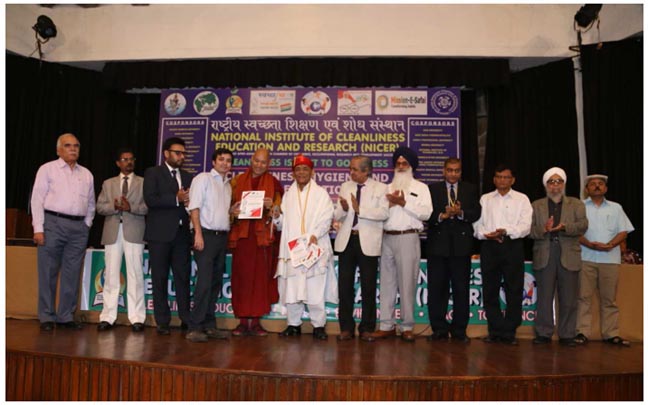
Kumar Chandan selected
for promoting cleanliness in the
management and technical institutions
being felicitated during the Afro-Asian
Cleanliness Convention 2016 on 21 March
2016
Hand washing with wipes
Hand washing using hand sanitizing wipes is also recommended by CDC as a convenient alternative during traveling in the absence of soap and water in certain health care settings.
Effectiveness
This hygienic behavior has been shown to cut the number of child deaths from diarrhea (the second leading cause of child deaths) by almost half and from pneumonia (the leading cause of child deaths) by one-quarter. There are five critical times in washing hands with soap and/or using of a hand antiseptic related to fecal-oral transmission: after using a bathroom (private or public), after changing a diaper, before feeding a child, before eating and before preparing food or handling raw meat, fish, or poultry, or any other situation leading to potential contamination and see below. To reduce the spread of germs, it is also better to wash the hands and/or use a hand antiseptic before and after tending to a sick person.
For control of staphylococcal infections in hospitals, it has been found that the greatest benefit from hand-cleansing came from the first 20% of washing, and that very little additional benefit was gained when hand cleansing frequency was increased beyond 35%. Washing with plain soap results in more than triple the rate of bacterial infectious disease transmitted to food as compared to washing with antibacterial soap. Comparing hand-rubbing with alcohol-based solution with handwashing with antibacterial soap for a median time of 30 seconds each showed that the alcohol hand-rubbing reduced bacterial contamination 26% more than the antibacterial soap. But soap and water is more effective than alcohol-based hand rubs for reducing H1N1 influenza A virus and Clostridium difficile spores from hands.
Religion
In symbolic hand washing using water only to wash hands is a part of ritual handwashing as a feature of many religions, including Bahai Faith, Hinduism and tevilah and netilat yadayim in Judaism. Similar to these are the practices of Lavabo in Christianity, Wudu in Islam and Misogi in Shintō.
Hand washing behavior
The phrase "washing one's hands of" something, means declaring one's unwillingness to take responsibility for the thing or share complicity in it. In the New Testament book of Matthew, verse 27:24 gives an account of Pontius Pilate washing his hands of the decision to crucify Jesus: "When Pilate saw that he could prevail nothing, but that rather a tumult was made, he took water, and washed his hands before the multitude, saying, 'I am innocent of the blood of this just person.
In Shakespeare's Macbeth, Lady Macbeth begins to compulsively wash her hands in an attempt to cleanse an imagined stain, representing her guilty conscience regarding crimes she had committed and induced her husband to commit.
It has also been found that people, after having recalled or contemplated unethical acts, tend to wash hands more often than others, and tend to value hand washing equipment more. Furthermore, those who are allowed to wash their hands after such a contemplation are less likely to engage in other "cleansing" compensatory actions, such as volunteering.
Excessive hand washing is commonly seen as a symptom of obsessive-compulsive disorder (OCD).
Pros and cons of hand washing practices
Pros
- helps minimize the spread of influenza
- diarrhea prevention
- avoiding respiratory infections
- a preventive measure for infant deaths at their home-birth-deliveries
- improved hand washing practices have been shown to lead to small improvements in the length growth in children under five years of age
Cons
- prone to skin damage
what is Food safety ?
Food Safety is a scientific discipline describing handling, preparation, and storage of food in ways that prevent food borne illness. This includes a number of routines that should be followed to avoid potentially severe health hazards. The tracks within this line of thought are safety between industry and the market and then between the market and the consumer. In considering industry to market practices, food safety considerations include the origins of food including the practices relating to food labeling, food hygiene, food additives and pesticide residues, as well as policies on biotechnology and food and guidelines for the management of governmental import and export inspection and certification systems for foods. In considering market to consumer practices, the usual thought is that food ought to be safe in the market and the concern is safe delivery and preparation of the food for the consumer.
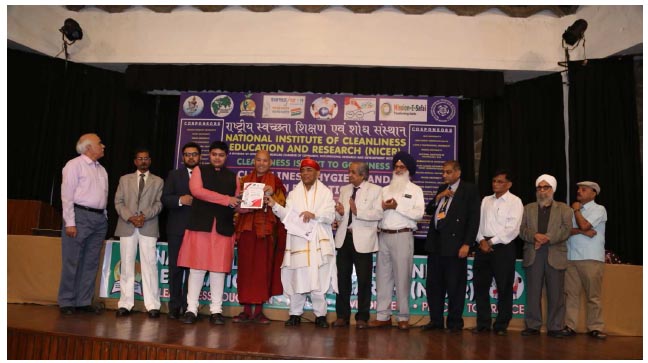
Shri Himadrish Suwan being felicitated
for his efforts through "Mission-E-Safai"
during the Afro-Asian Cleanliness
Convention 2016 on 21 March 2016
Food can transmit disease from person to person as well as serve as a growth medium for bacteria that can cause food poisoning. In developed countries there are intricate standards for food preparation, whereas in lesser developed countries the main issue is simply the availability of adequate safe water, which is usually a critical item. In theory, food poisoning is 100% preventable. The five key principles of food hygiene, according to WHO, are:
1. Prevent contaminating food with pathogens spreading from people, pets, and pests.
2. Separate raw and cooked foods to prevent contaminating the cooked foods.
3. Cook foods for the appropriate length of time and at the appropriate temperature to kill pathogens.
4. Store food at the proper temperature.
5. Do use safe water and cooked materials.
ISO 22000
ISO 22000 is a standard developed by the International Organization for Standardization dealing with food safety. This is a general derivative of ISO 9000. ISO 22000 standard: The ISO 22000 international standard specifies the requirements for a food safety management system that involves interactive communication, system management, prerequisite programs, HACCP principles.
Incidence
A 2003 World Health Organization (WHO) report concluded that about 30% of reported food poisoning outbreaks in the WHO European Region occur in private homes. According to the WHO and CDC, in the USA alone, annually, there are 76 million cases of foodborne illness leading to 325,000 hospitalizations and 5,000 deaths.
Regulatory agencies
WHO and FAO
In 2003, the WHO and FAO published the Codex Alimentarius which serves as a guideline to food safety.
However, according to Unit 04 - Communication of Health & Consumers Directorate-General of the European Commission (SANCO): "The Codex, while being recommendations for voluntary application by members, Codex standards serve in many cases as a basis for national legislation. The reference made to Codex food safety standards in the World Trade Organizations' Agreement on Sanitary and Phytosanitary measures (SPS Agreement) means that Codex has far reaching implications for resolving trade disputes. WTO members that wish to apply stricter food safety measures than those set by Codex may be required to justify these measures scientifically." So, an agreement made in 2003, signed by all member States, inclusive all EU, in the codex Stan Codex 240 - 2003 for coconut milk, sulphite containing additives like E223 and E 224 are allowed till 30 mg/kg, does NOT mean, they are allowed into the EU, see RASFF entries from Denmark: 2012.0834; 2011.1848; en 2011.168, "sulphite unauthorised in coconut milk from Thailand". Same for polysorbate E 435: see 2012.0838 from Denmark, unauthorised polysorbates in coconut milk and, 2007.AIC from France. Only for the latter the EU amended its regulations with (EU) No 583/2012 per 2 July 2012 to allow this additive, already used for decades and absolutely necessary.
Australia
Food Standards Australia New Zealand requires all food businesses to implement food safety systems. These systems are designed to ensure food is safe to consume and halt the increasing incidence of food poisoning, and they include basic food safety training for at least one person in each business. Food safety training is delivered in various forms by Registered Training Organizations (RTOs), after which staff are issued a nationally recognised unit of competency code on their certificate. Basic food safety training includes:
- Understanding the hazards associated with the main types of food and the conditions to prevent the growth of bacteria which can cause food poisoning and to prevent illness.
- Potential problems associated with product packaging such as leaks in vacuum packs, damage to packaging or pest infestation, as well as problems and diseases spread by pests.
- Safe food handling. This includes safe procedures for each process such as receiving, re-packing, food storage, preparation and cooking, cooling and re-heating, displaying products, handling products when serving customers, packaging, cleaning and sanitizing, pest control, transport and delivery. Also covers potential causes of cross contamination.
- Catering for customers who are particularly at risk of food-borne illness, as well as those with allergies or intolerance.
- Correct cleaning and sanitizing procedures, cleaning products and their correct use, and the storage of cleaning items such as brushes, mops and cloths.
- Personal hygiene, hand washing, illness, and protective clothing.
New legislation means that people responsible for serving unsafe food may be liable for heavy fines.

The Chancellor of Akal University and
Eternal University being felicitated by
Ms. Neelam Joshi during the the
Afro-Asian Cleanliness Convention 2016
on 21 March 2016
China
Food safety is a growing concern in Chinese agriculture. The Chinese government oversees agricultural production as well as the manufacture of food packaging, containers, chemical additives, drug production, and business regulation. In recent years, the Chinese government attempted to consolidate food regulation with the creation of the State Food and Drug Administration in 2003, and officials have also been under increasing public and international pressure to solve food safety problems. However, it appears that regulations are not well known by the trade. Labels used for "green" food, "organic" food and "pollution-free" food are not well recognized by traders and many are unclear about their meaning. A survey by the World Bank found that supermarket managers had difficulty in obtaining produce that met safety requirements and found that a high percentage of produce did not comply with established standards.
Traditional marketing systems, whether in China or the rest of Asia, presently provide little motivation or incentive for individual farmers to make improvements to either quality or safety as their produce tends to get grouped together with standard products as it progresses through the marketing channel. Direct linkages between farmer groups and traders or ultimate buyers, such as supermarkets, can help avoid this problem. Governments need to improve the condition of many markets through upgrading management and reinvesting market fees in physical infrastructure. Wholesale markets need to investigate the feasibility of developing separate sections to handle fruits and vegetables that meet defined safety and quality standards.
European Union
The Parliament of the European Union (EU) makes legislation in the form of directives and regulations, many of which are mandatory for member States and which therefore must be incorporated into individual countries' national legislation. As a very large organisation that exists to remove barriers to trade between member States, and into which individual member States have only a proportional influence, the outcome is often seen as an excessively bureaucratic 'one size fits all' approach. However, in relation to food safety the tendency to err on the side of maximum protection for the consumer may be seen as a positive benefit. The EU parliament is informed on food safety matters by the European Food Safety Authority.
Individual member States may also have other legislation and controls in respect of food safety, provided that they do not prevent trade with other States, and can differ considerably in their internal structures and approaches to the regulatory control of food safety.
France
Agence nationale de sécurité sanitaire de l'alimentation, de l'environnement et du travail (anses) is a French governmental agency dealing with food safety.
Germany
The Federal Ministry of Food, Agriculture and Consumer Protection (BMELV) is a Federal Ministry of the Federal Republic of Germany. History: Founded as Federal Ministry of Food, Agriculture and Foresting in 1949, this name did not change until 2001. Then the name changed to Federal Ministry of Consumer Protection, Food and Agriculture. At the 22nd of November 2005, the name got changed again to its current State: Federal Ministry of Food, Agriculture and Consumer Protection. The reason for this last change was that all the resorts should get equal ranking which was achieved by sorting the resorts alphabetically. Vision: A balanced and healthy diet with safe food, distinct consumer rights and consumer information for various areas of life, and a strong and sustainable agriculture as well as perspectives for our rural areas are important goals of the Federal Ministry of Food, Agriculture and Consumer Protection (BMELV). The Federal Office of Consumer Protection and Food Safety is under the control of the Federal Ministry of Food, Agriculture and Consumer Protection. It exercises several duties, with which it contributes to safer food and thereby intensifies health-based consumer protection in Germany. Food can be manufactured and sold within Germany without a special permission, as long as it does not cause any damage on consumers' health and meets the general standards set by the legislation. However, manufacturers, carriers, importers and retailers are responsible for the food they pass into circulation. They are obliged to ensure and document the safety and quality of their food with the use of in-house control mechanisms.
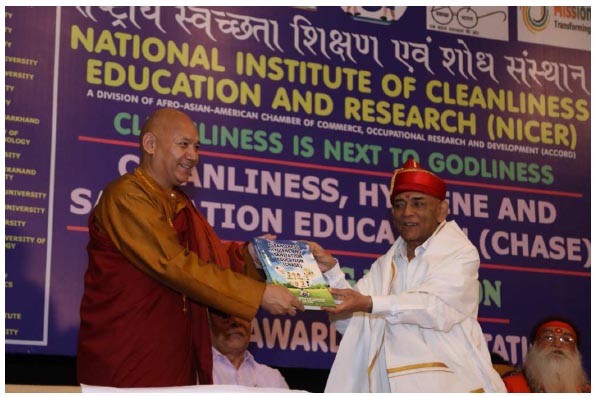
The Book "Cleanless, Hygiene and
Sanitation Education" being dedicated to
the
world citizenry during the Afro-Asian
Cleanliness Convention 2016 on 21 March
2016
Hong Kong
In Hong Kong SAR, the Centre for Food Safety is in charge of ensuring food sold is safe and fit for consumption.
India
Food Safety and Standards Authority of India, established under the Food Safety and Standards Act, 2006, is the regulating body related to food safety and laying down of standards of food in India.
New Zealand
The New Zealand Food Safety Authority (NZFSA), or Te Pou Oranga Kai O Aotearoa is the New Zealand government body responsible for food safety. NZFSA is also the controlling authority for imports and exports of food and food-related products. The NZFSA as of 2012 is now a division of the Ministry for Primary Industries (MPI) and is no longer its own organization.
Pakistan
Pakistan does not have an integrated legal framework but has a set of laws, which deals with various aspects of food safety. These laws, despite the fact that they were enacted long time ago, have tremendous capacity to achieve at least minimum level of food safety. However, like many other laws, these laws remain very poorly enforced. There are four laws that specifically deal with food safety. Three of these laws directly focus issues related to food safety, while the fourth, the Pakistan Standards and Quality Control Authority Act, is indirectly relevant to food safety.
The Pure Food Ordinance 1960 consolidates and amends the law in relation to the preparation and the sale of foods. All provinces and some northern areas have adopted this law with certain amendments. Its aim is to ensure purity of food being supplied to people in the market and, therefore, provides for preventing adulteration. The Pure Food Ordinance 1960 does not apply to cantonment areas. There is a separate law for cantonments called "The Cantonment Pure Food Act, 1966". There is no substantial difference between the Pure Food Ordinance 1960 and The Cantonment Pure Food Act. Even the rules of operation are very much similar.
Pakistan Hotels and Restaurant Act, 1976 applies to all hotels and restaurants in Pakistan and seeks to control and regulate the rates and standard of service(s) by hotels and restaurants. In addition to other provisions, under section 22(2), the sale of food or beverages that are contaminated, not prepared hygienically or served in utensils that are not hygienic or clean is an offense. There are no express provisions for consumer complaints in the Pakistan Restaurants Act, 1976, Pakistan Penal Code, 1860 and Pakistan Standards and Quality Control Authority Act, 1996. The laws do not prevent citizens from lodging complaints with the concerned government officials; however, the consideration and handling of complaints is a matter of discretion of the officials.
South Korea
Korea Food & Drug Administration
Korea Food & Drug Administration (KFDA) is working for food safety since 1945. It is part of the Government of South Korea.
IOAS-Organic Certification Bodies Registered in KFDA: "Organic" or related claims can be labelled on food products when organic certificates are considered as valid by KFDA. KFDA admits organic certificates which can be issued by 1) IFOAM (International Federation of Organic Agriculture Movement) accredited certification bodies 2) Government accredited certification bodies - 328 bodies in 29 countries have been registered in KFDA.
Food Import Report: According to Food Import Report, it is supposed to report or register what you import. Competent authority is as follows:
|
Product |
Authority |
|
Imported Agricultural Products, Processed Foods, Food Additives, Utensils, Containers & Packages or Health Functional Foods |
KFDA (Korea Food and Drug Administration) |
|
Imported Livestock, Livestock products (including Dairy products) |
NVRQS (National Veterinary Research and Quarantine Service) |
|
Packaged meat, milk & dairy products (butter, cheese), hamburger patties, meat ball and other processed products which are stipulated by Livestock Sanitation Management Act |
NVRQS (National Veterinary Research and Quarantine Service) |
|
Imported Marine products; fresh, chilled, frozen, salted, dehydrated, eviscerated marine produce which can be recognized its characteristics |
NFIS (National Fisheries Products Quality Inspection Service) |
National Institute of Food and Drug Safety Evaluation
National Institute of Food and Drug Safety Evaluation (NIFDS) is functioning as well. The National Institute of Food and Drug Safety Evaluation is a national organization for toxicological tests and research. Under the Korea Food & Drug Administration, the Institute performs research on toxicology, pharmacology, and risk analysis of foods, drugs, and their additives. The Institute strives primarily to understand important biological triggering mechanisms and improve assessment methods of human exposure, sensitivities, and risk by (1) conducting basic, applied, and policy research that closely examines biologically triggering harmful effects on the regulated products such as foods, food additives, and drugs, and operating the national toxicology program for the toxicological test development and inspection of hazardous chemical substances assessments. The Institute ensures safety by investigation and research on safety by its own researchers, contract research by external academicians and research centers.
United Kingdom
In the UK the Food Standards Agency is an independent government department responsible for food safety and hygiene across the UK. They work with businesses to help them produce safe food, and with local authorities to enforce food safety regulations. In 2006 food hygiene legislation changed and new requirements came into force. The main requirement resulting from this change is that if you own or run a food business in the UK, you must have a documented Food Safety Management System, which is based on the principles of Hazard Analysis Critical Control Point HACCP.
United States
The US food system is regulated by numerous federal, State and local officials. It has been criticized as lacking in "organization, regulatory tools, and not addressing food borne illness."
Federal level regulation
The Food and Drug Administration publishes the Food Code, a model set of guidelines and procedures that assists food control jurisdictions by providing a scientifically sound technical and legal basis for regulating the retail and food service industries, including restaurants, grocery stores and institutional foodservice providers such as nursing homes. Regulatory agencies at all levels of government in the United States use the FDA Food Code to develop or update food safety rules in their jurisdictions that are consistent with national food regulatory policy. According to the FDA, 48 of 56 States and territories, representing 79% of the U.S. population, have adopted food codes patterned after one of the five versions of the Food Code, beginning with the 1993 edition.
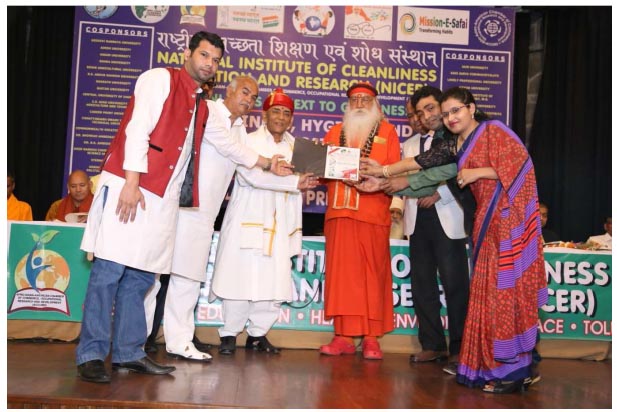
Great 1 India.com represented by Shri
Rajneesh Kumar Pushkar and Mrs. Swami
Kaushal
being felicitated for their contribution
towards clean marketing during
the
Afro-Asian Cleanliness Convention 2016
on 21 March 2016
In the United States, federal regulations governing food safety are fragmented and complicated, according to a February 2007 report from the Government Accountability Office. There are 15 agencies sharing oversight responsibilities in the food safety system, although the two primary agencies are the U.S. Department of Agriculture (USDA) Food Safety and Inspection Service (FSIS), which is responsible for the safety of meat, poultry, and processed egg products, and the Food and Drug Administration (FDA), which is responsible for virtually all other foods.
The Food Safety and Inspection Service has approximately 7,800 inspection program personnel working in nearly 6,200 federally inspected meat, poultry and processed egg establishments. FSIS is charged with administering and enforcing the Federal Meat Inspection Act, the Poultry Products Inspection Act, the Egg Products Inspection Act, portions of the Agricultural Marketing Act, the Humane Slaughter Act, and the regulations that implement these laws. FSIS inspection program personnel inspect every animal before slaughter, and each carcass after slaughter to ensure public health requirements are met. In fiscal year (FY) 2008, this included about 50 billion pounds of livestock carcasses, about 59 billion pounds of poultry carcasses, and about 4.3 billion pounds of processed egg products. At U.S. borders, they also inspected 3.3 billion pounds of imported meat and poultry products.
Industry pressure
There have been concerns over the efficacy of safety practices and food industry pressure on U.S. regulators. A study reported by Reuters found that "the food industry is jeopardizing U.S. public health by withholding information from food safety investigators or pressuring regulators to withdraw or alter policy designed to protect consumers". A survey found that 25% of U.S. government inspectors and scientists surveyed have experienced during the past year corporate interests forcing their food safety agency to withdraw or to modify agency policy or action that protects consumers. Scientists have observed that management undercuts field inspectors who stand up for food safety against industry pressure. According to Dr. Dean Wyatt, a USDA veterinarian who oversees federal slaughter house inspectors, "Upper level management does not adequately support field inspectors and the actions they take to protect the food supply. Not only is there lack of support, but there's outright obstruction, retaliation and abuse of power."
State and local regulation
A number of U.S. States have their own meat inspection programs that substitute for USDA inspection for meats that are sold only in-State. Certain State programs have been criticized for undue leniency to bad practices.
However, other State food safety programs supplement, rather than replace, Federal inspections, generally with the goal of increasing consumer confidence in the State's produce. For example, State health departments have a role in investigating outbreaks of food-borne disease bacteria, as in the case of the 2006 outbreak of Escherichia coli O157:H7 (a pathogenic strain of the ordinarily harmless bacteria, E. coli ) from processed spinach. Health departments also promote better food processing practices to eliminate these threats.
In addition to the US Food and Drug Administration, several States that are major producers of fresh fruits and vegetables (including California, Arizona and Florida) have their own State programs to test produce for pesticide residues.
Restaurants and other retail food establishments fall under State law and are regulated by State or local health departments. Typically these regulations require official inspections of specific design features, best food-handling practices, and certification of food handlers. In some places a letter grade or numerical score must be prominently posted following each inspection. In some localities, inspection deficiencies and remedial action are posted on the Internet.
Manufacturing control
HACCP guidelines
Consumer labeling
United Kingdom
Foodstuffs in the UK have one of two labels to indicate the nature of the deterioration of the product and any subsequent health issues. EHO Food Hygiene certification is required to prepare and distribute food. While there is no specified expiry date of such a qualification the changes in legislation it is suggested to update every five years.
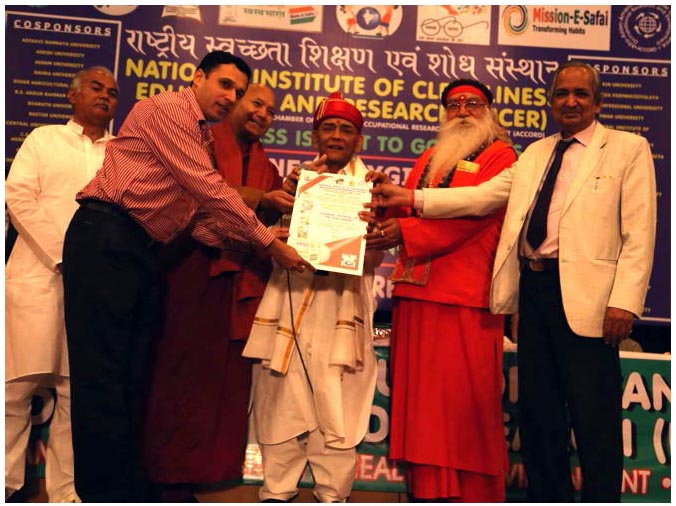
The Clean Hospital of the
Year Award being conferred upon All
India Institute of Medical Sciences
during the Afro-Asian Cleanliness
Convention 2016 on 21 March 2016
Best before indicates a future date beyond which the food product may lose quality in terms of taste or texture amongst others, but does not imply any serious health problems if food is consumed beyond this date (within reasonable limits).
Use by indicates a legal date beyond which it is not permissible to sell a food product (usually one that deteriorates fairly rapidly after production) due to the potential serious nature of consumption of pathogens. Leeway is sometimes provided by producers in stating display until dates so that products are not at their limit of safe consumption on the actual date Stated (this latter is voluntary and not subject to regulatory control). This allows for the variability in production, storage and display methods.
United States
With the exception of infant formula and baby foods which must be withdrawn by their expiration date, Federal law does not require expiration dates. For all other foods, except dairy products in some States, freshness dating is strictly voluntary on the part of manufacturers. In response to consumer demand, perishable foods are typically labelled with a Sell by date. It is up to the consumer to decide how long after the Sell by date a package is usable. Other common dating Statements are Best if used by, Use-by date, Expiration date, Guaranteed fresh <date>, and Pack date.
Australia and New Zealand
Guide to Food Labelling and Other Information Requirements: This guide provides background information on the general labelling requirements in the Code. The information in this guide applies both to food for retail sale and to food for catering purposes. Foods for catering purposes means those foods for use in restaurants, canteens, schools, caterers or self-catering institutions, where food is offered for immediate consumption. Labelling and information requirements in the new Code apply both to food sold or prepared for sale in Australia and New Zealand and food imported into Australia and New Zealand. Warning and Advisory Declarations, Ingredient Labelling, Date Marking, Nutrition Information Requirements, Legibility Requirements for Food Labels, Percentage Labelling, Information Requirements for Foods Exempt from Bearing a Label.
what is Sewage treatment ?
Sewage Treatment is the process of removing contaminants from wastewater, including household sewage and runoff (effluents). It includes physical, chemical, and biological processes to remove physical, chemical and biological contaminants. Its objective is to produce an environmentally safe fluid waste stream (or treated effluent) and a solid waste (or treated sludge) suitable for disposal or reuse (usually as farm fertilizer). With suitable technology, it is possible to re-use sewage effluent for drinking water, although this is usually only done in places with limited water supplies, such as Windhoek and Singapore.
History
Basic sewer systems were used for waste removal in ancient Mesopotamia, where vertical shafts carried the waste away into cesspools. Similar systems existed in the Indus Valley civilization in modern day India and in Ancient Crete and Greece. In the Middle Ages the sewer systems built by the Romans fell into disuse and waste was collected into cesspools that were periodically emptied by workers known as 'rakers' who would often sell it as fertilizer to farmers outside the city.
Modern sewage systems were first built in the mid-nineteenth century as a reaction to the exacerbation of sanitary conditions brought on by heavy industrialization and urbanization. Due to the contaminated water supply, cholera outbreaks occurred in 1832, 1849 and 1855 in London, killing tens of thousands of people. This, combined with the Great Stink of 1858, when the smell of untreated human waste in the River Thames became overpowering, and the report into sanitation reform of the Royal Commissioner Edwin Chadwick, led to the Metropolitan Commission of Sewers appointing Sir Joseph Bazalgette to construct a vast underground sewage system for the safe removal of waste. Contrary to Chadwick's recommendations, Bazalgette's system, and others later built in Continental Europe, did not pump the sewage onto farm land for use as fertilizer; it was simply piped to a natural waterway away from population centres, and pumped back into the environment.
Early attempts
One of the first attempts at diverting sewage for use as a fertilizer in the farm was made by the cotton mill owner James Smith in the 1840s. He experimented with a piped distribution system initially proposed by James Vetch that collected sewage from his factory and pumped it into the outlying farms, and his success was enthusiastically followed by Edwin Chadwick and supported by organic chemist Justus von Liebig.
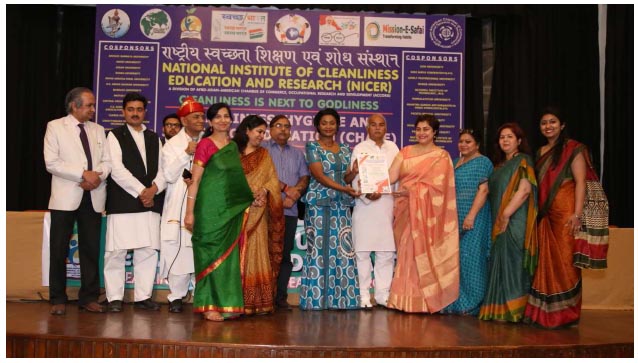
Eco-feminism and
Cleanliness award winners during the
Afro-Asian Cleanliness Convention 2016
on 21 March 2016
The idea was officially adopted by the Health of Towns Commission, and various schemes (known as sewage farms) were trialled by different municipalities over the next 50 years. At first, the heavier solids were channeled into ditches on the side of the farm and were covered over when full, but soon flat-bottomed tanks were employed as reservoirs for the sewage; the earliest patent was taken out by William Higgs in 1846 for "tanks or reservoirs in which the contents of sewers and drains from cities, towns and villages are to be collected and the solid animal or vegetable matters therein contained, solidified and dried..." Improvements to the design of the tanks included the introduction of the horizontal-flow tank in the 1850s and the radial-flow tank in 1905.
These tanks had to be manually de-sludged periodically, until the introduction of automatic mechanical de-sludgers in the early 1900s.
The precursor to the modern septic tank was the cesspool in which the water was sealed off to prevent contamination and the solid waste was slowly liquified due to anaerobic action; it was invented by L.H Mouras in France in the 1860s. Donald Cameron, as City Surveyor for Exeter patented an improved version in 1895, which he called a 'septic tank'; septic having the meaning of 'bacterial'. These are still in worldwide use, especially in rural areas unconnected to large-scale sewage systems.
Chemical treatment
It was not until the late 19th century that it became possible to treat the sewage by chemically breaking it down through the use of microorganisms and removing the pollutants. Land treatment was also steadily becoming less feasible, as cities grew and the volume of sewage produced could no longer be absorbed by the farmland on the outskirts.
Sir Edward Frankland conducted experiments at the Sewage Farm in Croydon, England, during the 1870s and was able to demonstrate that filtration of sewage through porous gravel produced a nitrified effluent (the ammonia was converted into nitrate) and that the filter remained unclogged over long periods of time. This established the then revolutionary possibility of biological treatment of sewage using a contact bed to oxidize the waste. This concept was taken up by the chief chemist for the London Metropolitan Board of Works, William Libdin, in 1887:
...in all probability the true way of purifying sewage...will be first to separate the sludge, and then turn into neutral effluent... retain it for a sufficient period, during which time it should be fully aerated, and finally discharge it into the stream in a purified condition. This is indeed what is aimed at and imperfectly accomplished on a sewage farm.
From 1885 to 1891 filters working on this principle were constructed throughout the UK and the idea was also taken up in the US at the Lawrence Experiment Station in Massachusetts, where Frankland's work was confirmed. In 1890 the LES developed a 'trickling filter' that gave a much more reliable performance.
Contact beds were developed in Salford, Manchester and by scientists working for the London City Council in the early 1890s. According to Christopher Hamlin, this was part of a conceptual revolution that replaced the philosophy that saw "sewage purification as the prevention of decomposition with one that tried to facilitate the biological process that destroy sewage naturally."
Contact beds were tanks containing the inert substance, such as stones or slate, that maximized the surface area available for the microbial growth to break down the sewage. The sewage was held in the tank until it was fully decomposed and it was then filtered out into the ground. This method quickly became widespread, especially in the UK, where it was used in Leicester, Sheffield, Manchester and Leeds. The bacterial bed was simultaneously developed by Joseph Corbett as Borough Engineer in Salford and experiments in 1905 showed that his method was superior in that greater volumes of sewage could be purified better for longer periods of time than could be achieved by the contact bed.
The Royal Commission on Sewage Disposal published its eighth report in 1912 that set what became the international standard for sewage discharge into rivers; the '20:30 standard', which allowed 20 mg Biochemical oxygen demand and 30 mg suspended solid per litre.
Activated sludge
The development of secondary treatments to sewage in the early twentieth century led to arguably the single most significant improvement in public health and the environment during the course of the century, the invention of the 'activated sludge' process for the treatment of sewage.
In 1912, Dr. Gilbert Fowler, a scientist at the University of Manchester, observed experiments being conducted at the Lawrence Experiment Station at Massachusetts involving the aeration of sewage in a bottle that had been coated with algae. Fowler's engineering colleagues, Edward Ardern and William Lockett, who were conducting research for the Manchester Corporation Rivers Department at Davyhulme Sewage Works, experimented on treating sewage in a draw-and-fill reactor, which produced a highly treated effluent.
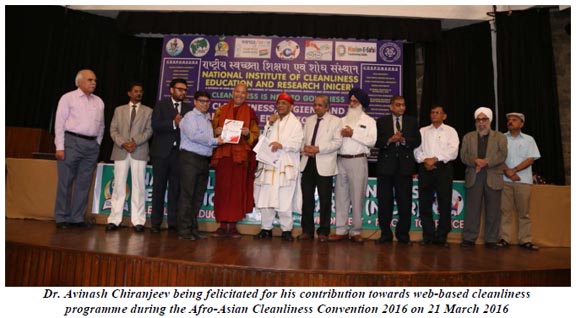
They aerated the waste-water continuously for about a month and were able to achieve a complete nitrification of the sample material. Believing that the sludge had been activated (in a similar manner to activated carbon) the process was named activated sludge.
Their results were published in their seminal 1914 paper, and the first full-scale continuous-flow system was installed at Worcester two years later. In the aftermath of the First World War the new treatment method spread rapidly, especially to the USA, Denmark, Germany and Canada. By the late 1930s, the activated sludge treatment was the predominant process used around the world.
Origins of sewage
Sewage is generated by residential, institutional, commercial and industrial establishments. It includes household waste liquid from toilets, baths, showers, kitchens, sinks and so forth that is disposed of via sewers. In many areas, sewage also includes liquid waste from industry and commerce. The separation and draining of household waste into greywater and blackwater is becoming more common in the developed world, with greywater being permitted to be used for watering plants or recycled for flushing toilets.
Sewage may include stormwater runoff. Sewerage systems capable of handling storm water are known as combined sewer systems. This design was common when urban sewerage systems were first developed, in the late 19th and early 20th centuries.:119 Combined sewers require much larger and more expensive treatment facilities than sanitary sewers. Heavy volumes of storm runoff may overwhelm the sewage treatment system, causing a spill or overflow.
Sanitary sewers are typically much smaller than combined sewers, and they are not designed to transport stormwater. Backups of raw sewage can occur if excessive infiltration/inflow (dilution by stormwater and/or groundwater) is allowed into a sanitary sewer system.
Communities that have urbanized in the mid-20th century or later generally have built separate systems for sewage (sanitary sewers) and stormwater, because precipitation causes widely varying flows, reducing sewage treatment plant efficiency.
As rainfall travels over roofs and the ground, it may pick up various contaminants including soil particles and other sediment, heavy metals, organic compounds, animal waste, and oil and grease.
Some jurisdictions require stormwater to receive some level of treatment before being discharged directly into waterways. Examples of treatment processes used for stormwater include retention basins, wetlands, buried vaults with various kinds of media filters, and vortex separators (to remove coarse solids).
Process overview
Sewage can be treated close to where the sewage is created, a decentralized system (in septic tanks, biofilters or aerobic treatment systems), or be collected and transported by a network of pipes and pump stations to a municipal treatment plant, a centralized system (see sewerage and pipes and infrastructure). Sewage collection and treatment is typically subject to local, State and federal regulations and standards. Industrial sources of sewage often require specialized treatment processes (see Industrial wastewater treatment).
Sewage treatment generally involves three stages, called primary, secondary and tertiary treatment.
- Primary treatment consists of temporarily holding the sewage in a quiescent basin where heavy solids can settle to the bottom while oil, grease and lighter solids float to the surface. The settled and floating materials are removed and the remaining liquid may be discharged or subjected to secondary treatment.
- Secondary treatment removes dissolved and suspended biological matter. Secondary treatment is typically performed by indigenous, water-borne micro-organisms in a managed habitat. Secondary treatment may require a separation process to remove the micro-organisms from the treated water prior to discharge or tertiary treatment.
- Tertiary treatment is sometimes defined as anything more than primary and secondary treatment in order to allow rejection into a highly sensitive or fragile ecosystem (estuaries, low-flow rivers, coral reefs,...). Treated water is sometimes disinfected chemically or physically (for example, by lagoons and microfiltration) prior to discharge into a stream, river, bay, lagoon or wetland, or it can be used for the irrigation of a golf course, green way or park. If it is sufficiently clean, it can also be used for groundwater recharge or agricultural purposes.
Pretreatment
Pretreatment removes all materials that can be easily collected from the raw sewage before they damage or clog the pumps and sewage lines of primary treatment clarifiers. Objects that are commonly removed during pretreatment include trash, tree limbs, leaves, branches, and other large objects.
The influent in sewage water passes through a bar screen to remove all large objects like cans, rags, sticks, plastic packets etc. carried in the sewage stream. This is most commonly done with an automated mechanically raked bar screen in modern plants serving large populations, while in smaller or less modern plants, a manually cleaned screen may be used. The raking action of a mechanical bar screen is typically paced according to the accumulation on the bar screens and/or flow rate. The solids are collected and later disposed in a landfill, or incinerated. Bar screens or mesh screens of varying sizes may be used to optimize solids removal. If gross solids are not removed, they become entrained in pipes and moving parts of the treatment plant, and can cause substantial damage and inefficiency in the process.
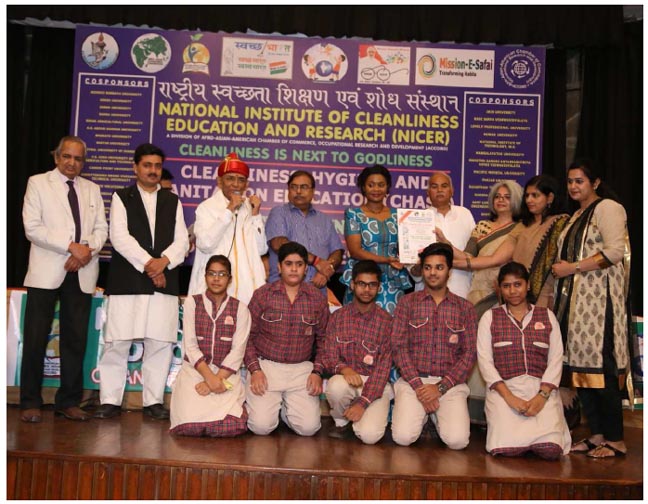
Bright students and teachers receiving
the special award from
Ms. Juliana Somba Banda during
the
Afro-Asian Cleanliness Convention 2016
on 21 March 2016
Grit removal
Pretreatment may include a sand or grit channel or chamber, where the velocity of the incoming sewage is adjusted to allow the settlement of sand, grit, stones, and broken glass. These particles are removed because they may damage pumps and other equipment. For small sanitary sewer systems, the grit chambers may not be necessary, but grit removal is desirable at larger plants. Grit chambers come in 3 types: horizontal grit chambers, aerated grit chambers and vortex grit chambers.
Flow equalization
Clarifiers and mechanized secondary treatment are more efficient under uniform flow conditions. Equalization basins may be used for temporary storage of diurnal or wet-weather flow peaks. Basins provide a place to temporarily hold incoming sewage during plant maintenance and a means of diluting and distributing batch discharges of toxic or high-strength waste which might otherwise inhibit biological secondary treatment (including portable toilet waste, vehicle holding tanks, and septic tank pumpers). Flow equalization basins require variable discharge control, typically include provisions for bypass and cleaning, and may also include aerators. Cleaning may be easier if the basin is downstream of screening and grit removal.
Fat and grease removal
In some larger plants, fat and grease are removed by passing the sewage through a small tank where skimmers collect the fat floating on the surface. Air blowers in the base of the tank may also be used to help recover the fat as a froth. Many plants, however, use primary clarifiers with mechanical surface skimmers for fat and grease removal.
Primary treatment
In the primary sedimentation stage, sewage flows through large tanks, commonly called "pre-settling basins", "primary sedimentation tanks" or "primary clarifiers". The tanks are used to settle sludge while grease and oils rise to the surface and are skimmed off. Primary settling tanks are usually equipped with mechanically driven scrapers that continually drive the collected sludge towards a hopper in the base of the tank where it is pumped to sludge treatment facilities.:9-11 Grease and oil from the floating material can sometimes be recovered for saponification (soap making).
Secondary treatment
Secondary treatment is designed to substantially degrade the biological content of the sewage which are derived from human waste, food waste, soaps and detergent. The majority of municipal plants treat the settled sewage liquor using aerobic biological processes. To be effective, the biota require both oxygen and food to live. The bacteria and protozoa consume biodegradable soluble organic contaminants (e.g. sugars, fats, organic short-chain carbon molecules, etc.) and bind much of the less soluble fractions into floc. Secondary treatment systems are classified as fixed-film or suspended-growth systems.
- Fixed-film or attached growth systems include trickling filters, bio-towers, and rotating biological contactors, where the biomass grows on media and the sewage passes over its surface. The fixed-film principle has further developed into Moving Bed Biofilm Reactors (MBBR), and Integrated Fixed-Film Activated Sludge (IFAS) processes. An MBBR system typically requires smaller footprint than suspended-growth systems.
- Suspended-growth systems include activated sludge, where the biomass is mixed with the sewage and can be operated in a smaller space than trickling filters that treat the same amount of water. However, fixed-film systems are more able to cope with drastic changes in the amount of biological material and can provide higher removal rates for organic material and suspended solids than suspended growth systems.:11-13
Roughing filters are intended to treat particularly strong or variable organic loads, typically industrial, to allow them to then be treated by conventional secondary treatment processes. Characteristics include filters filled with media to which wastewater is applied. They are designed to allow high hydraulic loading and a high level of aeration. On larger installations, air is forced through the media using blowers. The resultant wastewater is usually within the normal range for conventional treatment processes.
A filter removes a small percentage of the suspended organic matter, while the majority of the organic matter undergoes a change of character, only due to the biological oxidation and nitrification taking place in the filter. With this aerobic oxidation and nitrification, the organic solids are converted into coagulated suspended mass, which is heavier and bulkier, and can settle to the bottom of a tank. The effluent of the filter is therefore passed through a sedimentation tank, called a secondary clarifier, secondary settling tank or humus tank.

A student delegate
presenting her views during the
Afro-Asian Cleanliness Convention 2016
on 21 March 2016
Activated sludge
In general, activated sludge plants encompass a variety of mechanisms and processes that use dissolved oxygen to promote the growth of biological floc that substantially removes organic material.
Biological floc, as mentioned above, is an ecosystem of living biota that subsists on nutrients from the inflowing primary settling tank (or clarifier) effluent.
These mostly carbonaceous dissolved solids undergo aeration to be broken down and biologically oxidized or converted to carbon dioxide. Likewise, nitrogenous dissolved solids (amino acids, ammonia, etc.) are also oxidized (=eaten) by the floc to nitrites, nitrates, and, in some processes, to nitrogen gas through denitrification.
While denitrification is encouraged in some treatment processes, in many suspended aeration plants denitrification will impair the settling of the floc and lead to poor quality effluent.
In either case, the settled floc is both recycled to the inflowing primary effluent to regrow, or is partially 'wasted' (or diverted) to solids dewatering, or digesting, and then dewatering.
Interestingly, like most living creatures, activated sludge biota can get sick. This many times takes the form of the floating brown foam, Nocardia.
While this so-called 'sewage fungus' (it isn't really a fungus) is the best known, there are many different fungi and protists that can overpopulate the floc and cause process upsets. Additionally, certain incoming chemical species, such as a heavy pesticide, a heavy metal (e.g.: plating company effluent) load, or extreme pH, can kill the biota of an activated sludge reactor ecosystem. Such problems are tested for, and if caught in time, can be neutralized.
Aerobic granular sludge
Activated sludge systems can be transformed into aerobic granular sludge systems (aerobic granulation) which enhance the benefits of activated sludge, like increased biomass retention due to high sludge settlability.
Surface-aerated basins (lagoons)
Many small municipal sewage systems in the United States (1 million gal./day or less) use aerated lagoons.
Most biological oxidation processes for treating industrial wastewaters have in common the use of oxygen (or air) and microbial action. Surface-aerated basins achieve 80 to 90 percent removal of BOD with retention times of 1 to 10 days. The basins may range in depth from 1.5 to 5.0 metres and use motor-driven aerators floating on the surface of the wastewater.
In an aerated basin system, the aerators provide two functions: they transfer air into the basins required by the biological oxidation reactions, and they provide the mixing required for dispersing the air and for contacting the reactants (that is, oxygen, wastewater and microbes). Typically, the floating surface aerators are rated to deliver the amount of air equivalent to 1.8 to 2.7 kg O2/kW·h. However, they do not provide as good mixing as is normally achieved in activated sludge systems and therefore aerated basins do not achieve the same performance level as activated sludge units.
Biological oxidation processes are sensitive to temperature and, between 0oC and 40oC, the rate of biological reactions increase with temperature. Most surface aerated vessels operate at between 4oC and 32oC.
Filter beds (oxidizing beds)
In older plants and those receiving variable loadings, trickling filter beds are used where the settled sewage liquor is spread onto the surface of a bed made up of coke (carbonized coal), limestone chips or specially fabricated plastic media. Such media must have large surface areas to support the biofilms that form. The liquor is typically distributed through perforated spray arms. The distributed liquor trickles through the bed and is collected in drains at the base. These drains also provide a source of air which percolates up through the bed, keeping it aerobic. Biological films of bacteria, protozoa and fungi form on the media's surfaces and eat or otherwise reduce the organic content. This biofilm is often grazed by insect larvae, snails, and worms which help maintain an optimal thickness. Overloading of beds increases the thickness of the film leading to clogging of the filter media and ponding on the surface. Recent advances in media and process micro-biology design overcome many issues with trickling filter designs.
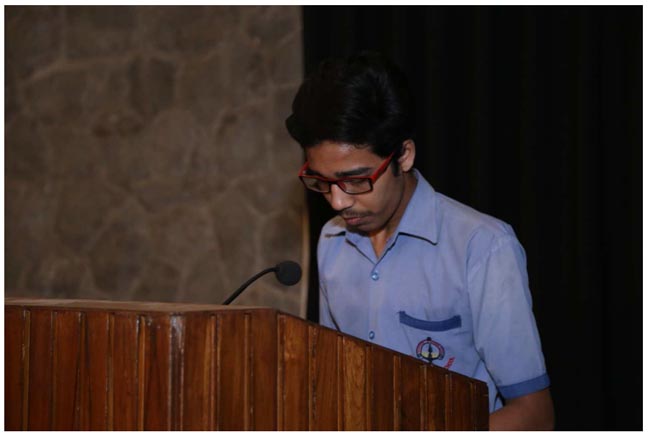
Another student delegate
presenting his views during the
Afro-Asian Cleanliness Convention 2016
on 21 March 2016
Constructed wetlands
Constructed wetlands (can either be surface flow or subsurface flow, horizontal or vertical flow), include engineered reedbeds and belong to the family of phytorestoration and ecotechnologies; they provide a high degree of biological improvement and depending on design, act as a primary, secondary and sometimes tertiary treatment, also see phytoremediation. One example is a small reedbed used to clean the drainage from the elephants' enclosure at Chester Zoo in England; numerous CWs are used to recycle the water of the city of Honfleur in France and numerous other towns in Europe, the US, Asia and Australia. They are known to be highly productive systems as they copy natural wetlands, called the "kidneys of the earth" for their fundamental recycling capacity of the hydrological cycle in the biosphere. Robust and reliable, their treatment capacities improve as time goes by, at the opposite of conventional treatment plants whose machinery ages with time. They are being increasingly used, although adequate and experienced design are more fundamental than for other systems and space limitation may impede their use.
Biological aerated filters
Biological Aerated (or Anoxic) Filter (BAF) or Biofilters combine filtration with biological carbon reduction, nitrification or denitrification. BAF usually includes a reactor filled with a filter media. The media is either in suspension or supported by a gravel layer at the foot of the filter. The dual purpose of this media is to support highly active biomass that is attached to it and to filter suspended solids.
Carbon reduction and ammonia conversion occurs in aerobic mode and sometime achieved in a single reactor while nitrate conversion occurs in anoxic mode. BAF is operated either in upflow or downflow configuration depending on design specified by manufacturer.
Rotating biological contactors
Rotating Biological Contactors (RBCs) are mechanical secondary treatment systems, which are robust and capable of withstanding surges in organic load. RBCs were first installed in Germany in 1960 and have since been developed and refined into a reliable operating unit. The rotating disks support the growth of bacteria and micro-organisms present in the sewage, which break down and stabilize organic pollutants. To be successful, micro-organisms need both oxygen to live and food to grow. Oxygen is obtained from the atmosphere as the disks rotate. As the micro-organisms grow, they build up on the media until they are sloughed off due to shear forces provided by the rotating discs in the sewage. Effluent from the RBC is then passed through final clarifiers where the micro-organisms in suspension settle as a sludge. The sludge is withdrawn from the clarifier for further treatment.
A functionally similar biological filtering system has become popular as part of home aquarium filtration and purification. The aquarium water is drawn up out of the tank and then cascaded over a freely spinning corrugated fiber-mesh wheel before passing through a media filter and back into the aquarium. The spinning mesh wheel develops a biofilm coating of microorganisms that feed on the suspended wastes in the aquarium water and are also exposed to the atmosphere as the wheel rotates. This is especially good at removing waste urea and ammonia urinated into the aquarium water by the fish and other animals.
Membrane bioreactors
Membrane bioreactors (MBR) combine activated sludge treatment with a membrane liquid-solid separation process. The membrane component uses low pressure microfiltration or ultrafiltration membranes and eliminates the need for clarification and tertiary filtration. The membranes are typically immersed in the aeration tank; however, some applications utilize a separate membrane tank. One of the key benefits of an MBR system is that it effectively overcomes the limitations associated with poor settling of sludge in conventional activated sludge (CAS) processes. The technology permits bioreactor operation with considerably higher mixed liquor suspended solids (MLSS) concentration than CAS systems, which are limited by sludge settling. The process is typically operated at MLSS in the range of 8,000–12,000 mg/L, while CAS are operated in the range of 2,000–3,000 mg/L. The elevated biomass concentration in the MBR process allows for very effective removal of both soluble and particulate biodegradable materials at higher loading rates. Thus increased sludge retention times, usually exceeding 15 days, ensure complete nitrification even in extremely cold weather.
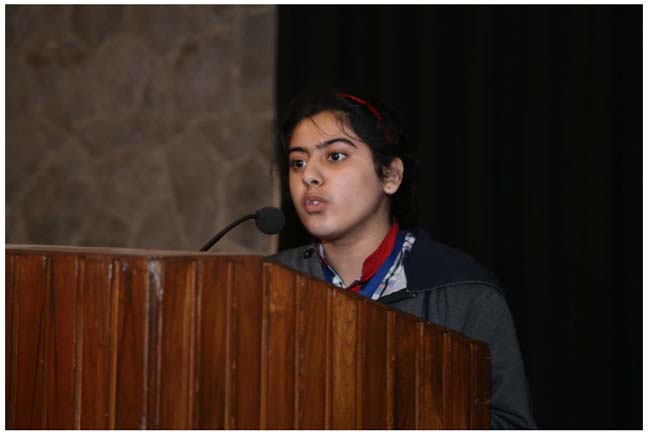
The awarded student
responding during the
Afro-Asian Cleanliness Convention 2016
on 21 March 2016
The cost of building and operating an MBR is often higher than conventional methods of sewage treatment. Membrane filters can be blinded with grease or abraded by suspended grit and lack a clarifier's flexibility to pass peak flows. The technology has become increasingly popular for reliably pretreated waste streams and has gained wider acceptance where infiltration and inflow have been controlled, however, and the life-cycle costs have been steadily decreasing. The small foot print of MBR systems, and the high quality effluent produced, make them particularly useful for water reuse applications.
Secondary sedimentation
The final step in the secondary treatment stage is to settle out the biological floc or filter material through a secondary clarifier and to produce sewage water containing low levels of organic material and suspended matter.
Tertiary treatment
The purpose of tertiary treatment is to provide a final treatment stage to further improve the effluent quality before it is discharged to the receiving environment (sea, river, lake, wet lands, ground, etc.). More than one tertiary treatment process may be used at any treatment plant. If disinfection is practised, it is always the final process. It is also called "effluent polishing."
Filtration
Sand filtration removes much of the residual suspended matter. Filtration over activated carbon, also called carbon adsorption, removes residual toxins.
Lagooning
Lagooning provides settlement and further biological improvement through storage in large man-made ponds or lagoons. These lagoons are highly aerobic and colonization by native macrophytes, especially reeds, is often encouraged. Small filter feeding invertebrates such as Daphnia and species of Rotifera greatly assist in treatment by removing fine particulates.
Nutrient removal
Wastewater may contain high levels of the nutrients nitrogen and phosphorus. Excessive release to the environment can lead to a buildup of nutrients, called eutrophication, which can in turn encourage the overgrowth of weeds, algae, and cyanobacteria (blue-green algae). This may cause an algal bloom, a rapid growth in the population of algae. The algae numbers are unsustainable and eventually most of them die. The decomposition of the algae by bacteria uses up so much of the oxygen in the water that most or all of the animals die, which creates more organic matter for the bacteria to decompose. In addition to causing deoxygenation, some algal species produce toxins that contaminate drinking water supplies. Different treatment processes are required to remove nitrogen and phosphorus.
Nitrogen removal
Nitrogen is removed through the biological oxidation of nitrogen from ammonia to nitrate (nitrification), followed by denitrification, the reduction of nitrate to nitrogen gas. Nitrogen gas is released to the atmosphere and thus removed from the water.
Nitrification itself is a two-step aerobic process, each step facilitated by a different type of bacteria. The oxidation of ammonia (NH3) to nitrite (NO2−) is most often facilitated by Nitrosomonas spp. ("nitroso" referring to the formation of a nitroso functional group). Nitrite oxidation to nitrate (NO3−), though traditionally believed to be facilitated by Nitrobacter spp. (nitro referring the formation of a nitro functional group), is now known to be facilitated in the environment almost exclusively by Nitrospira spp.
Denitrification requires anoxic conditions to encourage the appropriate biological communities to form. It is facilitated by a wide diversity of bacteria. Sand filters, lagooning and reed beds can all be used to reduce nitrogen, but the activated sludge process (if designed well) can do the job the most easily.:17-18 Since denitrification is the reduction of nitrate to dinitrogen (molecular nitrogen) gas, an electron donor is needed. This can be, depending on the wastewater, organic matter (from faeces), sulfide, or an added donor like methanol. The sludge in the anoxic tanks (denitrification tanks) must be mixed well (mixture of recirculated mixed liquor, return activated sludge [RAS], and raw influent) e.g. by using submersible mixers in order to achieve the desired denitrification.

The best and the youngest
delegate during the
Afro-Asian Cleanliness Convention 2016
on 21 March 2016
Sometimes the conversion of toxic ammonia to nitrate alone is referred to as tertiary treatment.
Many sewage treatment plants use centrifugal pumps to transfer the nitrified mixed liquor from the aeration zone to the anoxic zone for denitrification. These pumps are often referred to as Internal Mixed Liquor Recycle (IMLR) pumps.
The bacteria Brocadia anammoxidans, is being researched for its potential in sewage treatment. It can remove nitrogen from waste water. In addition the bacteria can perform the anaerobic oxidation of ammonium and can produce the rocket fuel hydrazine from waste water.
Phosphorus removal
Each person excretes between 200 and 1000 grams of phosphorus annually. Studies of United States sewage in the late 1960s estimated mean per capita contributions of 500 grams in urine and feces, 1000 grams in synthetic detergents, and lesser variable amounts used as corrosion and scale control chemicals in water supplies. Source control via alternative detergent formulations has subsequently reduced the largest contribution, but the content of urine and feces will remain unchanged. Phosphorus removal is important as it is a limiting nutrient for algae growth in many fresh water systems. (For a description of the negative effects of algae, see Nutrient removal). It is also particularly important for water reuse systems where high phosphorus concentrations may lead to fouling of downstream equipment such as reverse osmosis.
Phosphorus can be removed biologically in a process called enhanced biological phosphorus removal. In this process, specific bacteria, called polyphosphate-accumulating organisms (PAOs), are selectively enriched and accumulate large quantities of phosphorus within their cells (up to 20 percent of their mass). When the biomass enriched in these bacteria is separated from the treated water, these biosolids have a high fertilizer value.
Phosphorus removal can also be achieved by chemical precipitation, usually with salts of iron (e.g. ferric chloride), aluminum (e.g. alum), or lime. This may lead to excessive sludge production as hydroxides precipitates and the added chemicals can be expensive. Chemical phosphorus removal requires significantly smaller equipment footprint than biological removal, is easier to operate and is often more reliable than biological phosphorus removal. Another method for phosphorus removal is to use granular laterite.
Once removed, phosphorus, in the form of a phosphate-rich sludge, may be stored in a land fill or resold for use in fertilizer.
Disinfection
The purpose of disinfection in the treatment of waste water is to substantially reduce the number of microorganisms in the water to be discharged back into the environment for the later use of drinking, bathing, irrigation, etc. The effectiveness of disinfection depends on the quality of the water being treated (e.g., cloudiness, pH, etc.), the type of disinfection being used, the disinfectant dosage (concentration and time), and other environmental variables. Cloudy water will be treated less successfully, since solid matter can shield organisms, especially from ultraviolet light or if contact times are low. Generally, short contact times, low doses and high flows all militate against effective disinfection. Common methods of disinfection include ozone, chlorine, ultraviolet light, or sodium hypochlorite.:16 Chloramine, which is used for drinking water, is not used in the treatment of waste water because of its persistence. After multiple steps of disinfection, the treated water is ready to be released back into the water cycle by means of the nearest body of water or agriculture. Afterwards, the water can be transferred to reserves for everyday human uses.
Chlorination remains the most common form of waste water disinfection in North America due to its low cost and long-term history of effectiveness. One disadvantage is that chlorination of residual organic material can generate chlorinated-organic compounds that may be carcinogenic or harmful to the environment. Residual chlorine or chloramines may also be capable of chlorinating organic material in the natural aquatic environment. Further, because residual chlorine is toxic to aquatic species, the treated effluent must also be chemically dechlorinated, adding to the complexity and cost of treatment.
Ultraviolet (UV) light can be used instead of chlorine, iodine, or other chemicals. Because no chemicals are used, the treated water has no adverse effect on organisms that later consume it, as may be the case with other methods. UV radiation causes damage to the genetic structure of bacteria, viruses, and other pathogens, making them incapable of reproduction. The key disadvantages of UV disinfection are the need for frequent lamp maintenance and replacement and the need for a highly treated effluent to ensure that the target microorganisms are not shielded from the UV radiation (i.e., any solids present in the treated effluent may protect microorganisms from the UV light). In the United Kingdom, UV light is becoming the most common means of disinfection because of the concerns about the impacts of chlorine in chlorinating residual organics in the wastewater and in chlorinating organics in the receiving water. Some sewage treatment systems in Canada and the US also use UV light for their effluent water disinfection.
Ozone (O3) is generated by passing oxygen (O2) through a high voltage potential resulting in a third oxygen atom becoming attached and forming O3. Ozone is very unstable and reactive and oxidizes most organic material it comes in contact with, thereby destroying many pathogenic microorganisms. Ozone is considered to be safer than chlorine because, unlike chlorine which has to be stored on site (highly poisonous in the event of an accidental release), ozone is generated on-site as needed. Ozonation also produces fewer disinfection by-products than chlorination. A disadvantage of ozone disinfection is the high cost of the ozone generation equipment and the requirements for special operators.
Odor control
Odors emitted by sewage treatment are typically an indication of an anaerobic or "septic" condition. Early stages of processing will tend to produce foul smelling gases, with hydrogen sulfide being most common in generating complaints. Large process plants in urban areas will often treat the odors with carbon reactors, a contact media with bio-slimes, small doses of chlorine, or circulating fluids to biologically capture and metabolize the noxious gases. Other methods of odor control exist, including addition of iron salts, hydrogen peroxide, calcium nitrate, etc. to manage hydrogen sulfide levels.
High-density solids pumps are suitable for reducing odors by conveying sludge through hermetic closed pipework.
Package plants and batch reactors
To use less space, treat difficult waste and intermittent flows, a number of designs of hybrid treatment plants have been produced. Such plants often combine at least two stages of the three main treatment stages into one combined stage. In the UK, where a large number of wastewater treatment plants serve small populations, package plants are a viable alternative to building a large structure for each process stage. In the US, package plants are typically used in rural areas, highway rest stops and trailer parks.
One type of system that combines secondary treatment and settlement is the cyclic activated sludge (CASSBR). Typically, activated sludge is mixed with raw incoming sewage, and then mixed and aerated. The settled sludge is run off and re-aerated before a proportion is returned to the headworks. SBR plants are now being deployed in many parts of the world.
The disadvantage of the CASSBR process is that it requires a precise control of timing, mixing and aeration. This precision is typically achieved with computer controls linked to sensors. Such a complex, fragile system is unsuited to places where controls may be unreliable, poorly maintained, or where the power supply may be intermittent. Extended aeration package plants use separate basins for aeration and settling, and are somewhat larger than SBR plants with reduced timing sensitivity.
Package plants may be referred to as high charged or low charged. This refers to the way the biological load is processed. In high charged systems, the biological stage is presented with a high organic load and the combined floc and organic material is then oxygenated for a few hours before being charged again with a new load. In the low charged system the biological stage contains a low organic load and is combined with flocculate for longer times.
Sludge treatment and disposal
The sludges accumulated in a wastewater treatment process must be treated and disposed of in a safe and effective manner. The purpose of digestion is to reduce the amount of organic matter and the number of disease-causing microorganisms present in the solids. The most common treatment options include anaerobic digestion, aerobic digestion, and composting. Incineration is also used, albeit to a much lesser degree.
Sludge treatment depends on the amount of solids generated and other site-specific conditions. Composting is most often applied to small-scale plants with aerobic digestion for mid sized operations, and anaerobic digestion for the larger-scale operations.
The sludge is sometimes passed through a so-called pre-thickener which de-waters the sludge. Types of pre-thickeners include centrifugal sludge thickeners rotary drum sludge thickeners and belt filter presses.
Anaerobic digestion
Anaerobic digestion is a bacterial process that is carried out in the absence of oxygen. The process can either be thermophilic digestion, in which sludge is fermented in tanks at a temperature of 55oC, or mesophilic, at a temperature of around 36oC. Though allowing shorter retention time (and thus smaller tanks), thermophilic digestion is more expensive in terms of energy consumption for heating the sludge.
Anaerobic digestion is the most common (mesophilic) treatment of domestic sewage in septic tanks, which normally retain the sewage from one day to two days, reducing the biochemical oxygen demand (BOD) by about 35 to 40 percent. This reduction can be increased with a combination of anaerobic and aerobic treatment by installing Aerobic Treatment Units (ATUs) in the septic tank.
Mesophilic anaerobic digestion (MAD) is also a common method for treating sludge produced at sewage treatment plants. The sludge is fed into large tanks and held for a minimum of 12 days to allow the digestion process to perform the four stages necessary to digest the sludge. These are hydrolysis, acidogenesis, acetogenesis and methanogenesis. In this process the complex proteins and sugars are broken down to form more simple compounds such as water, carbon dioxide and methane.
One major feature of anaerobic digestion is the production of biogas (with the most useful component being methane), which can be used in generators for electricity production and/or in boilers for heating purposes. Many larger sites utilize the biogas for combined heat and power, using the cooling water from the generators to maintain the temperature of the digestion plant at the required 35 ± 3oC.
Aerobic digestion
Aerobic digestion (a subset of the activated sludge process) is a bacterial process occurring in the presence of oxygen. Under aerobic conditions, bacteria rapidly consume organic matter and convert it into carbon dioxide. The operating costs used to be characteristically much greater for aerobic digestion because of the energy used by the blowers, pumps and motors needed to add oxygen to the process. However, recent technological advances include non-electric aerated filter systems that use natural air currents for the aeration instead of electrically operated machinery.
Aerobic digestion can also be achieved by using diffuser systems or jet aerators to oxidize the sludge. Fine bubble diffusers are typically the more cost-efficient diffusion method, however, plugging is typically a problem due to sediment settling into the smaller air holes. Coarse bubble diffusers are more commonly used in activated sludge tanks (generally a side process in waste water management) or in the flocculation stages. A key component for selecting diffuser type is to ensure it will produce the required oxygen transfer rate.
Composting
Composting is also an aerobic process that involves mixing the sludge with sources of carbon such as sawdust, straw or wood chips. In the presence of oxygen, bacteria digest both the wastewater solids and the added carbon source and, in doing so, produce a large amount of heat.:20
Incineration
Incineration of sludge is less common because of air emissions concerns and the supplemental fuel (typically natural gases or fuel oil) required to burn the low calorific value sludge and vaporize residual water. Stepped multiple hearth incinerators with high residence time and fluidized bed incinerators are the most common systems used to combust wastewater sludge. Co-firing in municipal waste-to-energy plants is occasionally done, this option being less expensive assuming the facilities already exist for solid waste and there is no need for auxiliary fuel.
Sludge disposal
When a liquid sludge is produced, further treatment may be required to make it suitable for final disposal.
Typically, sludges are thickened (dewatered) to reduce the volumes transported off-site for disposal. There is no process which completely eliminates the need to dispose of biosolids. There is, however, an additional step some cities are taking to superheat sludge and convert it into small pelletized granules that are high in nitrogen and other organic materials.
In New York City, for example, several sewage treatment plants have dewatering facilities that use large centrifuges along with the addition of chemicals such as polymer to further remove liquid from the sludge. The removed fluid, called "centrate," is typically reintroduced into the wastewater process.
The product which is left is called "cake," and that is picked up by companies which turn it into fertilizer pellets. This product is then sold to local farmers and turf farms as a soil amendment or fertilizer, reducing the amount of space required to dispose of sludge in landfills.
Much sludge originating from commercial or industrial areas is contaminated with toxic materials that are released into the sewers from the industrial processes. Elevated concentrations of such materials may make the sludge unsuitable for agricultural use and it may then have to be incinerated or disposed of to landfill.
Treatment in the receiving environment
Many processes in a wastewater treatment plant are designed to mimic the natural treatment processes that occur in the environment, whether that environment is a natural water body or the ground. If not overloaded, bacteria in the environment will consume organic contaminants, although this will reduce the levels of oxygen in the water and may significantly change the overall ecology of the receiving water. Native bacterial populations feed on the organic contaminants, and the numbers of disease-causing microorganisms are reduced by natural environmental conditions such as predation or exposure to ultraviolet radiation. Consequently, in cases where the receiving environment provides a high level of dilution, a high degree of wastewater treatment may not be required. However, recent evidence has demonstrated that very low levels of specific contaminants in wastewater, including hormones (from animal husbandry and residue from human hormonal contraception methods) and synthetic materials such as phthalates that mimic hormones in their action, can have an unpredictable adverse impact on the natural biota and potentially on humans if the water is re-used for drinking water. In the US and EU, uncontrolled discharges of wastewater to the environment are not permitted under law, and strict water quality requirements are to be met, as clean drinking water is essential. (For requirements in the US, see Clean Water Act.) A significant threat in the coming decades will be the increasing uncontrolled discharges of wastewater within rapidly developing countries.
Effects on biology
Sewage treatment plants can have multiple effects on nutrient levels in the water that the treated sewage flows into. These effects on nutrients can have large effects on the biological life in the water in contact with the effluent. Stabilization ponds (or treatment ponds) can include any of the following:
- Oxidation ponds, which are aerobic bodies of water usually 1–2 meters in depth that receive effluent from sedimentation tanks or other forms of primary treatment.
· Dominated by algae
- Polishing ponds are similar to oxidation ponds but receive effluent from an oxidation pond or from a plant with an extended mechanical treatment.
· Dominated by zooplankton
- Facultative lagoons, raw sewage lagoons, or sewage lagoons are ponds where sewage is added with no primary treatment other than coarse screening. These ponds provide effective treatment when the surface remains aerobic; although anaerobic conditions may develop near the layer of settled sludge on the bottom of the pond.:552–554
- Anaerobic lagoons are heavily loaded ponds.
· Dominated by bacteria
- Sludge lagoons are aerobic ponds, usually 2 to 5 meters in depth, that receive anaerobically digested primary sludge, or activated secondary sludge under water.
· Upper layers are dominated by algae
Phosphorus limitation is a possible result from sewage treatment and results in flagellate-dominated plankton, particularly in summer and fall.
At the same time a different study found high nutrient concentrations linked to sewage effluents. High nutrient concentration leads to high chlorophyll a concentrations, which is a proxy for primary production in marine environments. High primary production means high phytoplankton populations and most likely high zooplankton populations because zooplankton feed on phytoplankton. However, effluent released into marine systems also leads to greater population instability.
A study carried out in Britain found that the quality of effluent affected the planktonic life in the water in direct contact with the wastewater effluent. Turbid, low-quality effluents either did not contain ciliated protozoa or contained only a few species in small numbers. On the other hand, high-quality effluents contained a wide variety of ciliated protozoa in large numbers. Because of these findings, it seems unlikely that any particular component of the industrial effluent has, by itself, any harmful effects on the protozoan populations of activated sludge plants.
The planktonic trends of high populations close to input of treated sewage is contrasted by the bacterial trend. In a study of Aeromonas spp. in increasing distance from a wastewater source, greater change in seasonal cycles was found the furthest from the effluent. This trend is so strong that the furthest location studied actually had an inversion of the Aeromonas spp. cycle in comparison to that of fecal coliforms. Since there is a main pattern in the cycles that occurred simultaneously at all stations it indicates seasonal factors (temperature, solar radiation, phytoplankton) control of the bacterial population. The effluent dominant species changes from Aeromonas caviae in winter to Aeromonas sobria in the spring and fall while the inflow dominant species is Aeromonas caviae, which is constant throughout the seasons.
Sewage treatment in developing countries
Few reliable figures exist on the share of the wastewater collected in sewers that is being treated in the world. In many developing countries the bulk of domestic and industrial wastewater is discharged without any treatment or after primary treatment only. In Latin America about 15 percent of collected wastewater passes through treatment plants (with varying levels of actual treatment). In Venezuela, a below average country in South America with respect to wastewater treatment, 97 percent of the country’s sewage is discharged raw into the environment. In a relatively developed Middle Eastern country such as Iran, the majority of Tehran's population has totally untreated sewage injected to the city’s groundwater. However, the construction of major parts of the sewage system, collection and treatment, in Tehran is almost complete, and under development, due to be fully completed by the end of 2012. In Isfahan, Iran's third largest city, sewage treatment was started more than 100 years ago.
In Israel, about 50 percent of agricultural water usage (total use was 1 billion cubic metres in 2008) is provided through reclaimed sewer water. Future plans call for increased use of treated sewer water as well as more desalination plants.
Most of sub-Saharan Africa is without wastewater treatment.
what is Wastewater ?
Wastewater, also written as waste water, is any water that has been adversely affected in quality by anthropogenic influence. Municipal wastewater is usually conveyed in a combined sewer or sanitary sewer, and treated at a wastewater treatment plant. Treated wastewater is discharged into receiving water via an effluent sewer. Wastewaters generated in areas without access to centralized sewer systems rely on on-site wastewater systems. These typically comprise a septic tank, drain field, and optionally an on-site treatment unit.
Sewage is the subset of wastewater that is contaminated with feces or urine, but is often used to mean any wastewater. Sewage includes domestic, municipal, or industrial liquid waste products disposed of, usually via a pipe or sewer (sanitary or combined), sometimes in a cesspool emptier.
Sewerage is the physical infrastructure, including pipes, pumps, screens, channels etc. used to convey sewage from its origin to the point of eventual treatment or disposal. It is found in all types of sewage treatment, with the exception of septic systems, which treat sewage on site.
Origin
Wastewater or sewage can come from (text in brackets indicates likely inclusions or contaminants):
- Human waste (feces, used toilet paper or wipes, urine, or other bodily fluids), also known as blackwater, usually from lavatories;
- Cesspit leakage;
- Septic tank discharge;
- Sewage treatment plant discharge;
- Washing water (personal, clothes, floors, dishes, etc.), also known as greywater or sullage;
- Rainfall collected on roofs, yards, hard-standings, etc. (generally clean with traces of oils and fuel);
- Groundwater infiltrated into sewage;
- Surplus manufactured liquids from domestic sources (drinks, cooking oil, pesticides, lubricating oil, paint, cleaning liquids, etc.);
- Urban rainfall runoff from roads, carparks, roofs, sidewalks/pavements (contains oils, animal feces, litter, gasoline/petrol, diesel or rubber residues, soapscum, metals from vehicle exhausts, etc.);
- Seawater ingress (high volumes of salt and microbes);
- Direct ingress of river water (high volumes of micro-biota);
- Direct ingress of manmade liquids (illegal disposal of pesticides, used oils, etc.);
- Highway drainage (oil, de-icing agents, rubber residues);
- Storm drains (almost anything, including cars, shopping trolleys, trees, cattle, etc.);
- Blackwater (surface water contaminated by sewage);
- Industrial waste
-
Industrial site
drainage (silt, sand, alkali, oil,
chemical residues);
- Industrial cooling waters (biocides, heat, slimes, silt);
- Industrial process waters;
- Organic or biodegradable waste, including waste from abattoirs, creameries, and ice cream manufacture;
- Organic or non bio-degradable/difficult-to-treat waste (pharmaceutical or pesticide manufacturing);
- Extreme pH waste (from acid/alkali manufacturing, metal plating);
- Toxic waste (metal plating, cyanide production, pesticide manufacturing, etc.);
- Solids and emulsions (paper manufacturing, foodstuffs, lubricating and hydraulic oil manufacturing, etc.);
- Agricultural drainage, direct and diffuse.
- Hydraulic fracturing
- Produced water from oil & natural gas production
Wastewater constituents
The composition of wastewater varies widely. This is a partial list of what it may contain:
- Water (more than 95 percent), which is often added during flushing to carry waste down a drain;
- Pathogens such as bacteria, viruses, prions and parasitic worms;
- Non-pathogenic bacteria;
- Organic particles such as feces, hairs, food, vomit, paper fibers, plant material, humus, etc.;
- Soluble organic material such as urea, fruit sugars, soluble proteins, drugs, pharmaceuticals, etc.;
- Inorganic particles such as sand, grit, metal particles, ceramics, etc.;
- Soluble inorganic material such as ammonia, road-salt, sea-salt, cyanide, hydrogen sulfide, thiocyanates, thiosulfates, etc.;
- Animals such as protozoa, insects, arthropods, small fish, etc.;
- Macro-solids such as sanitary napkins, nappies/diapers, condoms, needles, children's toys, dead animals or plants, etc.;
- Gases such as hydrogen sulfide, carbon dioxide, methane, etc.;
- Emulsions such as paints, adhesives, mayonnaise, hair colorants, emulsified oils, etc.;
- Toxins such as pesticides, poisons, herbicides, etc.
- Pharmaceuticals and hormones.
Wastewater quality indicators
Any oxidizable material present in a natural waterway or in an industrial wastewater will be oxidized both by biochemical (bacterial) or chemical processes. The result is that the oxygen content of the water will be decreased. Basically, the reaction for biochemical oxidation may be written as:
Oxidizable material + bacteria + nutrient + O2 → CO2 + H2O + oxidized inorganics such as NO3- or SO4--
Oxygen consumption by reducing chemicals such as sulfides and nitrites is typified as follows:
S-- + 2 O2 → SO4--
NO2- + ½ O2 → NO3-
Since all natural waterways contain bacteria and nutrients, almost any waste compounds introduced into such waterways will initiate biochemical reactions (such as shown above). Those biochemical reactions create what is measured in the laboratory as the biochemical oxygen demand (BOD). Such chemicals are also liable to be broken down using strong oxidizing agents and these chemical reactions create what is measured in the laboratory as the chemical oxygen demand (COD). Both the BOD and COD tests are a measure of the relative oxygen-depletion effect of a waste contaminant. Both have been widely adopted as a measure of pollution effect. The BOD test measures the oxygen demand of biodegradable pollutants whereas the COD test measures the oxygen demand of oxidizable pollutants.
The so-called 5-day BOD measures the amount of oxygen consumed by biochemical oxidation of waste contaminants in a 5-day period. The total amount of oxygen consumed when the biochemical reaction is allowed to proceed to completion is called the Ultimate BOD. Because the Ultimate BOD is so time consuming, the 5-day BOD has been almost universally adopted as a measure of relative pollution effect.
There are also many different COD tests of which the 4-hour COD is probably the most common.
There is no generalized correlation between the 5-day BOD and the ultimate BOD. Similarly there is no generalized correlation between BOD and COD. It is possible to develop such correlations for specific waste contaminants in a specific wastewater stream but such correlations cannot be generalized for use with any other waste contaminants or wastewater streams. This is because the composition of any wastewater stream is different. As an example an effluent consisting of a solution of simple sugars that might discharge from a confectionery factory is likely to have organic components that degrade very quickly. In such a case, the 5 day BOD and the ultimate BOD would be very similar since there would be very little organic material left after 5 days. However a final effluent of a sewage treatment works serving a large industrialised area might have a discharge where the ultimate BOD was much greater than the 5 day BOD because much of the easily degraded material would have been removed in the sewage treatment process and many industrial processes discharge difficult to degrade organic molecules.
The laboratory test procedures for the determining the above oxygen demands are detailed in many standard texts. American versions include the "Standard Methods for the Examination of Water and Wastewater."
Sewage disposal
In some urban areas, sewage is carried separately in sanitary sewers and runoff from streets is carried in storm drains. Access to either of these is typically through a manhole. During high precipitation periods a combined sewer overflow can occur, forcing untreated sewage to flow back into the environment. This can pose a serious threat to public health and the surrounding environment.
Sewage may drain directly into major watersheds with minimal or no treatment. When untreated, sewage can have serious impacts on the quality of an environment and on the health of people. Pathogens can cause a variety of illnesses. Some chemicals pose risks even at very low concentrations and can remain a threat for long periods of time because of bioaccumulation in animal or human tissue.
Treatment
Further information: Sewage treatment, Agricultural wastewater treatment, and Industrial wastewater treatment
There are numerous processes that can be used to clean up wastewaters depending on the type and extent of contamination. There are two basic approaches: to use the waste in the water as a resource (such as constructed wetlands) or strictly as a pollution (such as the majority of today's treatment plants). Most wastewater is treated in industrial-scale energy intensive wastewater treatment plants (WWTPs) which include physical, chemical and biological treatment processes. However, the use of septic tanks and other On-Site Sewage Facilities (OSSF) is widespread in rural areas, serving up to 20 percent of the homes in the U.S.
The most important aerobic treatment system is the activated sludge process, based on the maintenance and recirculation of a complex biomass composed by micro-organisms able to absorb and adsorb the organic matter carried in the wastewater. Anaerobic wastewater treatment processes (UASB, EGSB) are also widely applied in the treatment of industrial wastewaters and biological sludge. Some wastewater may be highly treated and reused as reclaimed water. Increasingly, for most wastewaters ecological approaches using reed bed systems such as constructed wetlands are being used. Tertiary treatment is being increasingly applied and most common technologies are micro filtration or synthetic membranes.
After membrane filtration, the treated wastewater is indistinguishable from waters of natural origin of drinking quality (without its minerals). Nitrates can be removed from wastewater by natural processes in wetlands but also via intensive microbial denitrification, for which a small amount of methanol is typically added to provide the bacteria with a source of carbon. Ozone wastewater treatment is also growing in popularity, and requires the use of an ozone generator, which decontaminates the water as ozone bubbles percolate through the tank but is energy intensive. Latest, and very promising treatment technology is the use aerobic granulation.
Disposal of wastewaters from an industrial plant is a difficult and costly problem. Most petroleum refineries, chemical and petrochemical plants have onsite facilities to treat their wastewaters so that the pollutant concentrations in the treated wastewater comply with the local and/or national regulations regarding disposal of wastewaters into community treatment plants or into rivers, lakes or oceans. Constructed wetlands are being used in an increasing number of cases as they provided high quality and productive on-site treatment.
Other industrial processes that produce a lot of waste-waters such as paper and pulp production has created environmental concern, leading to development of processes to recycle water use within plants before they have to be cleaned and disposed.
Reuse
Treated wastewater can be reused as drinking water, in industry (cooling towers), in artificial recharge of aquifers, in agriculture (70 percent of Israel's irrigated agriculture is based on highly purified wastewater) and in the rehabilitation of natural ecosystems (Florida's Everglades).
Recycled Wastewater Irrigation in Heterogeneous Urban Vegetation
There are numerous benefits of using recycled water for irrigation, including the low cost (when compared to other sources, particularly in an urban area), consistency of sup- ply (regardless of season, climatic conditions and associated water restrictions), and general consistency of quality. Irrigation of recycled wastewater is also considered as a means for plant fertilization and particularly nutrient supplementation. This approach carries with it a risk of soil and water pollution through excessive wastewater application. Hence, a detailed understanding of soil water conditions is essential for effective utilization of wastewater for irrigation.
Use of untreated wastewater by agriculture
Around 90% of wastewater produced globally remains untreated, causing widespread water pollution, especially in low-income countries. Increasingly, agriculture is using untreated wastewater for irrigation. Cities provide lucrative markets for fresh produce, so are attractive to farmers. However, because agriculture has to compete for increasingly scarce water resources with industry and municipal users, there is often no alternative for farmers but to use water polluted with urban waste directly to water their crops.
Health hazards of polluted irrigation water
There can be significant health hazards related to using the water in this way. Wastewater from cities can contain a mixture of chemical and biological pollutants. In low-income countries, there are often high levels of pathogens from excreta, while in emerging nations, where industrial development is outpacing environmental regulation, there are increasing risks from inorganic and organic chemicals. The World Health Organization, in collaboration with the Food and Agriculture Organization of the United Nations (FAO) and the United Nations Environmental Program (UNEP), has developed guidelines for safe use of wastewater.
The International Water Management Institute has worked in India, Pakistan, Vietnam, Ghana, Ethiopia, Mexico and other countries on various projects aimed at assessing and reducing risks of wastewater irrigation. They advocate a ‘multiple-barrier’ approach to wastewater use, where farmers are encouraged to adopt various risk-reducing behaviours. These include ceasing irrigation a few days before harvesting to allow pathogens to die off in the sunlight, applying water carefully so it does not contaminate leaves likely to be eaten raw, cleaning vegetables with disinfectant or allowing fecal sludge used in farming to dry before being used as a human manure.
Etymology
The words "sewage" and "sewer" came from Old French essouier = "to drain", which came from Latin exaquāre. Their formal Latin antecedents are exaquāticum and exaquārium.
Legislation
European Union
Council Directive 91/271/EEC on Urban Wastewater Treatment was adopted on 21 May 1991, amended by the Commission Directive 98/15/EC. Commission Decision 93/481/EEC defines the information that Member States should provide the Commission on the State of implementation of the Directive.
United States
The Clean Water Act is the primary federal law in the United States governing water pollution.
clean Toilets
A toilet is a sanitation fixture used primarily for the disposal of human urine and feces. They are often found in a small room referred to as a toilet, bathroom or lavatory. A toilet can be designed for people who prefer to sit (on a toilet pedestal) or for people who prefer to squat (over a squatting toilet). Flush toilets, which are common in many parts of the world (particularly in more affluent countries or regions), may be connected to a nearby septic tank or more commonly in urban areas via "large" (3–6 in or 7.6–15.2 cm) sewer pipe connected to a sewerage pipe system. The water and waste from many different sources is piped in large pipes to a more distant sewage treatment plant or wastewater treatment plant. Dry toilets, including pit latrines and composting toilets require no or little water with excreta being removed manually or composted in situ. Chemical toilets or mobile dry toilets can be used in mobile and many temporary situations where there is no access to sewerage. Some types of toilets are more commonly referred to as latrines, for example the "pit latrine", and for most people the term "toilet" has a cleaner more upmarket connotation than the word "latrine".
Ancient civilizations used toilets attached to simple flowing water sewage systems included those of the Indus Valley Civilization, e.g., Harappa and Mohenjo-daro which are located in present day India and Pakistan and also the Romans and Egyptians. Although a precursor to the flush toilet system which is widely used nowadays was designed in 1596 by John Harington, such systems did not come into widespread use until the late nineteenth century. Thomas Crapper was one of the early makers of flush toilets in England.
Diseases, including cholera, which still affects some 3 million people each year, can be largely prevented when effective sanitation and water treatment prevents fecal matter from contaminating drinking water supplies.
History
Ancient civilizations
According to Teresi et al. (2002)
The third millennium BC was the "Age of Cleanliness." Toilets and sewers were invented in several parts of the world, and Mohenjo-Daro circa 2800 BC had some of the most advanced, with lavatories built into the outer walls of houses. These were primitive "Western-style" toilets made from bricks with wooden seats on top. They had vertical chutes, through which waste fell into street drains or cesspits. Sir Mortimer Wheeler, the director general of archaeology in India from 1944 to 1948, wrote, "The high quality of the sanitary arrangements could well be envied in many parts of the world today."
The toilets at Mohenjo-Daro, built about 2600 BC and described above, were only used by the affluent classes. Most people would have squatted over old pots set into the ground or used open pits. The people of the Harappan civilization in Pakistan and northwestern India had primitive water-cleaning toilets that used flowing water in each house that were linked with drains covered with burnt clay bricks. The flowing water removed the human wastes.
Early toilets that used flowing water to remove the waste are also found at Skara Brae in Orkney, Scotland, which was occupied from about 3100 BC until 2500 BC. Some of the houses there have a drain running directly beneath them, and some of these had a cubicle over the drain. Around the 18th century BC, toilets started to appear in Minoan Crete, Egypt in the time of the Pharaohs and ancient Persia. In Roman civilization, toilets using flowing water were sometimes part of public bath houses.
In 2012, archaeologists founded what is believed to be Southeast Asia's earliest latrine during the excavation of a neolithic village in the Rạch Núi archaeological site, southern Viet Nam. The toilet, dating back 1500 BC, yielded important clues about early Southeast Asian society. More than 30 preserved feces from humans and dogs containing fish and shattered animal bones from the site provided a wealth of information on the diet of humans and dogs at Rạch Núi and on the types of parasites each had to contend with.
Roman toilets, like the ones pictured here, are commonly thought to have been used in the sitting position. But sitting toilets only came into general use in the mid-19th century in the Western world. The Roman toilets were probably elevated to raise them above open sewers which were periodically "flushed" with flowing water, rather than elevated for sitting.
The Romans weren't the first civilisation to adopt a sewer system: The Indus Valley civilisation had a rudimentary network of sewers built under grid pattern streets, and it was the most advanced seen so far.
Squat toilets (also known as an Arabic, French, Chinese, Japanese, Korean, Iranian, Indian, Turkish or Natural-Position toilet) are used by squatting rather than sitting and are still used by the majority of the world's population.
There are several types of squat toilets, but they all consist essentially of a hole in the ground or floor with provisions for human waste.
Early modern Europe
Chamber pots were in common use in Europe from ancient times, even being taken to the Middle East by Christian pilgrims during the Middle Ages. By the Early Modern era, chamber pots were frequently made of china or copper and could include elaborate decoration. They were emptied into the gutter of the street nearest to the home.
During the Victorian era, British housemaids emptied household chamber pots into a "slop sink" that was inside a housemaid's cupboard on the upper floor of the house. The housemaids' cupboard also contained a separate sink, made of wood with a lead lining to prevent chipping china chamber pots, for washing the "bedroom ware". Once indoor running water was built into British houses, servants were sometimes given their own lavatory downstairs, separate from the family lavatory.
By the 16th century, cesspits and cesspools were increasingly dug into the ground near houses in Europe as a means of collecting waste, as urban populations grew and street gutters became blocked with the larger volume of human waste. Rain was no longer sufficient to wash away waste from the gutters.
A pipe connected the latrine to the cesspool, and sometimes a small amount of water washed waste through the pipe into the cesspool. Cesspools would be cleaned out by tradesmen, who pumped out liquid waste, then shovelled out the solid waste and collected it in horse-drawn carts during the night. This solid waste would be used as fertilizer.
The perception that human waste had value as fertilizer, and in ammonia production, delayed the construction of a modern sewer system as a replacement for the city's cesspool system. In the early 19th century, public officials and public hygiene experts studied and debated the matter at length, for several decades.
The construction of an underground network of pipes to carry away solid and liquid waste was only begun in the mid 19th-century, gradually replacing the cesspool system, although cesspools were still in use in some parts of Paris into the 20th century. The growth of indoor plumbing, toilets and bathtubs with running water came at the same time.
Development of the flush toilet
In 1596, Sir John Harington (1561–1612) published A New Discourse of a Stale Subject, Called the Metamorphosis of Ajax, describing a forerunner to the modern flush toilet installed at his house at Kelston. The design had a flush valve to let water out of the tank, and a wash-down design to empty the bowl. He installed one for his godmother Queen Elizabeth I at Richmond Palace, although she refused to use it because it made too much noise. The Ajax was not taken up on a wide scale in England, but was adopted in France under the name Angrez.
With the onset of the Industrial Revolution and related advances in technology, the flush toilet began to emerge into its modern form. A crucial advance in plumbing, was the S-trap, invented by Alexander Cummings in 1775, and still in use today. This device uses the standing water to seal the outlet of the bowl, preventing the escape of foul air from the sewer. His design had a sliding valve in the bowl outlet above the trap. Two years later, Samuel Prosser applied for a British patent for a "plunger closet".
Prolific inventor Joseph Bramah began his professional career installing water closets (toilets) that were based on Alexander Cumming's patented design of 1775. He found that the current model being installed in London houses had a tendency to freeze in cold weather. In collaboration with a Mr. Allen, he improved the design by replacing the usual slide valve with a hinged flap that sealed the bottom of the bowl.
He also developed a float valve system for the flush tank. Obtaining the patent for it in 1778, he began making toilets at a workshop in Denmark Street, St Giles. The design was arguably the first practical flush toilet, and production continued well into the 19th century, used mainly on boats.
Dry earth closet alternative
Before the flush toilet became universally accepted, there were inventors, scientists, and public health officials who supported the use of dry earth closets. These were invented by the English clergyman Henry Moule, who dedicated his life to improving public sanitation after witnessing the horrors of the cholera epidemics of 1849 and 1854. Impressed by the insalubrity of the houses, especially in the summer of 1858 (the Great Stink) he invented what is called the dry earth system.
In partnership with James Bannehr, he took out a patent for the process (No. 1316, dated 28 May 1860). Among his works bearing on the subject were: ‘The Advantages of the Dry Earth System,’ 1868; ‘The Impossibility overcome: or the Inoffensive, Safe, and Economical Disposal of the Refuse of Towns and Villages,’ 1870; ‘The Dry Earth System,’ 1871; ‘Town Refuse, the Remedy for Local Taxation,’ 1872, and ‘National Health and Wealth promoted by the general adoption of the Dry Earth System,’ 1873.
His system was adopted in private houses, in rural districts, in military camps, in many hospitals, and extensively in the British Raj.
Ultimately, however, it failed to gain the same public support and attention as the water closet, although the design remains today in some parts of the world.
Industrial production
It was only in the mid-19th century, with growing levels of urbanisation and industrial prosperity, that the flush toilet became a widely used and marketed invention. This period coincided with the dramatic growth in the sewage system, especially in London, which made the flush toilet particularly attractive for health and sanitation reasons.
George Jennings established a business manufacturing water closets, salt-glaze drainage, sanitary pipes and sanitaryware at Parkstone Pottery in the 1840s, where he popularized the flush toilet to middle class. At The Great Exhibition at Hyde Park held from 1 May to 15 October 1851, George Jennings installed his Monkey Closets in the Retiring Rooms of The Crystal Palace. These were the first public toilets, and they caused great excitement. During the exhibition, 827,280 visitors paid one penny to use them; for the penny they got a clean seat, a towel, a comb and a shoe shine. "To spend a penny" became a euphemism (now archaic) for going to the toilet.
When the exhibition finished and moved to Sydenham, the toilets were to be closed down. However, Jennings persuaded the organisers to keep them open, and the toilet went on to earn over £1000 a year. He opened the first underground convenience at the Royal Exchange in 1854. He received a patent in 1852 for an improved construction of water-closet, in which the pan and trap were constructed in the same piece, and so formed that there was always a small quantity of water retained in the pan itself, in addition to that in the trap which forms the water-joint. He also improved the construction of valves, drain traps, forcing pumps and pump-barrels. By the end of the 1850s building codes suggested that most new middle-class homes in British cities were equipped with a water closet.
Another pioneering manufacturer was Thomas William Twyford, who invented the single piece, ceramic flush toilet. The 1870s proved to be a defining period for the sanitary industry and the water closet; the debate between the simple water closet trap basin made entirely of earthenware and the very elaborate, complicated and expensive mechanical water closet would fall under public scrutiny and expert opinion. In 1875, the "wash-out" trap water closet was first sold and was found as the public's preference for basin type water closets. By 1879, Twyford had devised his own type of the "wash out" trap water closet, he titled it the "National", and became the most popular wash-out water closet.
By the 1880s, the free-standing water closet was sold and quickly gained popularity; the free-standing water closet was able to be cleaned more easily and was therefore a more hygienic water closet. Twyford's "Unitas" model was free standing and made completely of earthenware. Throughout the 1880s he submitted further patents for improvements to the flushing rim and the outlet. Finally in 1888, he applied for a patent protection for his "after flush" chamber; the device allowed for the basin to be refilled by a lower quantity of clean water in reserve after the water closet was flushed. The modern pedestal "flush-down" toilet was demonstrated by Frederick Humpherson of the Beaufort Works, Chelsea, England in 1885.
The leading companies of the period issued catalogues, established showrooms in department stores and marketed their products around the world. Twyford had showrooms for water closets in Berlin, Germany; Sydney, Australia; and Cape Town, South Africa. The Public Health Act 1875 set down stringent guidelines relating to sewers, drains, water supply and toilets and lent tacit government endorsement to the prominent water closet manufacturers of the day.
Contrary to popular legend, Sir Thomas Crapper did not invent the flush toilet. He was, however, in the forefront of the industry in the late 19th century, and held nine patents, three of them for water closet improvements such as the floating ballcock. His flush toilets were designed by inventor Albert Giblin, who received a British patent for the "Silent Valveless Water Waste Preventer", a siphon discharge system. Crapper popularized the siphon system for emptying the tank, replacing the earlier floating valve system which was prone to leaks.
Spread & further developments
Although flush toilets first appeared in Britain, they soon spread to the Continent. The first such examples may have been the three "waterclosets" installed in the new town house of banker Nicolay August Andresen on 6 Kirkegaten in Christiania, insured in January 1859.
The toilets were probably imported from Britain, as they were referred to by the English term "waterclosets" in the insurance ledger. Another early watercloset on the European continent, dating from 1860, was imported from Britain to be installed in the rooms of Queen Victoria in Ehrenburg Palace (Coburg, Germany); she was the only one who was allowed to use it.
In America, the chain-pull indoor toilet was introduced in the homes of the wealthy and in hotels, soon after its invention in England in the 1880s. Flush toilets were introduced in the 1890s.William Elvis Sloan invented the Flushometer in 1906, which used pressurized water directly from the supply line for faster recycle time between flushes.
The Flushometer is still in use today in public restrooms worldwide. The vortex-flushing toilet bowl, which creates a self-cleansing effect, was invented by Thomas MacAvity Stewart of Saint John, New Brunswick in 1907.
Philip Haas of Dayton, Ohio, made some significant developments, including the flush rim toilet with multiple jets of water from a ring and the water closet flushing and recycling mechanism similar to those in use today.
Bruce Thompson, working for Caroma in Australia, developed the Duoset cistern with two buttons and two flush volumes as a water-saving measure in 1980. Modern versions of the Duoset are now available worldwide, and save the average household 67% of their normal water usage.
Flush toilets
Operation
A typical flush toilet is a vitreous, ceramic bowl containing water plus plumbing made to be rapidly filled with more water. The water in the toilet bowl is connected to a hollow drain pipe shaped like an upside-down U connecting the drain. One side of the U channel is arranged as a hollow siphon tube longer than the water in the bowl is high. The siphon tube connects to the drain. The bottom of the upside-down U-shaped drain pipe limits the height of the water in the bowl before it flows down the drain. If water is poured slowly into the bowl it simply flows over the bottom of the upside-down U and pours slowly down the drain—the toilet does not flush. The water in the bowl acts as a barrier to sewer gas entering and as a receptacle for waste. Sewer gas is vented through a vent pipe attached to the sewer line.
When a user flushes a toilet, a valve opens and allows the tank's water to quickly enter the toilet bowl. This influx from the tank causes the swirling water in the bowl to rapidly rise and fill the U-shaped drain. The siphon tube mounted in the back of the toilet. This full siphon tube starts the toilet's siphon action. The siphon action quickly (4–7 seconds) “pulls” nearly all of the water and waste in the bowl and the on-rushing tank water down the drain—it flushes. When most of the water has drained out of the bowl, the continuous column of water up and over the bottom of the upside-down U-shaped drain pipe (the siphon) is broken when air enters the siphon tube. The toilet then gives its characteristic gurgle as the siphon action ceases and no more water flows out of the toilet. After flushing, the flapper valve in the water tank closes; water lines and valves connected to the water supply refill the toilet tank and bowl. The toilet is again ready for use.
At the top of the toilet bowl is a rim with many slanted drain holes connected to the tank to fill, rinse and induce swirling in the bowl when it is flushed. Mounted above the toilet is a large holding tank with about (now) 1.6 to 1.2 US gallons (6.1 to 4.5 L) of water. This tank is built with a large drain 2.0 to 3.0 inches (5.08 to 7.62 cm) diameter hole at its bottom covered by a flapper valve that allows the water to rapidly leave the holding tank. The plumbing is built to allow entry of the tank’s water into the toilet in a very short period. This water pours through the holes in the rim and a siphon jet hole about 1.0 inch (2.54 cm) diameter in the bottom of the toilet. Other toilets use a large hole in the front of the rim to allow fast filling of the bowl.
Manufacture
A toilet's body is typically made from vitreous china, which starts out as an aqueous suspension of various minerals called a slip. It takes about 20 kilograms (44 lb) of slip to make a toilet.
This slip is poured into the space between plaster of Paris molds. The toilet bowl, rim, tank and tank lid require separate molds. The molds are assembled and set up for filling and the slip-filled molds sit for about an hour after filling. This allows the plaster molds to absorb moisture from the slip, which makes it semisolid next to the mold surfaces but lets it remain liquid further from the surface of the molds. Then, the workers remove plugs to allow any excess liquid slip to drain from the cavities of the mold—this excess slip is recycled for later use.
The drained-out slip leaves hollow voids inside the fixture, using less material to keep it both lighter and easier to fire in a kiln. This molding process allows the formation of intricate internal waste lines in the fixture—the drain's hollow cavities are poured out as slip.
At this point, the toilet parts without their molds look like and are about as strong as soft clay. After about one hour the top core mold (interior of toilet) is removed. The rim mold bottom (which includes a place to mount the holding tank) is removed, and it then has appropriate slanted holes for the rinsing jets cut, and the mounting holes for tank and seat are punched into the rim piece. Valve holes for rapid water entry into the toilet are cut into the rim pieces. The exposed top of the bowl piece is then covered with a thick slip and the still-uncured rim is attached on top of the bowl so that the bowl and hollow rim are now a single piece. The bowl plus rim is then inverted, and the toilet bowl is set upside down on the top rim mold to hold the pieces together as they dry. Later, all the rest of the mold pieces are removed. As the clay body dries further it hardens more and continues to shrink. After a few hours, the casting is self-supporting, and is called greenware.
After the molds are removed, workers use hand tools and sponges to smooth the edges and surface of the greenware, and to remove the mold joints or roughness: this process is called "fettling". For large scale production pieces, these steps may be automated. The parts are then left outside or put in a warm room to dry before going through a dryer at about 93 °C (200 °F), for about 20–36 hours.
After the surfaces are smoothed, the bowls and tanks are sprayed with glaze of various kinds to get different colors. This glaze is designed to shrink and contract at the same rate as the greenware while undergoing firing. After being sprayed with glaze, the toilet bowls, tanks, and lids are placed in stacks on a conveyor belt or "car" that slowly goes through a large kiln to be fired. The belt slowly moves the glaze-covered greenware into a tunnel kiln, which has different temperature zones inside it starting at about 200 °C (400 °F) at the front, increasing towards the middle to over 1,200 °C (2,200 °F) degrees and exiting around out 90 °C (200 °F). During the firing in the kiln, the greenware and glaze are vitrified as one solid finished unit. Transiting the kiln takes glaze-covered greenware around 23–40 hours. After the pieces are removed from the kiln and fully cooled, they are inspected for cracks or other defects. Then, the flushing mechanism may be installed on a one-piece toilet. On a two-piece toilet with a separate tank, the flushing mechanism may only be placed into the tank, with final assembly at installation. A two-piece attaching seat and toilet bowl lid are typically mounted over the bowl to allow covering the toilet when it is not in use and to provide seating comfort. The seat may be installed at the factory, or the parts may be sold separately and assembled by a plumbing distributor or the installer.
Water usage
Various forms of flush toilets have become widely used in modern times The amount of water used by modern toilets is a significant portion of personal water usage, totaling as much as about 90 liters (24 US gal) of water per capita per day.
When a toilet is flushed, the water flows into a sewage system and eventually ends in a water treatment plant. Here the water is cleaned, sanitized and possibly re-used.
Modern low flush toilet designs allow the use of much less water per flush—1.6 to 1.2 US gallons (6.1 to 4.5 L) per flush—but may require the sewage treatment system be modified for the more concentrated waste. Dual flush toilets allow the user to select between a flush for urine or feces saving a significant amount of water over conventional units. The flush handle on these toilets is pushed up for one kind of flush and down for the other. In some places users are encouraged not to flush after urination. Flush toilets, if plumbed for it, may also use greywater (water previously used for washing dishes, laundry and bathing) for flushing rather than potable water (drinking water). Some modern toilets pressurize the water in the tank which initiates flushing action with less water usage. Heads (on ships) are typically flushed with seawater.
Other toilet types
Pit toilets or pit latrines
A pit latrine is a dry toilet system which collects human excrement and urine in a pit or trench and ranges from a simple slit trench dug in the ground to more elaborate systems with seating or squatting pans and ventilation systems. They are more often used in emergency, rural and wilderness areas as well as in the rural or peri-urban areas of much of the developing world. The waste pit or trench, in some cases, will be large enough that the reduction in mass of the contained waste products by the ongoing process of decomposition allows the pit to be used for many years before it fills up. When the pit becomes too full, it may be emptied or the hole covered with earth. Pit latrines have to be located away from drinking water sources (wells, streams, etc.) to minimize the possibility of disease spread via groundwater pollution. Army units typically use a form of pit toilet when they are in the field and away from functional sewerage systems.
The use of correctly located pit toilets were found to prevent much of the spread of various diseases which used to kill many more soldiers than the bullets and artillery used in pre-1940 warfare.
Dry toilets
Dry toilets, which use very limited or no water for flushing include the pit latrine (a simple hole in the ground, or one with ventilation, fly guards and other improvements), the composting toilet (which mixes excrement with carbon rich materials for faster decomposition), the incinerating toilet (which burns the excrement), and the tree bog (a simple system for converting excrement to direct fertiliser for trees). The pig toilet from the Indian State of Goa which consists of an outhouse linked to a pig enclosure by a chute is still in use to a limited extent but the subsequent use of the pigs for food carries a significant risk for human health.
Urine diversion toilets
Urine diversion (UD) toilets have two compartments. One for urine and one for the feces. A urine diversion toilet, UD toilet or UDT, flushes one or both compartments with water. A urine diversion dry toilet (UDDT) is a form of dry toilet. UDDTs can be linked to systems which recover water or utilize treated human excreta as a fertilizer or biofuel. Astronauts use a UDDT to recover potable water in the space station.
Flying toilets
The unsanitary 'flying toilets' are used in African informal settlements where plastic shopping bags are first used as a container for excrement and are then thrown as far away as possible."
This practice, coupled with the solid waste problem of discarded plastic bags, has led to the banning of the manufacture and import of such bags in Uganda, Kenya, and Tanzania.
Chemical toilets
Chemical toilets which do not require a connection to a water supply are used in a variety of situations. Examples include passenger train toilets and airplane toilets and also complicated space toilets for use in zero-gravity spacecraft.
Public toilets
A public toilet, frequently called a restroom, is accessible to the general public. It may be within a building that, while privately owned, allows public access. Access to a public toilet may require a fee, (pay toilet), or may be limited to business's customers.
Depending on culture, there may be varying degrees of separation between men and women and different levels of privacy. Typically, the entire room, or a stall or cubicle containing a toilet is lockable. Urinals, if present in a men's toilet, are typically mounted on wall with or without a divider between them. In the most basic form, a public toilet may be not much more than an open latrine. Another form is a street urinal known as a pissoir after the French term (see Urinal).
In more luxurious variations there may be an attendant, towels, showers, etc. A fairly common feature in more modern toilets is an area to change baby diapers.
A charge levied in the UK during the mid-20th century was one British penny, hence the generally adopted term "spend a penny" meaning to use the toilet.
Portable toilets
The portable toilet is used on construction sites and at large outdoor gatherings where there are no other facilities. They are typically self-contained units that are made to be easily moved to different locations as needed. Most portable toilets are unisex single units with privacy ensured by a simple lock on the door. The units are usually light weight and easily transported by a flatbed truck and loaded and unloaded by a small forklift. Many portable toilets are small molded plastic or fiberglass portable rooms with a lockable door and a receptacle to catch waste in a chemically treated container. If used for an extended period of time they have to be cleaned out and new chemicals put in the waste receptacle. For servicing multiple portable toilets tanker trucks (vacuum trucks), often called "Honey Trucks", are equipped with lage vacuums to evacuate the waste and replace the chemicals.
High-tech toilets
"High-tech" toilets include features such as: automatic-flushing mechanisms that flush a toilet or urinal when finished; water jets, or "bottom washers" like a bidet; blow dryers; artificial flush sounds to mask noises; and urine and stool analysis for medical monitoring. Matsushita's "Smart Toilet" checks blood pressure, temperature, and blood sugar. Some feature automatic lid operation, heated seats, deodorizing fans or automated paper toilet-seat-cover replacers. Interactive urinals have been developed in several countries, allowing users to play video games as with the "Toylet", produced by Sega, that uses pressure sensors to detect the flow of urine and translates it into on-screen action.
Floating toilets
A floating toilet is essentially an outhouse built on a platform built above or floating on the water. Instead of wastes going into the ground they are collected in a tank or barrel. To reduce the amount of waste that needs to hauled to shore, many use urine diversion. It was developed for residents without quick access to land or connection to a sewer systems. It is also used in areas subjected to prolonged flooding. The need for this type of toilet is high in areas like Cambodia where the World Bank cited in 2008 that nearly 10,000 people died as a result of poor sanitation.
Chamber pots
A chamber pot is a receptacle in which one would excrete waste in a ceramic or metal pot. Among Romans and Greeks, chamber pots were brought to meals and drinking sessions. Johan J. Mattelaer said, “Plinius has described how there were large receptacles in the streets of cities such as Rome and Pompeii into which chamber pots of urine were emptied. The urine was then collected by fullers.” This method was used for hundreds of years; shapes, sizes, and decorative variations changed throughout the centuries. This method is no longer used in developed countries, with the exception of hospital bedpans.
Before the introduction of flush toilets it was common for people to use a chamber pot at night and then to dispose of the 'nightsoil' in the morning; this practice (known as slopping out) continued in prisons in the United Kingdom until recently and is still in use in the Republic of Ireland. The garderobe was used in medieval times, and replaced by the privy midden and pail closet in early industrial Europe.
Garderobes
Garderobes were toilets used in the Middle Ages, most commonly found in upper-class dwellings. Essentially, they were flat pieces of wood or stone spanning from one wall to the other, with one or more holes to sit on. These would go into pipes that would lead outside the castle or manor. Garderobes would be placed in areas away from bedrooms to shun the smell and also near kitchens or fireplaces to keep the enclosure warm.
Urinals
Although it is possible for urinals to be used by females, they were originally designed for males. They are intended for the disposal of liquid waste, not solid waste. Urinals are meant to be used for the convenience of male users in a standing position. They typically have no door or stall enclosure, and thus take up less space. These fixtures are most commonly found in public places, but can occasionally be found in a private home. Urinals are usually water flushed, although waterless urinals are also becoming more popular particularly in countries where conserving water resources is aimed for, like in Germany for example.
Squat toilets
The squat toilet (also called “squatter” or “squatty-potty”) consists of a hole in the ground. However, common modern versions flush like a modern seated toilet, and are not to be compared to a contemporary portable toilet with no plumbing. To use this toilet, one is in a squatting position rather than sitting, by placing one foot on each side of the toilet and squatting over it. Modern versions are in separate stalls when they are in public lavatories, and include toilet tissue rolls for the user's convenience. The squatting method is accompanied by advantages as well health benefits that connect to easiness of procedures such as child birth. The squat toilet is most commonly found in Asia, Africa, and the Middle East but can also occasionally be found in some European (Romania, France), Mediterranean, and South American countries.
Role of sanitation
Toilets are one important element of a sustainable sanitation system. Diseases, including cholera, which still affects some 3 million people each year, can be largely prevented when effective sanitation and water treatment prevents fecal matter from contaminating waterways, groundwater and drinking water supplies. Infected water supplies can be treated to make the water safe for consumption and use. There have been five main cholera outbreaks and pandemics since 1825. In London alone, the second killed 14,137 people in 1849, and the third took 10,738 lives in 1853-54. In 1849 the English physician John Snow published a paper On the Mode of Communication of Cholera, in which he suggested that cholera might be waterborne. During the 1854 epidemic, he collected and analyzed data establishing that people who drank water from contaminated sources such as the Broad Street pump died of cholera at much higher rates than those who got water elsewhere.
To this day, many people in developing countries have no toilets in their homes and are resorting to open defecation instead. The Joint Monitoring Programme (JMP) for Water Supply and Sanitation by WHO and UNICEF is the official United Nations mechanism tasked with monitoring progress towards the Millennium Development Goal (MDG) relating to drinking-water and sanitation (MDG 7, Target 7c), which is to: "Halve, by 2015, the proportion of people without sustainable access to safe drinking-water and basic sanitation" and publishes figures on access to sanitation worldwide on a regular basis.
Toilet
The National Institute of Cleanliness Education and Research (NICER) advocates that sanitation is promoted all over the world in general and India and particular for ensuring cleanliness at home, office, public places etc. The word toilet came to be used in English along with other French fashions. It originally referred to the toile, French for "cloth", draped over a lady or gentleman's shoulders while their hair was being dressed, and then (in both French and English) by extension to the various elements, and also the whole complex of operations of hairdressing and body care that centered at a dressing table, also covered by a cloth, on which stood a mirror and various brushes and containers for powder and make-up: this ensemble was also a toilette, as also was the period spent at the table, during which close friends or tradesmen were often received. The English poet Alexander Pope in The Rape of the Lock (1717) described the intricacies of a lady's preparation.
The word toilet may also be used, especially in British English to describe the room containing the fixture, for which euphemisms such as restroom or bathroom are used in American English. Prior to the introduction of modern flush toilets, most human waste disposal was done through the use of household chamber pots, or took place outdoors in outhouses or latrines. Pail closets were introduced in England and France in an attempt to reduce sewage problems in rapidly expanding cities.
|
"And now, unveil'd, the toilet stands display'd Each silver vase in mystic order laid." |
These various senses are first recorded by the OED in rapid sequence in the later 17th century: the set of "articles required or used in dressing" 1662, the "action or process of dressing" 1681, the cloth on the table 1682, the cloth round the shoulders 1684, the table itself 1695, and the "reception of visitors by a lady during the concluding stages of her toilet" 1703 (also known as a "toilet-call"), but in the sense of a special room the earliest use is 1819, and this does not seem to include a lavatory.
Through the 18th century, everywhere in the English-speaking world, these various uses centred around a lady's draped dressing-table remained dominant. In the 19th century, apparently first in the United States, the word was adapted as a genteel euphemism for the room and the object as we know them now, perhaps following the French usage cabinet de toilette, much as powder-room may be coyly used today, and this has been linked to the introduction of public toilets, for example on railway trains, which required a plaque on the door. The original usages have become obsolete, and the table has become a dressing-table.
Vestiges of the original meaning continue to be reflected in terms such as toiletries, eau de toilette and toiletry bag (to carry flannels, soaps, etc.). This seemingly contradictory terminology has served as the basis for various parodies e.g. Cosmopolitan magazine ("If it doesn't say 'eau de toilette' on the label, it most likely doesn't come from the famed region of Eau de Toilette in France and might not even come from toilets at all.")
The word toilet itself may be considered an impolite word in Anglophone North America, while elsewhere the word is used without any embarrassment. The choice of the word used instead of toilet is highly variable, not just by regional dialect but also, at least in Britain, by class connotations. Nancy Mitford wrote an essay out of the choice of wording; see U and non-U English. Some manufacturers show this uneasiness with the word and its class attributes: American Standard, the largest manufacturer, sells them as "toilets", yet the higher priced products of the Kohler Company, often installed in more expensive housing, are sold as commodes or closets, words which also carry other meanings. Confusingly, products imported from Japan such as TOTO are referred to as "toilets", even though they carry the cachet of higher cost and quality. When referring to the room or the actual piece of equipment, the word toilet is often substituted with other euphemisms and dysphemisms (See toilet humor).
As old euphemisms have become accepted, they have been progressively replaced by newer ones, an example of the euphemism treadmill at work. The choice of word used to describe the room or the piece of plumbing relies as much on regional variation (dialect) as on social situation and level of formality (register).
Lavatory
The term lavatory, abbreviated in slang to lav, derives from the Latin: lavātōrium, which in turn comes from Latin lavō ("I wash"). The word was originally used to refer to a vessel for washing, such as a sink/wash basin, but eventually came to mean a room with such washing vessels, as for example in medieval monasteries, where the lavatorium was the monks' communal washing area. The toilets in monasteries however were not in the lavatorium but in the reredorter. Nevertheless the word was later associated with toilets and the meaning evolved into its current one, namely a polite and formal euphemism for a toilet and the room containing it. Lavatory is the common signage for toilets on commercial airlines around the world, see Aircraft lavatory.
Loo
The origin of the (chiefly British) term loo is unknown. According to the OED, the etymology is obscure, but it might derive from the word Waterloo. The first recorded entry is in fact from James Joyce's Ulysses (1922): "O yes, mon loup. How much cost? Waterloo. Watercloset".
Other theories are:
- That it derives from the term "gardyloo" (a corruption of the French phrase gardez l'eau! (or maybe garde l'eau!) loosely translated as "watch out for the water!") which was used in medieval times when chamber pots were emptied from a window onto the street. However the first recorded usage of "loo" comes long after this term became obsolete.
- That the word comes from nautical terminology, loo being an old-fashioned word for lee. The standard nautical pronunciation (in British English) of leeward is looward. Early ships were not fitted with toilets but the crew would urinate over the side of the vessel. However it was important to use the leeward side. Using the windward side would result in the urine blown back on board: hence the phrases 'pissing into the wind' and 'spitting into the wind'. Even now most yachtsmen refer to the loo rather than the heads.
- That the word derives from the 17th century preacher Louis Bourdaloue. Bourdaloue's sermons at the Saint Paul-Saint Louis Church in Paris lasted at least three hours and myth has it that wealthier ladies took along "travelling" chamber pots that could be hidden under their dresses whenever the need arose to avoid the need to leave. Due to the popularity of the myth the bowls became known as Bourdaloues after the preacher and the name became corrupted to portaloos and sometimes just plain loos due to the habit of shortening words in slang.
- That the word comes from the French word lieu (place), as in lieu d'aisance (literally: "place of ease", a common euphemism for lavatory) or lieu à l'anglaise (literally: "English place"). From around 1770 the term lieu à l'anglaise began to appear in France, referring to this English invention which was sometimes installed for the benefit of English visitors. (Ashenburg p. 138)
WC
The WC refers to the initial letters of Water Closet, which, despite being an English language abbreviation, is not in common use in English-speaking countries – but is widely used internationally: in France (pronounced "le vay-say" or "le vater"), in Italy (pronounced "vi-ci" or "vater"), Romania (pronounced "veh-cheu"), the Netherlands (pronounced "waysay"), Germany, Switzerland and Hungary (pronounced "ve-tse"), Denmark (pronounced "ve-se"), Norway (pronounced "vay-say"), Poland (pronounced "vu-tse"), Spain (pronounced "uve-cé" or "váter"), China, and others.
Other
Lexicographer Eric Partridge derives khazi, also spelt karzy, kharsie or carzey, from a low Cockney word carsey originating in the late 19th century and meaning a privy. Carsey also referred to a den or brothel. It is presumably derived from the Italian casa for house, with the spelling influenced by its similar sound to khaki. Khazi is now most commonly used in the city of Liverpool in the UK, away from its cockney slang roots. An alternative derivation is from Christopher Chippindale, who States that khazi derives from Army slang used by expatriate officers of the British Empire who took a dislike to the habits of, and steaming rain forest inhabited by, the Khasi people of the Khasia hills on the northern frontier of India.
The Dunny is an Australian expression for an outside toilet or outhouse. The person who appeared weekly to empty the pan beneath the seat was known as the "dunnyman". The word derives from the British dialect word dunnekin, meaning "dung-house". It is now an informal word used for any lavatory and is most often used referring to drop or pit lavatories in the Australian bush, which are also called thunderboxes.
The Privy is an old fashioned term used more in the North of England and in Scotland; "privy" is an old alternative for "private", as in Privy council. It is used interchangeably in North America for various terms for the outhouse.
The netty is the most common word used in North East England. Many outsiders are often bemused when a Geordie or a Mackem States they are "gannin te the netty" (going to the bathroom). The etymology of the word is uncertain, but it is believed to be either derived from a corruption of "necessity" or from graffiti scrawled on Hadrian's Wall. It is linked to the Italian word gabinetti meaning "toilets" (singular gabinetto).
Latrine is a term common in the military, specifically for the Army and Air Force for any point of entry facility where human waste is disposed of, which a civilian might call a bathroom or toilet, regardless of how modern or primitive it is. Traditionally the Royal Navy along with the United States Navy and Marine Corps use the nautical term "Head" to describe the same type of facility, regardless of whether it is located on a ship or on the land.
The Jacks is Irish slang for toilet. It perhaps derives from "jakes", an old English term.
The standalone toilet enclosure has been variously known as a "back house", "house of ease", "house of office", "little house", or "outhouse". The house of office was a common name for a toilet in seventeenth century England, used by, among others, Samuel Pepys on numerous occasions: October 23, 1660: ...going down into my cellar..., I put my foot into a great heap of turds, by which I find Mr Turner's house of office is full and comes into my cellar.
In the Philippines the abbreviation CR (Comfort Room) is commonly used.
Culture
There are many different ways to clean oneself after using the toilet, depending on national mores and local resources. An important part of early childhood education is toilet training.
In the Western world, the most common method of cleaning after using a toilet is by toilet paper or sometimes by using a bidet. In the Middle East and some countries in Asia, and South Asian countries such as India and Pakistan, the custom is to use water, either with or without toilet paper. Traditionally, the left hand is used for this, for which reason that hand is considered impolite or polluted in many Eastern countries. The Islamic faith has a particular code, Qaḍā al-Ḥājah describing Islamic toilet etiquette.
Toilet humour is a name given to a type of off-colour humour dealing with defecation, urination, and flatulence.
Standing vs. sitting
The National Institute of Cleanliness Education and Research (NICER) is of the opinion that a systematic review meta-analysis on the effect of voiding position on the quality of urination found that in elderly males with benign prostate hyperplasia, the sitting position was superior compared with the standing. Healthy males were not influenced by voiding position. A literature review found cultural differences in socially accepted voiding positions around the world found many differences in preferred position: in the Middle-East and Asia, the crouching position was more prevalent, while in the Western world the standing and sitting position was more common. These findings mean that in the decision of choosing between different toilets, factors about health and social acceptance need to be considered.

Viewers are welcome to send similar news, features and views from time to time through the following email:[email protected]
The Editorial Board will be pleased to put the information on this website.







